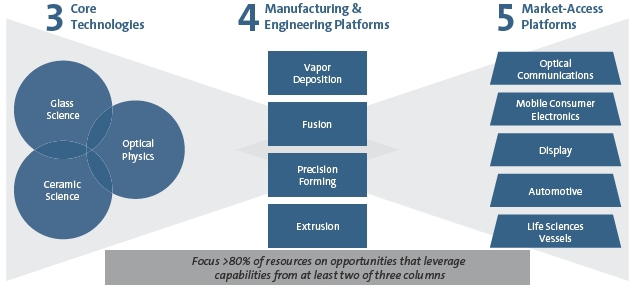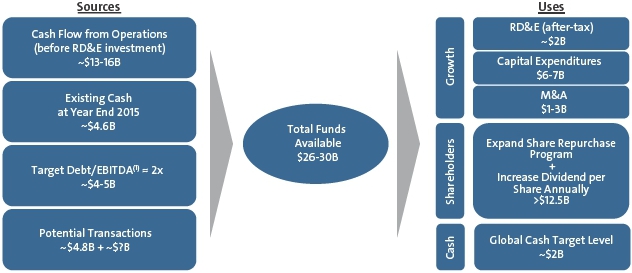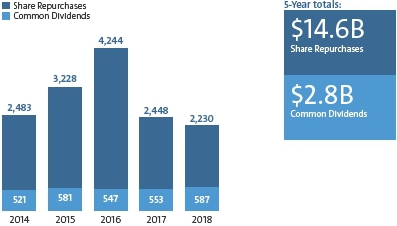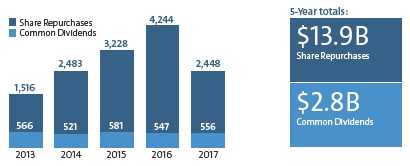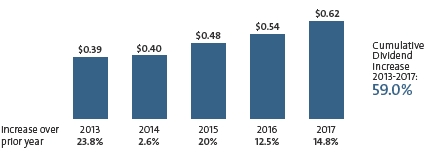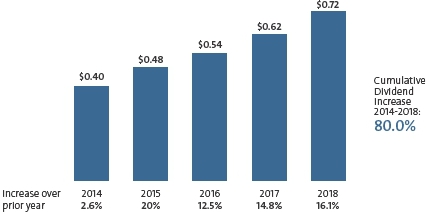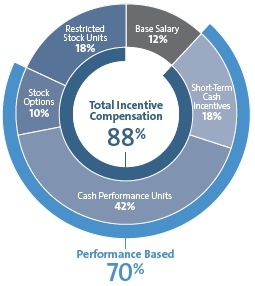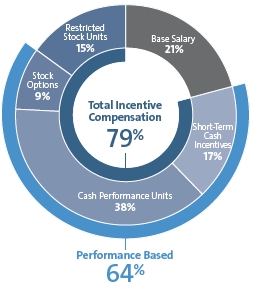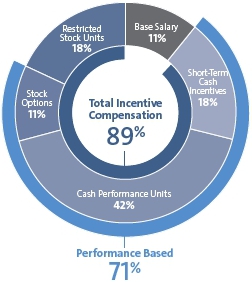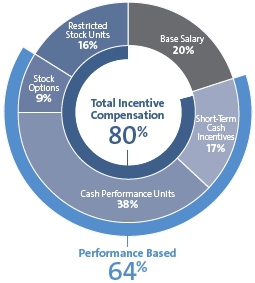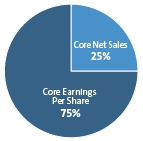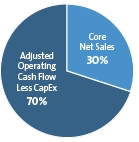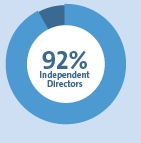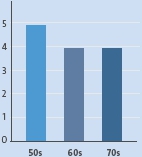| 16 | The Lead Independent Director’s regular duties include: CORNING●presiding at all meetings at which the Chair is not present, including executive sessions of the independent directors (which are held at every Board meeting);
●leading the Board’s oversight of Corning’s Strategy and Capital Allocation Framework;
●facilitating regular CEO performance reviews and ongoing management succession planning reviews;
●participating in conversations with the Company’s shareholders;
●serving as liaison between the Chair and the independent directors;
●approving Board meeting agendas and schedules;
●approving the type of information to be provided to directors for Board meetings;
●calling meetings of the independent directors when necessary and appropriate; and
●performing such other duties as the Board may from time to time designate.
|
Our current Lead Independent Director, Richard T. Clark, performs the following additional duties:
●meeting with the CEO after regularly scheduled Board meetings to provide feedback on the independent directors’ deliberations; and
●regularly speaking with the CEO between Board meetings to discuss matters of concern, often following consultation with other independent directors.
| |
16 | CORNING20182019 PROXY STATEMENT |
Table of Contents Corporate Governance and the Board of Directors CommitteesPracticeAs
| | Description | | ISG Principle 5: Board should adopt structures and practices that enhance their effectiveness | | Independence | | Our Corporate Governance Guidelines require a substantial majority of the dateour directors to be independent. Currently, all directors but one (or 93%) are independent. Except for our Executive Committee, each of this proxy statement,our Board committees consists entirely of independent directors. See page 21. | | Skills and qualifications | | Our Board is composed of accomplished professionals with broad perspectives, skills, experiences, and knowledge relevant to our business, resulting in a high-functioning and engaged Board. A matrix of relevant skills can be found on page 29. | | Commitment to Diversity | | The Committee seeks to achieve diversity within the Board has 13 directors and adheres to the Company’s anti-discrimination policies. Accordingly, the Committee is committed to actively seeking out highly qualified women and minority candidates, as well as candidates with diverse backgrounds, skills and experiences, to include in the pool from which Board nominees are chosen. See page 23. | | Director tenure | | The current average tenure of members of our Board, excluding our CEO Mr. Weeks, is 8.2 years. Our director retirement policy requires a director to retire at the annual meeting of shareholders following six committees: (1) Audit Committee; (2) Compensation Committee; (3) Corporate Relations Committee; (4) Executive Committee; (5) Finance Committee; and (6)the director’s 74th birthday. The Board, upon a recommendation of the Nominating and Corporate Governance Committee. EachCommittee, may waive this limitation for any Director if the Board determines that it is in the best interests of the committees operates underCompany. In addition, a written charter adopteddirector is required to submit an offer of resignation for consideration by the Board except the Executive Committee, which operates pursuant to Corning’s by-laws. The committee charters and the by-laws are available on our website at https://www.corning.com/worldwide/en/about-us/investor-relations/board-download-library.html. Each committee reviews and reassesses the adequacy of their charter annually, conducts annual evaluations of their performance with respect to their duties and responsibilities as laid outupon any significant change in the charter,director’s principal employment or responsibilities. See page 22. | | Director overboarding | | Corning values director participation on other public company boards as a means of adding rigor to our governance and reports regularlyrisk oversight practices. However, we have a policy to help provide confidence that each of our directors can dedicate the meaningful amount of time necessary to be a highly effective member of the Corning Board. Absent review and approval by the Nominating and Corporate Governance Committee, a non-employee director may serve on no more than four other public company boards and an employee director may serve on no more than two other public company boards. | Board with respect to the committee’s activities. Additionally, theand committee evaluations | | The Board and each committee conducts an annual review of the committees has the authority to retain outside advisors as the Board and/or each committee deems necessary.Director membership on committees of Corning’s Board is set forth in the following table. “C” denotesits effectiveness. The Chair of the committee.
|  |  |  |  |  |  |  |  |  |  |  |  |  | | Meeting attendance | | Directors attended 99% of combined total Board and applicable committee meetings in 2018, and all then-sitting directors attended the annual meeting. See page 26. | | ISG Principle 6: Boards should develop management incentive structures that are aligned with the long-term strategy of the company | | Robust stock ownership guidelines | | We require robust stock ownership for directors (5x annual cash retainer), CEO (6x base salary), other NEOs (3x base salary) and non-NEO senior management (1.5x base salary).See page 40. | | Shareholder support for executive compensation | | Corning’s executive compensation program received 90% shareholder support in 2018. | | Compensation Committee oversight of executive compensation | | The Compensation Committee annually reviews and approves incentive program design, goals and objectives for alignment with compensation and business strategies. | | Long- and short-term goals drive executive compensation | | Annual and long-term incentive programs are designed to reward financial and operational performance in support of Corning’s Strategy and Capital Allocation Framework, a topic on which management regularly engages shareholders, and which has resulted in a significant increase (95%) in shareholder value since its inception. | | Clear communication of economic drivers of executive compensation | | The proxy statement clearly communicates the link between management incentive plans and the Company’s short and long-term performance, and the success of the Company’s Strategy and Capital Allocation Framework in particular. | Board Committees | | | | | | | | | | | | | | Audit | g | g | | | | g | g | C | | g | | | g | Compensation | | | | g | | | | g | | C | g | | | Corporate Relations | | C | | | | g | | | g | | | | | Executive | | | g | g | g | | | g | | | g | C | | Finance | g | | g | | C | | g | | | | | | g | Nominating and Corporate Governance | | | g | g | g | | | | g | | C | | |
The committees and their functions are as follows:
Committee | | Primary Responsibilities | Audit(1)
Number of Meetings
in 2017: 10
| | ●Assists the Board of Directors in its oversight of (i) the integrity of Corning’s financial statements, (ii) the independent registered public accounting firm and (iii) Corning’s compliance with legal and regulatory requirements
●Approves the appointment of Corning’s independent registered public accounting firm, oversees the firm’s qualifications, independence and performance, and determines the appropriateness of fees for the firm
●Reviews the effectiveness of Corning’s internal control over financial reporting, including disclosure controls and procedures
●Reviews the results of Corning’s annual audit and quarterly and annual financial statements
●Regularly reviews our enterprise risk management program; monitors legal and regulatory risks by regular discussions with management; evaluates potential risks related to accounting, internal control over financial reporting, tax planning and cybersecurity
|
CORNING2018| CORNING2019 PROXY STATEMENT | 17 |
Table of Contents Corporate Governance and the Board of Directors Committee | | Primary Responsibilities | Compensation(2)
Board Leadership Structure The Board regularly considers the issue of board leadership in committee meetings and executive sessions of the independent directors. As the Board reviews its leadership structure, it considers a variety of factors, with a particular focus on those described on page 29. If the Chair and CEO roles are combined, our Corporate Governance Guidelines require that the independent directors annually appoint an independent director to serve as Lead Independent Director. The Lead Independent Director has significant authority and responsibilities with respect to the operation of the Board, as described below under the heading “Lead Independent Director.” The Company believes that a Lead Independent Director effectively promotes strong Board governance and oversight. The Company’s Corporate Governance Guidelines provide that the Board must annually review whether the role of Chairman should be a non-executive position or combined with that of the CEO. Early in 2019, the Board determined that, at the present time, a combined Chairman and CEO supplemented by a strong Lead Independent Director continues to provide appropriate leadership and oversight and ensures effective functioning of management and the Company. Richard T. Clark was re-appointed, effective February 6, 2019, to the role of Lead Independent Director of the Board by the independent directors. Number of Meetings
in 2017: 6 | | ●Establishes Corning’s goals and objectives with respect to executive compensation
●Evaluates the CEO’s performance in light of Corning’s goals and objectives
●Determines and approves compensation for the CEO and other Company officers
●Recommends to the Board the compensation arrangements for non-management directors
●Oversees Corning’s equity compensation plans and makes recommendations to the Board regarding incentive plans
●Monitors potential risks related to the design and administration of compensation plans and policies, and benefits and perquisites plans and policies, including performance-based compensation programs, to promote appropriate incentives in line with shareholder interest that do not promote excessive risk-takingLead Independent Director Our Lead Independent Director is appointed annually by the independent directors. The Lead Independent Director’s regular duties include: ●presiding at all meetings at which the Chair is not present, including executive sessions of the independent directors (which are held at every Board meeting);
●leading the Board’s oversight of Corning’s Strategy and Capital Allocation Framework;
●facilitating regular CEO performance reviews and ongoing management succession planning reviews;
●participating in conversations with the Company’s shareholders;
●serving as liaison between the Chair and the independent directors;
●approving Board meeting agendas and schedules;
●approving the type of information to be provided to directors for Board meetings;
●calling meetings of the independent directors when necessary and appropriate; and
●performing such other duties as the Board may from time to time designate.
Our current Lead Independent Director, Richard T. Clark, performs the following additional duties: ●meeting with the CEO after regularly scheduled Board meetings to provide feedback on the independent directors’ deliberations; and
●regularly speaking with the CEO between Board meetings to discuss matters of concern, often following consultation with other independent directors. |
Corporate
|
RelationsNumber of Meetings
in 2017: 5
| | ●Assists the Board in fulfilling its oversight responsibility by reviewing Corning’s strategies and policies in, and overseeing risks related to, the areas of public relations and reputation, employment policy and employee relations, political activities, public policy, community responsibility, and environmental and social matters. These areas include:
-Corporate identity, investor relations, media relations, and product liability
-Safety and health policies; code of conduct; values; human resource and industrial relations strategies; and internal communications strategies
-Political activities and relationships with significant governmental agencies in the countries in which the Company operates
-Environmental policies, charitable contribution strategies, and significant projects undertaken to improve communities where Corning has significant operations and employees
| Executive
Number of Meetings
in 2017: 3
| | ●Serves primarily as a means of taking action requiring Board approval between regularly scheduled meetings of the Board, and is authorized to act for the full Board on matters other than those items specifically reserved by New York law to the Board
| Finance
Number of Meetings
in 2017: 5
| | ●Reviews all potential material transactions, including mergers, acquisitions, divestitures and investments in third parties
●Reviews capital expenditure plans and capital projects
●Monitors Corning’s short- and long-term liquidity
●Reviews Corning’s tax position and strategy
●Reviews and recommends for approval by the Board Corning’s Strategy and Capital Allocation Framework, declaration of dividends, stock repurchase programs, and short- and long-term financing transactions
●Monitors strategic risks related to financial affairs, including capital structure and liquidity risk, transaction execution risk, credit and counterparty risk, market risk, insurance risk, and foreign exchange risk; reviews the policies and strategies for managing financial exposure and contingent liabilities
|
18 | CORNING2018| 18 | CORNING2019 PROXY STATEMENT |
Table of Contents Corporate Governance and the Board of Directors Committees As of the date of this proxy statement, the Board has 14 directors and the following six committees: (1) Audit Committee; (2) Compensation Committee; (3) Corporate Relations Committee; (4) Executive Committee; (5) Finance Committee; and (6) Nominating and Corporate Governance Committee. Each of the committees operates under a written charter adopted by the Board except the Executive Committee, which operates pursuant to Corning’s by-laws. The committee charters and the by-laws are available on our website at investor.corning.com/investor-relations/governance/overview/default.aspx. Each committee reviews and reassesses the adequacy of their charter annually, conducts annual evaluations of their performance with respect to their duties and responsibilities as laid out in the charter, and reports regularly to the Board with respect to the committee’s activities. Additionally, the Board and each of the committees has the authority to retain outside advisors as the Board and/or each committee deems necessary. Director membership on committees of Corning’s Board is set forth in the following table. “C” denotes Chair of the committee. The committees and their functions are as follows: Number of Meetings
in 2017: 5
| ●Determines the criteria for selecting and assessing director nominees, identifies individuals qualified to become Board members, reviews candidates recommended by shareholders, and recommends to the Board director nominees to be proposed for election at the annual meeting of shareholders
●Monitors significant developments in the regulation and practice of corporate governance
●Monitors potential risks related to governance practices by reviewing succession plans and performance evaluations of the Board and CEO, monitoring legal developments and trends regarding corporate governance practices, and evaluating related party transactions
●Assists the Board in assessing the independence of directors and reviews transactions between Corning and related persons that are required to be disclosed in our filings with the SEC
●Identifies Board members to be assigned to the various committees
●Oversees and assists the Board in the review of the Board’s performance
●Reviews activities of Board members and senior executives for potential conflicts of interest| Committee | | Primary Responsibilities | Audit(1) Number of Meetings
in 2018: 10 | | ●Assists the Board of Directors in its oversight of (i) the integrity of Corning’s financial statements, (ii) the independent registered public accounting firm and (iii) Corning’s compliance with legal and regulatory requirements ●Approves the appointment of Corning’s independent registered public accounting firm, oversees the firm’s qualifications, independence and performance, and determines the appropriateness of fees for the firm ●Reviews the effectiveness of Corning’s internal control over financial reporting, including disclosure controls and procedures ●Reviews the results of Corning’s annual audit and quarterly and annual financial statements ●Regularly reviews our enterprise risk management program; monitors legal and regulatory risks by regular discussions with management; evaluates potential risks related to accounting, internal control over financial reporting, tax planning and cybersecurity |
(1) | The Board of Directors has determined that each member of the Audit Committee satisfies the applicable audit committee independence requirements of the New York Stock Exchange (NYSE) and the SEC. The Board also determined that each member of our Audit Committee is financially literate and Mr. Landgraf, Mr. Blair, Dr. Burns and Dr. Wrighton are “audit committee financial experts” within the meaning of the applicable SEC rules.
| (2) | The Board of Directors has determined that each member of the Compensation Committee satisfies the applicable compensation committee independence requirements of the NYSE and the SEC.
| (3) | The Board of Directors has determined that each member of the Nominating and Corporate Governance Committee satisfies the applicable nominating committee independence requirements of the NYSE.
|
Director IndependenceCORNING
Our Board is 92% independent and such independent oversight bolsters our success. Our Board has determined that each of our non-employee directors qualifies as “independent” in accordance with the listing requirements of the NYSE, applicable SEC rules and the Company’s director qualification standards. Mr. Weeks is not independent because he is an executive officer of Corning.
The NYSE listing requirements state that no director may be qualified as “independent” unless our Board affirmatively determines that the director has no material relationship with Corning. When making independence determinations, the Board considers all relevant facts and circumstances which might bar a director from being determined to be “independent”, including the NYSE criteria.
Our Corporate Governance Guidelines require the Board to make an annual determination regarding the independence of each of our directors. In making its independence determinations, the Board considered transactions, if any, that occurred since the beginning of 2015 between Corning and entities associated with our independent directors or members of their immediate family.
In making director independence determinations, the Board reviewed and discussed information with regard to each director’s business and personal activities as they may relate to Corning and Corning’s management. In making its independence determinations, the Board considered that each of Mr. Cummings, Mr. Martin, Ms. Henretta and Drs. Huttenlocher and Wrighton is or were, during the previous three years, an employee of a company or organization that had a business relationship with Corning at some time during those years. The Board also considered that Corning’s business relationships with each such company or organization were ordinary course/arm’s length dealings, no Corning director had a personal interest in, or received a personal benefit from, such relationships, and any payments or contributions to or from each of these entities constituted less than the greater of $1 million, or 2% of such entities’ consolidated gross revenues in each of those years.
CORNING20182019 PROXY STATEMENT | 19 |
Table of Contents Corporate Governance and the Board of Directors | Committee | | Primary Responsibilities | In determining that eachCompensation(2)
Number of the relationships set forth above is not material, the Board considered the following additional facts: that such relationships arise only from such director’s position as an employee of the relevant company with which Corning does business; that such director has no direct or indirect material interest Meetings
in any of the business relationships or transactions; that such director had no role or financial interest in any decisions about any of these relationships or transactions;2018: 6 | | ●Establishes Corning’s goals and that such a relationship does not bar independence under the NYSE listing requirements, applicable SEC rules or Corning’s director qualification standards.Based on all of the relevant facts and circumstances, the Board concluded that none of the director relationships mentioned above constituted a material relationship with Corning that represents a potential conflict of interest, or otherwise interferes with the exercise by any of these directors of his or her independent judgmentobjectives with respect to Corning.executive compensation
●Evaluates the CEO’s performance in light of Corning’s goals and objectives ●Determines and approves compensation for the CEO and other Company officers ●Recommends to the Board the compensation arrangements for non-management directors ●Oversees Corning’s equity compensation plans and makes recommendations to the Board regarding incentive plans ●Monitors potential risks related to the design and administration of compensation plans and policies, and benefits and perquisites plans and policies, including performance-based compensation programs, to promote appropriate incentives in line with shareholder interest that do not promote excessive risk-taking | Corporate
Relations Number of Meetings
in 2018: 5 | | ●Assists the Board in fulfilling its oversight responsibility by reviewing Corning’s strategies and policies in, and overseeing risks related to, the areas of public relations and reputation, employment policy and employee relations, political activities, public policy, community responsibility, and environmental and social matters. These areas include: -Corporate identity, investor relations, media relations (including social media), crisis communications, and product liability -Safety and health policies; code of conduct; values; diversity and inclusion, Company values, human rights and labor matters, and compliance -Political and lobbying activities, and relationships with significant governmental agencies in the countries in which the Company operates -Environmental policies, sustainable development, energy and water management policies -Charitable contribution strategies, and significant projects undertaken to improve communities within which the company has significant operations and employment | PolicyExecutive
Number of Meetings
in 2018: 4 | | ●Serves primarily as a means of taking action requiring Board approval between regularly scheduled meetings of the Board, and is authorized to act for the full Board on Transactionsmatters other than those items specifically reserved by New York law to the Board | Finance Number of Meetings
in 2018: 6 | | ●Reviews all potential material transactions, including mergers, acquisitions, divestitures and investments in third parties ●Reviews capital expenditure plans and capital projects ●Monitors Corning’s short- and long-term liquidity ●Reviews Corning’s tax position and strategy ●Reviews and recommends for approval by the Board declaration of dividends, stock repurchase programs, and short- and long-term financing transactions ●Monitors strategic risks related to financial affairs, including capital structure and liquidity risk, transaction execution risk, credit and counterparty risk, market risk, insurance risk, and foreign exchange risk; reviews the policies and strategies for managing financial exposure and contingent liabilities |
| 20 | CORNING2019 PROXY STATEMENT |
Table of Contents Corporate Governance and the Board of Directors | Committee | | Primary Responsibilities | Nominating and
Corporate
Governance(3) Number of Meetings
in 2018: 5 | | ●Determines the criteria for selecting and assessing director nominees, identifies individuals qualified to become Board members, reviews candidates recommended by shareholders, and recommends to the Board director nominees to be proposed for election at the annual meeting of shareholders ●Monitors significant developments in the regulation and practice of corporate governance ●Monitors potential risks related to governance practices by reviewing succession plans and performance evaluations of the Board and CEO, monitoring legal developments and trends regarding corporate governance practices, and evaluating related party transactions ●Assists the Board in assessing the independence of directors and reviews transactions between Corning and related persons that are required to be disclosed in our filings with Related Personsthe SEC ●Identifies Board members to be assigned to the various committees ●Oversees and assists the Board in the review of the Board’s performance ●Reviews activities of Board members and senior executives for potential conflicts of interest |
| (1) | The Board of Directors has a policy requiringdetermined that each member of the fullAudit Committee satisfies the applicable audit committee independence requirements of the New York Stock Exchange (NYSE) and the SEC. The Board or a designated Board committee to approve or ratify any transaction involving Corning in which onealso determined that each member of our directors, nominees for director, executive officers, or greater than 5% shareholders, or their immediate family members, have a direct or indirect material interestAudit Committee is financially literate and whereMr. Landgraf, Mr. Blair, Mr. Brun, Dr. Burns and Dr. Wrighton are “audit committee financial experts” within the amount involved exceeds $120,000 in any fiscal year. meaning of the applicable SEC rules. | | (2) | The Board of Directors has delegated todetermined that each member of the Compensation Committee satisfies the applicable compensation committee independence requirements of the NYSE and the SEC. | | (3) | The Board of Directors has determined that each member of the Nominating and Corporate Governance Committee satisfies the responsibility for reviewing and approving any such transactions. In determining whether to approve or ratify any such transaction, the Board or relevantapplicable nominating committee must consider, in addition to other factors deemed appropriate, whether the transaction is on terms no less favorable to Corning than transactions involving unrelated parties. No director may participate in any review, approval or ratification of any transaction if he or she, or his or her immediate family member, has a direct or indirect material interest in the transaction.
We did not have any transactions requiring review and approval in accordance with this policy during 2017.
Compensation Committee Interlocks and Insider Participation
No memberindependence requirements of the Compensation Committee is now, or has ever been, an officer or employee of Corning. No member of the Compensation Committee had any relationship with Corning or any of its subsidiaries during 2017 pursuant to which disclosure would be required under applicable rules of the SEC pertaining to the disclosure of transactions with related persons. No Corning executive officer currently serves or served during 2017NYSE.
|
Director Independence Our Board is 93% independent and such independent oversight bolsters our success. Our Board has determined that each of our non-employee directors qualifies as “independent” in accordance with the listing requirements of the NYSE, applicable SEC rules and the Company’s director qualification standards. Mr. Weeks is not independent because he is an executive officer of Corning. The NYSE listing requirements state that no director may be qualified as “independent” unless our Board affirmatively determines that the director has no material relationship with Corning. When making independence determinations, the Board considers all relevant facts and circumstances which might bar a director from being determined to be “independent”, including the NYSE criteria. Our Corporate Governance Guidelines require the Board to make an annual determination regarding the independence of each of our directors. In making its independence determinations, the Board considered transactions, if any, that occurred since the beginning of 2016 between Corning and entities associated with our independent directors or members of their immediate family. The Board also reviewed and discussed information with regard to each director’s business and personal activities as they may relate to Corning and Corning’s management. It considered that each of Mr. Martin, Ms. Henretta and Drs. Huttenlocher and Wrighton is or were, during the previous three years, an employee of a company or organization that had a business relationship with Corning at some time during those years. The Board also considered: that Corning’s business relationships with each such company or organization were ordinary course/arm’s length dealings; no Corning director had a personal interest in, or received a personal benefit from, such relationships; any payments or contributions to or from each of these entities constituted less than the greater of $1 million, or 2% of such entity’s consolidated gross revenues in each of those years; that such relationships arise only from such director’s position as an employee of the relevant company with which Corning does business; that such director has no input or direct or indirect material interest in any of the business relationships or transactions; that such director had no role or financial interest in any decisions about any of these relationships or transactions; and that such a relationship does not bar independence under the NYSE listing requirements, applicable SEC rules or Corning’s director qualification standards. | CORNING2019 PROXY STATEMENT | 21 |
Table of Contents Corporate Governance and the Board of Directors Based on all of the relevant facts and circumstances, the Board concluded that none of the director relationships mentioned above constituted a material relationship with Corning that represents a potential conflict of interest, or otherwise interferes with the exercise by any of these directors of his or her independent judgment with respect to Corning. Policy on Transactions with Related Persons The Board of Directors has a policy requiring the full Board or a designated Board committee to approve or ratify any transaction involving Corning in which one of our directors, nominees for director, executive officers, or greater than 5% shareholders, or their immediate family members, have a direct or indirect material interest and where the amount involved exceeds $120,000 in any fiscal year. The Board has delegated to the Nominating and Corporate Governance Committee the responsibility for reviewing and approving any such transactions. In determining whether to approve or ratify any such transaction, the Board or relevant committee must consider, in addition to other factors deemed appropriate, whether the transaction is on terms no less favorable to Corning than transactions involving unrelated parties. No director may participate in any review, approval or ratification of any transaction if he or she, or his or her immediate family member, has a direct or indirect material interest in the transaction. We did not have any transactions requiring review and approval in accordance with this policy during 2018. Compensation Committee Interlocks and Insider Participation No member of the Compensation Committee is now, or has ever been, an officer or employee of Corning. No member of the Compensation Committee had any relationship with Corning or any of its subsidiaries during 2018 pursuant to which disclosure would be required under applicable rules of the SEC pertaining to the disclosure of transactions with related persons. No Corning executive officer currently serves or served during 2018 on the board of directors or compensation committee of another company at any time during which an executive officer of such other company served on Corning’s Board or Compensation Committee. 20 | CORNING2018Board Composition and Tenure Our Board is responsible for the oversight and success of our Company. Beyond a broad range of skills and experiences, we seek to maintain an optimal mix of newer directors, who bring fresh perspectives, and longer-tenured directors, who have contributed to developing our strategy – which takes a long-term approach to innovation – and have acquired an in-depth understanding of our global organization. The result is a high-functioning and engaged Board. A supermajority of independent directors ensures robust debate and challenged opinions in the boardroom, while diversity of gender, age, ethnicity and expertise contributes to a diverse range of views. Our 14 directors include a diverse range of individuals, including three women, two African-Americans, and four directors who hold science, technology or mathematics Ph.Ds. We also have two decades of age diversity among our directors, with their ages ranging between 52 and 74 years. We also value the broad corporate governance experience of directors who serve on the boards of other public companies, which adds additional rigor to our governance and risk oversight practices. | 22 | CORNING2019 PROXY STATEMENT |
Table of Contents Corporate Governance and the Board of Directors | CHARACTERISTICS OF OUR BOARD (EXCLUDING OUR CEO) | |
5
new directors
joined the Board
in the last six years | 100%
Independent | 3
Women |
| 2
African-
Americans | Average age of
directors is
66 | Average tenure of
8.2 years |
Board Nomination and Refreshment Process When considering Board candidates, the Nominating and Corporate Governance Committee considers those factors most relevant to the Company’s needs, including related knowledge, diversity of background, and experience in areas including business, finance, accounting, science and technology, marketing, manufacturing, operations, international business, government and human capital management. The Committee assess personal qualities of leadership, character, judgment, ethics and reputation; roles and contributions valuable to the business community and the ability to act on behalf of shareholders; whether the candidate is free of conflicts and has the time required for preparation, participation and meeting attendance. In February 2019, the Committee formalized its diversity focus by approving new Corporate Governance Guidelines which state that it will actively seek out highly qualified women and minority candidates, as well as candidates with diverse backgrounds, skills and experiences, to include in the pool from which Board nominees are chosen. In the case of incumbent directors, the Nominating and Corporate Governance Committee will review such directors’ overall service to the Company during their term, including the number of meetings attended, level of participation, quality of performance, and any transactions of such directors with the Company during their term. For those potential new director candidates who appear upon first consideration to meet the Board’s selection criteria, the Nominating and Corporate Governance Committee will conduct appropriate inquiries into their background, qualifications and skills relevant to Corning’s Strategy and Capital Allocation Framework and, depending on the result of such inquiries, arrange for in-person meetings with the potential candidates. The Nominating and Corporate Governance Committee uses multiple sources for identifying director candidates, including executive search firms, its members’ own contacts, and referrals from other directors, members of management and the Company’s advisors. To maintain a pipeline for new directors, the Nominating and Corporate Governance Committee has retained the executive search firm of Spencer Stuart to help identify director prospects, perform candidate outreach, assist in reference and background checks, and provide other related services on an ongoing basis. Director candidates recommended by shareholders in the manner described on page 84 will be considered in the same manner in which the Nominating and Corporate Governance Committee evaluates candidates recommended by other sources. In addition, our by-laws permit a group of up to 20 shareholders who have owned a minimum of 3% of our outstanding capital stock for at least three years to submit director nominees for up to the greater of two directors or 20% of the board for inclusion in our proxy statement. See “How Do I Submit A Shareholder Proposal For, Or Nominate a Director For Election At, Next Year’s Annual Meeting” on page 84 of this proxy statement. | CORNING2019 PROXY STATEMENT | 23 |
Table of Contents Corporate Governance and the Board of Directors Management Succession Planning One of the Board’s primary responsibilities is ensuring that Corning has a high-performing management team in place. The Company’s CEO is supported by a Management Committee of ten senior executives that oversee the full sphere of the Company’s business, of which four are also our Named Executive Officers. The Board oversees management succession planning, with our Lead Independent Director facilitating ongoing review and Board approval of succession and management development plans for the CEO and Management Committee. The goal of this ongoing process is to maximize the pool of internal candidates able to assume top management positions with minimal business interruption. To assist the Board, the CEO annually provides an assessment of senior managers and their potential as successor CEO, as well as individuals considered potential successors to certain other senior management positions. Each member of the Management Committee annually presents to fellow Management Committee members his or her own succession planning analysis. Risk Oversight Our Board recognizes the importance of effective risk oversight in running a successful global business and in fulfilling its fiduciary responsibilities to Corning and its shareholders. While the CEO and other members of our senior leadership team are responsible for the day-to-day management of risk, our Board is responsible for oversight of the Company’s risk management program. The Board exercises this oversight responsibility directly and through its committees.  | Board Compositionof Directors
(Committee report-outs, discussions with management and annual Board review) |  | | |  |  |  |  |  | | | | | When considering Board composition,Audit Committee
Reviews our enterprise risk management program; monitors legal and regulatory risks by regular discussions with management; oversees internal and external audit; evaluates potential risks related to accounting, internal control over financial reporting, tax planning and cybersecurity, including data protection and digital.
| | | Compensation Committee
Monitors potential risks related to the design and administration of compensation plans and policies, and benefits and perquisites plans and policies, including performance-based compensation programs, to promote appropriate incentives in line with shareholder interest that do not promote excessive risk-taking. | | | Finance Committee
Monitors strategic risks related to financial affairs, including (but not limited to) capital structure and liquidity risk, transaction execution risk, credit and counterparty risk, market risk and foreign exchange risk; reviews the policies and strategies related to tax, financial exposures and contingent liabilities. | | | | | | | | | | | | | |
| | |  | Corporate Relations Committee
Monitors risks relating to public relations, reputation, employment policy and employee relations, political activity, community responsibility and environmental, social and governance matters. |  | Nominating and Corporate Governance Committee considers whether a candidate possesses skills relevant
Monitors potential risks related to the Board’sgovernance practices by reviewing succession plans and performance evaluations of its responsibilities in the oversight of a complex global business; independence; diversity of experience; and personal characteristics such as race, gender, age and cultural background. The Board does not have a specific policy regarding consideration of gender, ethnic or other diversity criteria in identifying director candidates; however, the Board, has had a longstanding commitment to,monitoring legal developments and practice of, maintaining diverse representation on the Board. The Nominatingtrends regarding corporate governance practices and Corporate Governance Committee assesses the effectiveness of its efforts at pursuing diversity through its periodic evaluation of the board’s composition. Our 13 Directors include a diverse range of individuals, including three women, one African-American, and four directors who hold science, technology or mathematics Ph.Ds. We also have two decades of age diversity among our Directors, with their ages ranging between 51 and 73 years. Our Board’s composition represents a balanced approach to director tenure, allowing the Board to benefit from the experience of longer-serving directors combined with fresh perspectives from newer directors.evaluating potential related party transactions.
Tenure
The Nominating and Corporate Governance Committee regularly considers the long-term make up of our Board of Directors and how the members of our board change over time. The Nominating and Corporate Governance Committee also considers the experience needed for our Board as our business and the markets in which we do business evolve. Our Board aims to strike a balance between the knowledge that comes from longer-term service on the Board with the new experience, ideas and energy that can come from adding directors to the Board. We believe the average tenure for our independent director nominees of approximately 8.2 years reflects the balance the Board seeks between different perspectives brought by long-serving directors and new directors.
| | Tenure | 
8.2 yrsAverage Tenure of Directors, excluding Mr. Weeks
|
CORNING2018 PROXY STATEMENT | 21 |
Table of Contents
Corporate Governance and the Board of Directors
Board Nomination and Refreshment Process
The Nominating and Corporate Governance Committee has the authority to recommend director nominees to the Board of Directors for approval. The Committee takes into account the Company’s current needs and the qualities needed for Board service, including
● | expertise and exceptional achievement in business, finance, technology or other areas relevant to Corning’s Strategy and Capital Allocation Framework; | ● | reputation, ethical character and maturity of judgment; | ● | absence of conflicts of interest that might impede the proper performance of director responsibilities; | ● | diversity of viewpoints, backgrounds and experiences; | ● | independence under SEC and NYSE rules; | ● | service on other boards of directors; | ● | sufficient time to devote to Board matters; and, | ● | ability to work effectively and collegially with other Board members. |
In the case of incumbent directors, the Nominating and Corporate Governance Committee will review such directors’ overall service to the Company during their term, including the number of meetings attended, level of participation, quality of performance, and any transactions of such directors with the Company during their term. For those potential new director candidates who appear upon first consideration to meet the Board’s selection criteria, the Nominating and Corporate Governance Committee will conduct appropriate inquiries into their background, qualifications and skills relevant to Corning’s Strategy and Capital Allocation Framework and, depending on the result of such inquiries, arrange for in-person meetings with the potential candidates.
The Nominating and Corporate Governance Committee uses multiple sources for identifying director candidates, including executive search firms, its members’ own contacts, and referrals from other directors, members of management and the Company’s advisors. To maintain a pipeline for new directors, the Nominating and Corporate Governance Committee has retained the executive search firm of Spencer Stuart to help identify director prospects, perform candidate outreach, assist in reference and background checks, and provide other related services on an ongoing basis. Director candidates recommended by shareholders in the manner described on page 79 will be considered in the same manner in which the Nominating and Corporate Governance Committee evaluates candidates recommended by other sources. In addition, our by-laws permit a group of up to 20 shareholders who have owned a minimum of 3% of our outstanding capital stock for at least three years to submit director nominees for up to the greater of two directors or 20% of the board for inclusion in our proxy statement. See “How Do I Submit A Shareholder Proposal For, Or Nominate a Director For Election At, Next Year’s Annual Meeting” on page 79 of this proxy statement.
Management Succession Planning
One of the Board’s primary responsibilities is ensuring that Corning has a high-performing management team in place. The full Board has responsibility for management succession planning. As noted above, our Lead Independent Director facilitates the ongoing review and approval by the Board of succession and management development plans for the CEO and other senior executives to maximize the pool of internal candidates who can assume top management positions without undue interruption. To assist the Board, the CEO no less than annually provides an assessment of senior managers and their potential as successor CEO, as well as individuals considered potential successors to certain senior management positions.
22 | CORNING2018 PROXY STATEMENT |
Table of Contents
Corporate Governance and the Board of Directors
Risk Oversight
Our Board recognizes the importance of effective risk oversight in running a successful global business and in fulfilling its fiduciary responsibilities to Corning and its shareholders. While the CEO and other members of our senior leadership team are responsible for the day-to-day management of risk, our Board is responsible for oversight of the Company’s risk management. The Board exercises this oversight responsibility directly and through its committees.
 | Board of Directors
(Committee report-outs, discussions with management and annual Board review)
|  | | |  |  |  |  |  | | | | | Audit Committee
Regularly reviews our enterprise risk management program; monitors legal and regulatory risks by regular discussions with management; oversees internal and external audit; evaluates potential risks related to accounting, internal control over financial reporting, tax planning and cybersecurity.
| | | Compensation Committee
Monitors potential risks related to the design and administration of compensation plans and policies, and benefits and perquisites plans and policies, including performance-based compensation programs, to promote appropriate incentives in line with shareholder interest that do not promote excessive risk-taking.
| | | Finance Committee
Monitors strategic risks related to financial affairs, including capital structure and liquidity risk, transaction execution risk, credit and counterparty risk, market risk, insurance risk, and foreign exchange risk; reviews the policies and strategies for managing financial exposure and contingent liabilities.
| | | | | | | | | | | | | | | | | | | | | | | | | | |
Management and the Board discuss risks associated with strategic alternatives being contemplated and the risk-reward associated with these alternatives. Once a strategy is in place, at each meeting, the Board reviews our strategy with the CEO and discusses any newly-identified strategic risks.
Operationally, management reports periodically to the Board on the Company’s enterprise risk management (ERM) policies and procedures and to the Audit, Finance, and Corporate Relations Committees on our top risks. Management also provides a comprehensive annual report of top risks to the Board. Corning’s ERM program utilizes (1) a Risk Council chaired by the Senior Vice Presidentrisk exposures and Chief Financial Officer and composed of Corning management and staff to aggregate, prioritize and assess risks, including strategic, financial, operational, business, reputational, governance and managerial risks; (2) an internal audit department; and (3) a Compliance Council, which reports directly to each of the Audit Committee and Corporate Relations Committee and reviews the Company’s compliance with laws and regulations of the countries in which we conduct business.
The Board believes that the work undertaken by the committees of the Board, together with the work of the full board and the Company’s management, enables the Board to effectively oversee Corning’s management of risk.
mitigation efforts) |  |
| 24 | CORNING2019 PROXY STATEMENT |
CORNING2018 PROXY STATEMENT | 23 |
Table of Contents
Corporate Governance and the Board of Directors
Compensation Risk Analysis
In February 2018, the Committee reviewed the conclusions of a risk assessment of our compensation policies and practices covering all employees. This type of assessment is conducted annually by a cross-functional team with representatives from Human Resources, Law and Finance. The Committee evaluated the levels of risk-taking that potentially could be encouraged by our compensation arrangements, taking into account
Table of Contents Corporate Governance and the Board of Directors Management and the Board discuss risks associated with strategic alternatives being contemplated and the risk-reward associated with these alternatives. Once such a strategy is in place, at each meeting, the Board reviews it with the CEO and discusses any newly-identified strategic risks. Operationally, management reports periodically to the Board on the Company’s enterprise risk management (ERM) policies and procedures, and to the Audit, Finance, and Corporate Relations Committees on our top risks and compliance policies and practices. Management also provides a comprehensive annual report of top risks to the Board. Corning’s ERM program utilizes (1) a Risk Council chaired by the Executive Vice President and Chief Financial Officer and composed of Corning management and staff to aggregate, prioritize and assess risks, including strategic, financial, operational, business, reputational, governance and managerial risks; (2) an internal audit department; and (3) a Compliance Council, which reports directly to each of the Audit Committee and Corporate Relations Committee and reviews the Company’s compliance with laws and regulations of the countries in which we conduct business. The Board believes that the work undertaken by the committees of the Board, together with the work of the full board and the Company’s management, enables the Board to effectively oversee Corning’s management of risk. Assessment of Company Culture Directors are positioned to assess Company culture in a number of ways. The Company’s full Management Committee attends every Board meeting and numerous other members of management attend committee meetings. Formal dinners and informal lunches with attendees at the meetings provide Directors insight to how our teams function. When presenting an issue relevant to the Board, full business and technology teams attend to answer the Directors’ questions and to join them at these dinners and lunches. Once a year the Board visits our research campus to meet with dozens of employees working on our key innovation initiatives. The Board meets at different Corning locations – occasionally internationally – to see our manufacturing facilities, meet local managers and employees and explore the Company’s culture. At the Company’s annual meeting, all Company officers and their spouses are invited to attend the Board dinner and have opportunities for direct interaction. Compensation Risk Analysis In February 2019, the Committee reviewed the conclusions of a risk assessment of our compensation policies and practices covering all employees. This type of assessment is conducted annually by a cross-functional team with representatives from Human Resources (Compensation and Benefits), Law and Finance. The Committee evaluated the levels of risk-taking that potentially could be encouraged by our compensation arrangements, considering the arrangements’ risk-mitigation features, to determine whether they are appropriate in the context of our strategic plan and annual budget, our overall compensation arrangements, our compensation objectives, and Corning’s overall risk profile. Identified risk-mitigation features included the following: | ● | The mix of cash and equity payouts tied to both short-term financial performance, mid-term financial performance, and long-term value creation;
| | ● | The time vesting requirements in our long-term incentive plans, which help align the interests of employees to shareholders;
| ● | The use of multiple financial performance metrics that are readily monitored and reviewed;
| ● | The rigorous budget and goal-setting processes that involve both top-down and bottom-up analyses;
| ● | The use of common performance metrics for incentives across Corning’s management team and all eligible employees with corporate results impacting the compensation of all Corning employees;
| ● | Rigorous goal setting in our annual incentive plan that is intended to avoid imprudent risk-taking to achieve ambitious goals;
| ● | Capped payout levels for annual incentives, including sales commission plans and cash performance unit awards;
| ● | Our robust stock ownership, clawback, anti-hedging and anti-pledging policies for NEOs and other employees; and
| ● | Multiple levels of review and approval of awards, including Committee approval of all officer compensation proposals. |
The Committee concluded that Corning’s executive compensation program is balanced and does not reward excessive financial risk-taking. We believe that Corning does not use compensation policies or practices that create risks that are reasonably likely to have a material adverse effect on the Company.
Board and Shareholder Meeting Attendance
The Board of Directors met 6 times during 2017. Attendance at Board and committee meetings averaged 98% in 2017, and each incumbent director attended no less than 85% of the meetings of the Board and committees on which the director served.
All of our directors attended our 2017 Annual Meeting of Shareholders. The Board has a policy requiring all directors to attend our Annual Meeting, absent extraordinary circumstances.
Other Matters
Corning is headquartered in a small community in upstate New York. Throughout its history, the Company has routinely made contributions to civic, educational, charitable, cultural and other institutions that improve the quality of life and increase the resources of the surrounding community, making it more attractive to employees. In a small community, our employees, including executives and their families, inevitably have relationships with the non-profit organizations that receive such contributions from the Company.
The Company undertakes its philanthropic activities both directly and indirectly through The Corning Incorporated Foundation (the Foundation), a separate 501(c)3 organization. We believe in being an active corporate citizen and the Foundation directs its grant making toward the communities where Corning operates, enabling initiatives in four areas: education, culture, human services and volunteerism. In 2017, Corning donated $1 million to the Foundation, and the Foundation disbursed approximately $3.9 million, of which approximately 27% was directed toward initiatives supporting education, including grants made under the Corning Incorporated Foundation Matching Gifts program. Additional information about the Foundation can be found atwww.corningfoundation.org.
24 | CORNING2018 PROXY STATEMENT |
Table of Contents
Corporate Governance and the Board of Directors
Corning’s direct giving includes annual contributions to both local and international cultural and educational institutions. Locally, the Corning Museum of Glass (CMoG) – the world’s leading glass museum – is the largest recipient of the Company’s support. Wendell P. Weeks (chairman, CEO and president), David Morse (executive vice president and chief technology officer) and Jeffrey W. Evenson (senior vice president and chief strategy officer) serve on the CMoG board of trustees. In 2017, Corning provided cash and non-cash contributions of services to CMoG of approximately $37 million.
Corning provides financial support to the Alternative School for Math and Science (ASMS), a private middle school located in Corning, New York, with an advanced curriculum focusing on science and math. Currently, children of Corning employees represent approximately 53% of its enrollment. In 2017, non-cash contributions totaled approximately $1.5 million and cash contributions totaled $326,000. Christine M. Pambianchi, (senior vice president, Human Resources) and Kim Frock Weeks (spouse of Wendell P. Weeks, our chairman, CEO and president) serve on the ASMS board of trustees. Ms. Frock Weeks also serves as administrative head of school at ASMS, but receives no salary or benefits in this role.
Ethics and Conduct
We are committed to conducting business lawfully and ethically. Our directors, NEOs, and all Corning employees, are required to act at all times with honesty and integrity. We have a comprehensive Code of Conduct that applies to all Corning directors and employees that covers areas of professional conduct, including conflicts of interest, the protection of corporate opportunities and assets, employment policies, non-discrimination policies, confidentiality, vendor standards, and intellectual property, and requires strict adherence to all laws and regulations applicable to our business. Our Board spends meaningful time with executive management at board meetings, and other members of management at other board events, where the relationships developed enable the Board to ensure that the Company maintains a culture of integrity, responsibility and accountability throughout the organization.
We also have a supplemental “Code of Conduct for Directors and Executive Officers” that includes policies calling for strict observance of all laws applicable to our business, that requires directors and executive officers to avoid any conflict between their personal interests and the interests of employees to shareholders;
| | ● | The use of multiple financial performance metrics that are readily monitored and reviewed, and aligned with the company in dealingcorporate and business unit objectives;
| | ● | The rigorous budget and goal-setting processes that involve both top-down and bottom-up analyses;
| | ● | The use of common performance metrics for incentives across Corning’s management team and all eligible employees with suppliers, customers,corporate results impacting the compensation of all Corning employees;
| | ● | Governance committees and plan caps that are intended to avoid imprudent risk-taking;
| | ● | Our robust stock ownership, clawback, anti-hedging and anti-pledging policies for NEOs and other third parties,employees;
| | ● | Multiple levels of review and which imposes standards upon certain conductapproval of awards, including Committee approval of all officer compensation; and
| | ● | Immediate oversight of executive pay matters in their personal affairs, including transactions in securities ofmergers and acquisitions and unit compensation throughout the Company, any company affiliate, or any unaffiliated organization. Each director and executive officer is expected to be familiar with and to follow these policies to the extent applicable to them. Any employee can provide an anonymous report of an actual or apparent violation of our Codes of Conduct. We will disclose any future amendments to, or waivers from, any provision of our Codes of Conduct involving our directors, our principal executive officer, principal financial officer, principal accounting officer, controller or other persons performing similar functions on our website within four business days following the date of any such amendment or waiver. No such waivers were sought or granted in 2017.acquisition integration process. |
The Committee concluded that Corning’s executive compensation program is balanced and does not reward excessive financial risk-taking. We believe that Corning does not use compensation policies or practices that create risks that are likely to have a material adverse effect on the Company. Lobbying and Political Contributions PolicyCorning encourages employees to participate in the political process on a personal basis. However, any use of Corning funds, property, resources or employee work time for U.S. political purposes — for example, to any U.S. political party, candidate or government official – is subject to Corning’s Lobbying and Political Contributions Policy and must be approved in advance by Corning’s Government Affairs office. Any contact with members of the U.S. Congress on behalf of Corning, or any Corning contribution to U.S. government officials or payment related to these officials, must be approved by and coordinated through Corning’s Government Affairs office. Our policy can be found atCORNINGwww.corning.com/political-contributions2019 PROXY STATEMENT .
| 25 |
Table of Contents Corporate Governance and the Board of Directors Board and Shareholder Meeting Attendance The Board of Directors met in person five times during 2018. Attendance at Board and committee meetings averaged 99% in 2018, and each incumbent director attended no less than 90% of the meetings of the Board and committees on which the director served. All of our directors attended our 2018 Annual Meeting of Shareholders except for Mr. Brun, who became a director in July 2018. The Board has a policy requiring all directors to attend our Annual Meeting, absent extraordinary circumstances. Ethics and Conduct We are committed to conducting business lawfully and ethically. Our directors, NEOs, and all Corning employees, are required to act at all times with honesty and integrity. We have a comprehensive Code of Conduct that applies to all Corning directors and employees that covers areas of professional conduct, including conflicts of interest, the protection of corporate opportunities and assets, employment policies, non-discrimination policies, confidentiality, vendor standards, and intellectual property, and requires strict adherence to all laws and regulations applicable to our business. Our Board spends meaningful time with executive management at board meetings, and other members of management at other board events, where the relationships developed enable the Board to ensure that the Company maintains a culture of integrity, responsibility and accountability throughout the organization. We also have a supplemental “Code of Conduct for Directors and Executive Officers” that includes policies calling for strict observance of all laws applicable to our business, that requires directors and executive officers to avoid any conflict between their personal interests and the interests of the company in dealing with suppliers, customers, and other third parties, and which imposes standards upon certain conduct in their personal affairs, including transactions in securities of the Company, any company affiliate, or any unaffiliated organization. Each director and executive officer is expected to be familiar with and to follow these policies to the extent applicable to them. Any employee can provide an anonymous report of an actual or apparent violation of our Codes of Conduct. We will disclose any future amendments to, or waivers from, any provision of our Codes of Conduct involving our directors, our principal executive officer, principal financial officer, principal accounting officer, controller or other persons performing similar functions on our website within four business days following the date of any such amendment or waiver. No such waivers were sought or granted in 2018. Lobbying and Political Contributions Policy Corning encourages employees to participate in the political process on a personal basis. However, any use of Corning funds, property, resources or employee work time for U.S. political purposes — for example, to any U.S. political party, candidate or government official – is subject to Corning’s Lobbying and Political Contributions Policy and must be approved in advance by Corning’s Government Affairs office. Any contact with members of the U.S. Congress on behalf of Corning, or any Corning contribution to U.S. government officials or payment related to these officials, must be approved by and coordinated through Corning’s Government Affairs office. Our policy can be found atcorning.com/political-contributions. Communications with Directors Shareholders and interested parties may communicate concerns to any director, committee member or the Board by writing to the following address: Corning Incorporated Board of Directors, Corning Incorporated, One Riverfront Plaza, Corning, New York 14831, Attention: Corporate Secretary. Please specify to whom your correspondence should be directed. The Board has instructed our Corporate Secretary to review correspondence directed to the Board and, at the Corporate Secretary’s discretion, to forward items that are appropriate for the Board’s consideration. | 26 | CORNING2018 PROXY STATEMENT | 25 |
Table of Contents
Corporate Governance and the Board of Directors
Corporate Governance Materials Available on Corning’s Website
In addition to our Corporate Governance Guidelines and Director Qualification Standards, other information relating to Corning’s corporate governance is available on the Investor Relations – Governance – Downloads section of our website athttps://www.corning.com/worldwide/en/about-us/investor-relations/board-download-library.html including:
● | Audit Committee Charter
| ● | Compensation Committee Charter
| ● | Corporate Relations Committee Charter
| ● | Finance Committee Charter
| ● | Nominating and Corporate Governance Committee Charter
| ● | Code of Conduct for Directors and Executive Officers
| ● | Code of Ethics for Chief Executive Officer and Financial Executives
| ● | Corning Incorporated By-Laws
| ● | Our Code of Conduct
| ● | Political Contributions and Lobbying Policy
| ● | Whistleblower Policy |
26 | CORNING20182019 PROXY STATEMENT |
Table of Contents Corporate Governance and the Board of Directors Corporate Governance Materials Available on Corning’s Website In addition to our Corporate Governance Guidelines and Director Qualification Standards, other information relating to Corning’s corporate governance is available on the Investor Relations – Governance – Downloads section of our website atinvestor.corning.com/investor-relations/governance/overview/default.aspx including: | ● | Corporate Governance Guidelines with Director Qualification Standards
| | ● | Corning Incorporated By-Laws
| | ● | Political Contributions and Lobbying Policy
| | ● | Whistleblower Policy
| | ● | Code of Conduct for Directors and Executive Officers
| | ● | Code of Ethics for Chief Executive Officer and Financial Executives
| | ● | Our Code of Conduct
| | ● | Audit Committee Charter
| | ● | Compensation Committee Charter
| | ● | Corporate Relations Committee Charter
| | ● | Finance Committee Charter
| | ● | Nominating and Corporate Governance Committee Charter |
Corning’s Human Rights Policy is available athttp://www.corning.com/worldwide/en/sustainability/people/human-rights-policy.html. | CORNING2019 PROXY STATEMENT | 27 |
Table of Contents Election of Directors
| |  |
BoardElection of Directors’ Qualifications and ExperienceDirectors
Our Board is composed of accomplished professionals with diverse skills and areas of expertise. The broad range of skills, knowledge, and opinions represented on our Board is one of its core strengths. Moreover, we believe our directors’ wide range of professional experiences and backgrounds, education, and skills has proved to be of significant value to the Company, and we intend to continue leveraging this strength.
The following table describes key competencies and skills of our directors.
All directors other than Mr. Weeks are independent. Mr. Clark is the Lead Independent Director.
Board of Directors’ Qualifications and Experience Our Board is composed of accomplished professionals with diverse skills and areas of expertise. The broad range of skills, knowledge, and opinions represented on our Board is one of its core strengths. Moreover, we believe our directors’ wide range of professional experiences and backgrounds, education, and skills provides significant value to the Company, and we intend to continue leveraging this strength. Upon the recommendation of the Nominating and Corporate Governance Committee, the Board of Directors granted Mr. Canning a one-time waiver of the mandatory retirement age policy on February 6, 2019. The Board concluded that Mr. Canning’s experience and skill set, in particular his broad financial experience and ongoing contributions in furtherance of the Strategy and Capital Allocation Framework, were exceptionally beneficial to the Company and that Mr. Canning’s continued service was in the best interest of the Company through the Framework’s conclusion. The following table describes key competencies and skills of our directors. All directors other than Mr. Weeks are independent. Mr. Clark is the Lead Independent Director. | 28 | CORNING2019 PROXY STATEMENTThese directors have CEO or other senior officer experience, and a demonstrated record of leadership qualities, which includes a practical understanding of organizations, processes, strategy, risk and risk management and methods to drive change and growth. | g | g | g | g | g | g | g | g | g | g | g | g | g | Industry Experience
These directors have experience in or directly relevant to our businesses, which fosters active participation in developing and implementing our operating plan and business strategy. They have valuable perspectives on issues specific to Corning’s business.
| | g | g | g | | | g | g | g | g | g | g | | Financial, Investment, and/or Banking Experience
These directors possess an acute understanding of finance and financial reporting processes. Accurate financial reporting and robust auditing are critical to Corning’s success.
| g | g | g | g | g | | g | g | | | | g | g | Academia, R&D, and Innovation
These directors have advanced degrees in relevant fields and exceptionally deep knowledge of technology and research & development in areas critical to Corning as a science, technology, and innovation company.
| | g | | | | | g | | | g | | | g | Entrepreneurial/Commercial Experience
These directors provide valuable perspectives on developing and investing in new technologies
| | g | | g | | g | g | g | | g | g | g | g | International Experience
Corning’s future success depends, in part, on our ability to grow our businesses outside the United States. Our directors with global business or international experience provide valued perspective on our operations.
| g | g | | g | | g | | g | | | | g | g | Law, Government, or Regulatory Experience
Legal, government and regulatory experience is relevant to Corning as industry regulations can be critical to the financial welfare and growth of our various businesses.
| | | g | g | | g | | g | g | | g | g | | Audit Committee Financial Expert
These directors qualify as audit committee financial experts as defined by applicable SEC rules.
| g | g | | | | | | g | | | | | g | Public Company Board Experience
These directors have extensive experience as members of the board of directors of at least two other public companies.
| | g | g | g | g | g | | g | | g | g | g | g | Military Service
These directors have experience as a member of the United States armed forces.
| | | | g | | | | g | | | g | | |
CORNING2018 PROXY STATEMENT | 27 |
Table of Contents Proposal 1Election of Directors |  |  |  |  |  |  |  |  |  |  |  |  |  |  | After consideringLeadership
These directors have CEO or other senior executive experience, and a demonstrated record of leadership qualities, which includes a practical understanding of organizations, processes, strategy, risk and risk management and methods to drive change and growth.
| ⬛ | ⬛ | ⬛ | ⬛ | ⬛ | ⬛ | ⬛ | ⬛ | ⬛ | ⬛ | ⬛ | ⬛ | ⬛ | ⬛ | Industry Experience
These directors have experience in or directly relevant to our businesses, which fosters active participation in developing and implementing our operating plan and business strategy. They have valuable perspectives on issues specific to Corning’s business. | | ⬛ | ⬛ | ⬛ | ⬛ | | | ⬛ | ⬛ | ⬛ | ⬛ | ⬛ | ⬛ | | Financial, Investment, and/or Banking Experience
These directors possess an acute understanding of finance and financial reporting processes. Accurate financial reporting and robust auditing are critical to Corning’s success. | ⬛ | ⬛ | ⬛ | ⬛ | ⬛ | ⬛ | | ⬛ | ⬛ | | | | ⬛ | ⬛ | Academia, R&D, and Innovation
These directors have advanced degrees in relevant fields and exceptionally deep knowledge of technology and research & development in areas critical to Corning as a science, technology, and innovation company. | | | ⬛ | | | | | ⬛ | | | ⬛ | | | ⬛ | Entrepreneurial/Commercial Experience
These directors provide valuable perspectives on developing, investing in and commercializing new technologies | | | ⬛ | | ⬛ | | ⬛ | ⬛ | ⬛ | | ⬛ | ⬛ | ⬛ | ⬛ | International Experience
Corning’s future success depends, in part, on our ability to grow our businesses outside the recommendationsUnited States. Our directors with global business or international experience provide valued perspective on our operations. | ⬛ | | ⬛ | | ⬛ | | ⬛ | | ⬛ | | | | ⬛ | ⬛ | Law, Government, or Regulatory Experience
Legal, government and regulatory experience is relevant to Corning as industry regulations can be critical to the financial welfare and growth of our various businesses. | | | | ⬛ | ⬛ | | ⬛ | | ⬛ | ⬛ | | ⬛ | ⬛ | | Audit Committee Financial Expert
These directors qualify as audit committee financial experts as defined by applicable SEC rules. | ⬛ | ⬛ | ⬛ | | | | | | ⬛ | | | | | ⬛ | Public Company Board Experience
These directors have extensive experience as members of the Nominating and Corporate Governance Committee, the Board has set the numberboard of directors of at thirteen and nominated the persons described below to stand for election. All of the nominees were elected by Corning’s shareholders at the 2017 Annual Meeting and have consented to being named in this proxy statement and to serve as director if re-elected. The Board believes that each of these nominees is qualified to serve as a director of Corning in light of their respective skills and qualifications, as further described below. Equally important, the Board believes this combination of backgrounds, skills and experiences creates a Board that is well-equipped to exercise oversight responsibilities for Corning’s shareholders andleast two other stakeholders.public companies. If elected by our shareholders, the thirteen director nominees will serve for a one-year term expiring at our 2019
| | ⬛ | ⬛ | ⬛ | ⬛ | ⬛ | ⬛ | | ⬛ | | ⬛ | ⬛ | ⬛ | ⬛ |
After considering the recommendations of the Nominating and Corporate Governance Committee, the Board has set the number of directors at fourteen and nominated the persons described below to stand for election. All of the nominees were elected by Corning’s shareholders at the 2018 Annual Meeting, except for Mr. Brun who was appointed to the Board in July 2018, and have consented to being named in this proxy statement and to serve as director if re-elected. The Board believes that each of these nominees is qualified to serve as a director of Corning in light of their respective skills and qualifications, as further described below. Equally important, the Board believes this combination of backgrounds, skills and experiences creates a Board that is well-equipped to exercise oversight responsibilities for Corning’s shareholders and other stakeholders. If elected by our shareholders, the fourteen director nominees will serve for a one-year term expiring at our 2020 Annual Meeting of Shareholders. Each director will hold office until his or her successor has been elected and qualified or until the director’s earlier resignation or removal. 
 | FOR | Our Board unanimously recommends that shareholders vote FOR all of our director nominees. |
28 | CORNING2018 PROXY STATEMENT2019 PROXY STATEMENT | 29 |
Table of Contents Proposal 1Election of Directors Corning’s Director Nominees 
Age
60 Director Since
2014 Committees ●Audit ●Finance Current Public Company Directorships ●Dropbox, Inc. Public Company Directorships Held During the Past 5 Years ●None | | Donald W. Blair Retired Executive Vice President and Chief Financial Officer, NIKE, Inc. Mr. Blair was the executive vice president and chief financial officer of NIKE, Inc. from 1999 to October 2015. Prior to joining NIKE, he served fifteen years at PepsiCo, Inc. in a number of senior executive-level corporate and operating unit financial assignments, including chief financial officer roles for PepsiCo Japan (based in Tokyo) and Pepsi-Cola International’s Asia Division (based in Hong Kong). He began his career in 1981 as an accountant with Deloitte Haskins & Sells. Mr. Blair brings over 36 years of financial expertise and management experience at the international, operational, and corporate levels. He also has proven experience in developing and implementing strategies for delivering sustainable, profitable growth. Mr. Blair’s financial expertise and audit experience are valuable assets to our Finance and Audit committees. Skills and Qualifications —Expertise in finance, audit and management —Executive leadership experience —Experience in international business and finance |

Age
66 Director Since
2018 Committees ●TableAudit ●Compensation Current Public Company Directorships ●Broadridge Financial Solutions, Inc. ●CDK Global Inc. ●Merck & Co., Inc. Public Company Directorships Held During the Past 5 Years ●Automatic Data Processing, Inc. ●Hewlett Packard Enterprise Company | | Leslie A. Brun Chairman and Chief Executive Officer, Sarr Group LLC Mr. Brun is chairman and chief executive officer of ContentsSarr Group, LLC, vice chairman and senior advisor of G100 Companies and a member of the Council on Foreign Relations. He is also the founder and former chief executive officer and chairman of Hamilton Lane, where he served as chief executive officer and chairman from 1991 until 2005, a former director and chairman of the board of Automatic Data Processing, Inc., and a former director of Hewlett Packard Enterprise Company. In addition, Mr. Brun also served as a managing director and co-founder of the investment banking group of Fidelity Bank, and as a past vice president in the corporate finance division of E.F. Hutton & Co. Mr. Brun brings to the board significant financial expertise and operating and management experience, along with extensive public company directorship and committee experience. He also brings broad experience on governance issues facing large public companies. Skills and Qualifications —Expertise in finance, management, investment banking, financial advisory and management across highly regulated industries —Executive leadership experience —Extensive corporate governance and public company board experience |
| 30 | CORNING2019 PROXY STATEMENT |
Table of Contents Proposal 1Election of Directors 
Corning��s Director NomineesAge

Age
59
Director Since
2014
Committees
●Audit
●Finance
Current Public Company Directorships
●None
Public Company Directorships Held During the Past 5 Years
●None
| | Donald W. Blair
Retired Executive Vice President and Chief Financial Officer, NIKE, Inc.
Mr. Blair was the executive vice president and chief financial officer of NIKE, Inc. from 1999 to October 2015. Prior to joining NIKE, he served fifteen years at PepsiCo, Inc. in a number of senior executive-level corporate and operating unit financial assignments, including chief financial officer roles for PepsiCo Japan (based in Tokyo) and Pepsi-Cola International’s Asia Division (based in Hong Kong). He began his career in 1981 as an accountant with Deloitte Haskins & Sells.
Mr. Blair brings over 35 years of financial expertise and management experience at the international, operational, and corporate levels. He also has proven experience in developing and implementing strategies for delivering sustainable, profitable growth. Mr. Blair’s financial expertise and audit experience are valuable assets to our Finance and Audit committees.
Skills and Qualifications
—Expertise in finance, audit and management
—Executive leadership experience
—Experience in international business and finance
|

Age
6364
Director Since
2012 Committees ●Audit ●Corporate Relations (Chair) Current Public Company Directorships ●HP Inc. ●Kellogg Company Public Company Directorships Held During the Past 5 Years ●GlaxoSmithKline plc | | Stephanie A. Burns Retired Chairman and Chief Executive Officer, Dow Corning Corporation Dr. Burns has 35 years of global innovation and business leadership experience. Dr. Burns joined Dow Corning in 1983 as a researcher and specialist in organosilicon chemistry. In 1994, she became the company’s first director of women’s health. She was elected to the Dow Corning Board of Directors in 2001 and elected as president in 2003. She served as chief executive officer from 2004 until May 2011 and served as chair from 2006 until her retirement in December 2011. Dr. Burns brings significant expertise in scientific research, issues management, science and technology leadership, and business management to the Board, as well as skills related to her Ph.D. in organic chemistry. She is the past honorary president of the Society of Chemical Industry and was appointed by President Obama to the President’s Export Council. Dr. Burns is a former chair of the American Chemistry Council. Skills and Qualifications —Global innovation, manufacturing and business leadership experience —Significant expertise in research and development, science and technology leadership, and audit and business management —Significant public company board experience |
CORNING2018 PROXY STATEMENT | 29 |
Table of Contents
Proposal 1Election of Directors
 
Age
7374 Director Since
2010 Committees ●Executive ●Finance ●Nominating and Corporate Governance Current Public Company Directorships ●None Public Company Directorships Held During the Past 5 Years ●Exelon Corporation | | John A. Canning, Jr. Chairman, Madison Dearborn Partners, LLC Mr. Canning co-founded Madison Dearborn Partners, LLC in 1992, serving as its chief executive officer until he became chairman in 2007. He previously spent 24 years with First Chicago Corporation, most recently as executive vice president of The First National Bank of Chicago and president of First Chicago Venture Capital. Mr. Canning is trustee and chairman of several Chicago-area non-profit organizations. He is a former commissioner of the Irish Reserve Fund and a former director and chairman of the Federal Reserve Bank of Chicago. Mr. Canning brings over 3738 years of experience in private equity investing, including reviewing financial statements and audit results and making investment and acquisition decisions. As a former director and chairman of the Federal Reserve Bank of Chicago, he has insight into economic trends important to our business. In addition to his business experience, he also has a law degree and is a recognized leader in the Chicago business community. Mr. Canning’s experience in banking and managing investments make him a valued member of our Finance Committee. Skills and Qualifications —Sophisticated in private equity investing, including reviewing financial statements and audit results and making investment and mergers and acquisitions decisions —Applies insight into important economic trends relevant to our business —Experience in banking and managing investments |
| CORNING2019 PROXY STATEMENT | 31 |
Table of Contents Proposal 1Election of Directors  
Age
7172 Director Since
2011 Committees ●Compensation ●Executive ●Nominating and Corporate Governance Current Public Company Directorships ●Automatic Data Processing, Inc. Public Company Directorships Held During the Past 5 Years ●None | | Richard T. Clark Retired Chairman, Chief Executive Officer and President, Merck & Co., Inc.
Lead Independent Director Mr. Clark retired from Merck in 2011. He joined Merck in 1972 and held a broad range of senior management positions. He became president and chief executive officer of Merck in May 2005 and chairman of the board in April 2007. He transitioned from the chief executive officer role in January 2011 and served as Merck board chairman through November 2011. He was president of the Merck Manufacturing Division (June 2003 to May 2005) of Merck Sharp & Dohme Corp. He is chairman of the board of Project Hope and a trustee of several charitable non-profit organizations. As the former chairman, president and chief executive officer of a Fortune 100 company, Mr. Clark brings broad managerial expertise, operational expertise, and deep business knowledge, as well as a track record of achievement. Skills and Qualifications —Broad and deep managerial expertise, operational expertise, and business knowledge —Extensive experience in the issues facing public companies and multinational businesses —Significant public company board experience, including as chairman and chief executive officer of an R&D-focused global corporation |
30 | CORNING2018 PROXY STATEMENT |
Table of Contents
Proposal 1Election of Directors
 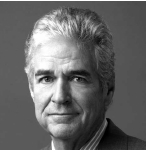
Age
6869 Director Since
2006 Committees ●Executive ●Finance (Chair) ●Nominating and Corporate Governance Current Public Company Directorships ●W. R. Grace & Co. Public Company Directorships Held During the Past 5 Years ●Viasystems Group, Inc.None | | Robert F. Cummings, Jr. Retired Vice Chairman of Investment Banking, JPMorgan Chase & Co. Mr. Cummings retired as vice chairman of Investment Banking at JPMorgan Chase & Co. (JPM) in February 2016. He had served in that role since December 2010, advising on client opportunities across sectors and industry groups. Mr. Cummings began his business career in the investment banking division of Goldman, Sachs & Co. in 1973 and was a partner of that firm from 1986 until his retirement in 1998. He served as an advisory director at Goldman Sachs until 2002. Mr. Cummings’ Board qualifications include more than 3233 years of investment banking experience at Goldman Sachs and JPM, where he advised corporate clients on financings, business development, mergers, and acquisitions, and other strategic financial issues. Additionally, he brings knowledge in the areas of technology, telecommunications, private equity, and real estate to the Board. Skills and Qualifications —Extensive investment banking experience including finance, business development, and mergers and acquisitions —Knowledgeable in the areas of technology, telecommunications, private equity and real estate
|
| 32 | CORNING2019 PROXY STATEMENT |
Table of Contents Proposal 1Election of Directors  
Age
5657 Director Since
2013 Committees ●Audit ●Corporate Relations Current Public Company Directorships ●Meritage Homes Corporation ●NiSource, Inc. ●American Eagle Outfitters, Inc. Public Company Directorships Held During the Past 5 Years ●Staples, Inc. | | Deborah A. Henretta Retired Group President of Global E-Business, Procter & Gamble Ms. Henretta has over 30 years of business leadership experience across both developed and developing markets, as well as expertise in brand building, marketing, philanthropic program development and government relations. She joined Procter & Gamble (P&G) in 1985. In 2005, she was appointed President of P&G’s business in ASEAN, Australia and India. She was appointed group president, P&G Asia in 2007, group president of P&G Global Beauty Sector in June 2013, and group president of P&G E-Business in February 2015. She retired from P&G in June 2015. Ms. Henretta was a member of Singapore’s Economic Development Board (EDB) from 2007 to 2013. She contributed to the growth strategies for Singapore, and was selected to serve on the EDB’s Economic Strategies Committee between 2009 and 2011. In 2008, she received a U.S. State Department appointment to the Asia-Pacific Economic Cooperation’s Business Advisory Council. In 2011, she was appointed chair of this 21-economy council, becoming the first woman to hold the position. In that role, she advised top government officials, including former President Barack Obama and former Secretary of State Hillary Clinton. Ms. Henretta is a partner at G100 Companies where she assisted in establishing a Board Excellence program that provides director education on board oversight and governance responsibilities, including the areas of digital transformation and cyber security.security, as well as a partnership program for New Director Training. Skills and Qualifications —Significant experience in business leadership and global and international operations P&L responsibility —Skilled in brand building, marketing and emerging market management —Significant knowledge of digital transformation and cyber security |
CORNING2018 PROXY STATEMENT | 31 |
Table of Contents
Proposal 1Election of Directors
 
Age
5960 Director Since
2015 Committees ●Audit ●Finance Current Public Company Directorships ●Amazon.com, Inc. Public Company Directorships Held During the Past 5 Years ●None | | Daniel P. Huttenlocher Dean and Vice Provost, Cornell Tech Dr. Huttenlocher is the founding dean of Cornell Tech, the technology graduate school of Cornell University located in New York City, a position he has held since 2012. In addition to positions as a professor and dean at Cornell, Dr. Huttenlocher has served as chief technology officer at Intelligent Markets, Inc. and as a principal scientist and member of the senior leadership team at the Xerox Palo Alto Research Center. Dr. Huttenlocher holds a Ph.D. in computer science and a Master of Science degree in Electrical Engineering, both from the Massachusetts Institute of Technology. He is a renowned computer science researcher and educator, and a prolific inventor with two dozen U.S. patents. He brings to the board extensive experience in technology innovation and commercialization, and expertise in developing next-generation products and services. Skills and Qualifications —Extensive experience in innovation and commercialization —Expertise in information technology and computer software —Experience with emerging technologies and customer experience |
| CORNING2019 PROXY STATEMENT | 33 |
Table of Contents Proposal 1Election of Directors  
Age
7172 Director Since
2007 Committees ●Audit (Chair) ●Compensation ●Executive Current Public Company Directorships ●Louisiana-Pacific Corporation Public Company Directorships Held During the Past 5 Years ●None | | Kurt M. Landgraf President, Washington College In July 2017, Mr. Landgraf was elected president of Washington College. He previously served as president and chief executive officer of Educational Testing Service (ETS), a private non-profit educational testing and measurement organization, from 2000 until his retirement in December 2013. Prior to that, he was executive vice president and chief operating officer of E.I. Du Pont de Nemours and Company (DuPont), where he previously held a number of senior leadership positions, including chief financial officer. Mr. Landgraf was selected for his wealth of executive management experience in public companies, non-profit entities, higher education, and government. He brings to the Board his financial expertise and operations skills and experience, represented by his positions at ETS and DuPont. Mr. Landgraf’s other areas of specialized knowledge include technology, transportation, education, finance, pharmaceuticals, health care, energy, materials, and mergers and acquisitions. Skills and Qualifications —Extensive executive management experience in public companies, non-profit entities, higher education and government —Financial and audit expertise —Operations skills and experience —Specialized knowledge including technology, transportation, education, pharmaceuticals, health care, energy, materials, and mergers and acquisitions —Significant public company board experience |
32 | CORNING2018 PROXY STATEMENT |
Table of Contents
Proposal 1Election of Directors
 
Age
5152 Director Since
2013 Committees ●Corporate Relations ●Nominating and Corporate Governance Current Public Company Directorships ●None Public Company Directorships Held During the Past 5 Years ●Xtera Communications, Inc. | | Kevin J. Martin Vice President, Mobile and Global Access Policy, Facebook, Inc. Before Mr. Martin became Vice President, Mobile and Global Access Policy at Facebook, Inc. he was a partner and co-chair of the telecommunications practice at Squire Patton Boggs, an international law firm, from 2009 to 2015, and chairman of the Federal Communications Commission (FCC) from March 2005 to January 2009. Mr. Martin has nearly two decades experience as a lawyer and policymaker in the telecommunications field. Before joining the FCC as a commissioner in 2001, Mr. Martin was a special assistant to the president for Economic Policy and served on the staff of the National Economic Council, focusing on commerce and technology policy issues. He served as the official U.S. government representative to the G-8’s Digital Opportunity Task Force. Mr. Martin brings deep experience to the board in the telecommunications, economics, governmental and legal arenas. Skills and Qualifications —Specialized knowledge of telecommunications, social media and information technology industries —Extensive knowledge of government policy and regulatory environment |
| 34 | CORNING2019 PROXY STATEMENT |
Table of Contents Proposal 1Election of Directors  
Age
6869 Director Since
1999 Committees ●Audit ●Compensation (Chair) Current Public Company Directorships ●None Public Company Directorships Held During the Past 5 Years ●Keynote Systems ●Neustar, Inc.
| | Deborah D. Rieman Retired Executive Chairman, MetaMarkets Group Dr. Rieman has more than 3031 years of experience in the software industry. In 2016, she retired as executive chairman of MetaMarkets Group. Previously, she was managing director of Equus Management Company, a private investment fund. From 1995 to 1999, she served as president and chief executive officer of Check Point Software Technologies, Incorporated. Dr. Rieman brings significant expertise in information technology, innovation and entrepreneurial endeavors to the Board and skills related to her Ph.D. in mathematics. She is also the former president and chief executive officer of a software company specializing in security and has experience in technology development, marketing, business development and support, investor relations and investing. Skills and Qualifications —Expertise in information technology and cyber security —Experience in technology development, marketing, business development and support, innovation, and entrepreneurial endeavors investor relations and investing |
CORNING2018 PROXY STATEMENT | 33 |
Table of Contents
Proposal 1Election of Directors
 
Age
7071 Director Since
2001 Committees ●Compensation ●Executive ●Nominating and Corporate Governance (Chair) Current Public Company Directorships ●Harris Corporation ●NextEra Energy, Inc. ●Ryder Systems Inc. Public Company Directorships Held During the Past 5 Years ●BBA Aviation plc.None | | Hansel E. Tookes II Retired Chairman and Chief Executive Officer, Raytheon Aircraft Company Mr. Tookes retired from Raytheon Company in December 2002. He joined Raytheon in 1999 and served as president of Raytheon International, chairman and chief executive officer of Raytheon Aircraft, and executive vice president of Raytheon Company. From 1980 to 1999, Mr. Tookes served United Technologies Corporation as president of Pratt and Whitney’s Large Military Engines Group and in a variety of other leadership positions. Mr. Tookes provides extensive experience in operations, manufacturing, performance excellence, business development, technology-driven business environments, and military and government contracting. He also brings his science and engineering education, training and knowledge to the Board. Mr. Tookes’ industry expertise includes aviation, aerospace and defense, transportation, and technology. Skills and Qualifications —Extensive experience in global operations, manufacturing, performance excellence, business development, technology-driven business environments, and military and government contracting —Education, training and knowledge in science and engineering —Extensive public company board experience |
| CORNING2019 PROXY STATEMENT | 35 |
Table of Contents Proposal 1Election of Directors  
Age
5859 Director Since
2000 Committees ●Executive (Chair) Current Public Company Directorships ●Amazon.com, Inc. ●Merck & Co., Inc. Public Company Directorships Held During the Past 5 Years ●None | | Wendell P. Weeks Chairman, Chief Executive Officer and President, Corning Incorporated Mr. Weeks joined Corning in 1983. He was named vice president and general manager of the Optical Fiber business in 1996; senior vice president in 1997; senior vice president of Opto Electronics in 1998; executive vice president in 1999; and president, Corning Optical Communications in 2001. Mr. Weeks was named president and chief operating officer of Corning in 2002; president and chief executive officer in 2005; and chairman and chief executive officer on April 26, 2007. He added the title of president in December 2010. Mr. Weeks brings deep and broad knowledge of the Company based on his long career across a wide range of Corning’s staff groups and major businesses. Mr. Weeks has 3536 years of Corning experience including financial management, business development, commercial leadership, and general management. His experiences in many of Corning’s businesses and technologies, and twelve years as chief executive officer, have given him a unique understanding of Corning’s diverse business operations and innovations. Skills and Qualifications —Wide range of experience including financial management, business development, commercial leadership, and general management —Unique understanding of Corning’s businesses and innovations
|
34 | CORNING2018 PROXY STATEMENT |
Table of Contents
Proposal 1Election of Directors
 
Age
6869 Director Since
2009 Committees ●Audit ●Finance Current Public Company Directorships ●Brooks Automation, Inc. ●Cabot Corporation Public Company Directorships Held During the Past 5 Years ●None | | Mark S. Wrighton Chancellor and Professor of Chemistry, Washington University in St. Louis Dr. Wrighton has more than 2526 years of leadership experience overseeing large research universities. Since 1995, Dr. Wrighton has been chancellor and professor of Chemistry at Washington University in St. Louis, a major research university. Before joining Washington University, he was a researcher and professor at the Massachusetts Institute of Technology, where he was head of the Department of Chemistry from 1987 to 1990, and then provost from 1990 to 1995. Dr. Wrighton served as a presidential appointee to the National Science Board from 2000 to 2006. He is also a past chair of the Association of American Universities, The Business Higher Education Forum, and the Consortium on Financing Higher Education. He was elected to membership in the American Academy of Arts and Sciences and the American Philosophical Society, and he is a Fellow of the American Association for the Advancement of Science. Dr. Wrighton is a professor, chemist and research scientist with expertise in materials and research interests in the areas of transition metal catalysis, molecular electronics and photoprocesses at electrodes. He also has expertise in areas of direct relevance to Corning, including materials chemistry, photochemistry, surface chemistry and life sciences. Under Dr. Wrighton’s executive and fiscal leadership, Washington University has grown significantly in academic stature, research enterprise, infrastructure, student quality, curriculum and international reputation. Dr. Wrighton brings to the Board his vast scientific knowledge and understanding of complex research and development issues. Skills and Qualifications —Deep knowledge in areas of direct relevance to Corning, including materials chemistry, photochemistry, surface chemistry and life sciences —Executive leadership experience, including finance and audit experience —Extensive experience leading institutions with research and development focus —Significant public company board experience |
| 36 | CORNING20182019 PROXY STATEMENT | 35 |
Table of Contents
Director Compensation | |   |
The Compensation Committee intendsstrives to set director compensation at levels within a competitive range of the market median tothat ensure directors are paid appropriately for their time commitment and responsibilities relative to directors at companies of comparable size, industry and scope of operations. The Committee believes that providing a competitive compensation package is important because it enables Corning to attract and retain highly qualified directors who are critical to the Company’s long-term success. Our objective is to pay non-employee directors competitively compared to the compensation peer group (listed on page 55) and to award a significant portion of director compensation in equity. The Compensation Committee’s independent consultant, Frederic W. Cook & Co., Inc., conducts an annual review of the director compensation levels relative to Corning’s compensation peer group.group and advises the Committee annually to ensure that compensation levels remain competitive. The Company uses a combination of cashstock-based compensation and stock-based compensationcash for its directors. Corning believes it is desirable that a significant portion of director compensation be linked to the Company’s performance and is therefore paid in restricted units of common stock, which are settled in shares following retirement or resignation from the Board. To continue to enable the company to attract and incent our Directors, it is important that shareholders approve Corning’s 2019 Equity Plan for Non-Employee Directors, Proposal 4 of this proxy statement. Directors may elect to defer all or a portion of their cash compensation. Amounts deferred may be paid in cash or stock, as applicable, and amounts deferred may be allocated to an account earning interest, compounded quarterly, at the rate equal to the prime rate of Citibank, N.A. at the end of each calendar quarter, a restricted stock unit account, or a combination of such accounts. In 2017, five2018, six directors elected to defer some or all of their cash compensation. A cap on director’s compensation of $700,000 per director per year will go into effect upon the approval of Corning’s 2019 Equity Plan for Non-Employee Directors, Proposal 4 of this proxy statement. As an employee of the Company, Mr. Weeks is not compensated separately for service on the Board or any of its Committees. 20172018 Director Compensation
In October 2016, the Board approved certain changes to director compensation proposed by the Compensation Committee that were developed in consultation with the Committee’s independent consultant and became effective January 1, 2017. Meeting fees were eliminated and an annual retainer was provided instead. The impact is expected to be neutral to slightly positive with respect to a given director’s compensation. Retainers for Audit and Compensation Committee Chairs were adjusted slightly. The following table outlines 20172018 director compensation:
| Annual Equity Grants | | Each non-employee director annually receives a form of long-term equity compensation approved by the Board. Annual equity grants for non-employee directors are generally approved at the February meeting of the Board. If, however, a director is appointed between the February meeting and December 31, then that director will receive a pro-rata grant shortly after joining the Board. In 2018, our directors’ annual equity compensation was increased from $155,000 to $165,000. We issued 5,533 restricted stock units (with a grant date value of approximately $165,000) to each non-employee director under our 2010 Equity Plan for Non-Employee Directors, prorated for Directors joining the Board after February 2018. These restricted stock units are not available for transfer or sale until six months after the date of a director’s retirement or resignation. | | Annual Cash Retainer | | $110,000 | Lead Independent
Director Retainer | | Our Lead Independent Director received an additional cash retainer of $35,000. |
| CORNING2019 PROXY STATEMENT | 37 |
Table of Contents Director Compensation | Committee Chair Retainer | | The Audit Committee Chair and Compensation Committee Chair each received an additional cash retainer of $20,000. Other Committee Chairs received an additional cash retainer of $15,000. | Committee Member
Retainers | | Each Audit Committee member received a cash retainer of $18,000; each Compensation Committee member received a cash retainer of $12,000; and each Executive, Finance, Nominating and Corporate Governance, and Corporate Relations Committee member received a cash retainer of $10,000. | Annual Equity Grants
| | Each non-employee director annually receives a form of long-term equity compensation approved by the Board. Non-employee directors generally receive their annual equity grants at the February meeting of the Board. If, however, a director is appointed between the February meeting and December 31, then that director will receive a pro-rata grant shortly after joining the Board.
In 2017, our directors’ annual equity compensation was $155,000. We issued 5,914 restricted stock units (with a grant date value of approximately $155,000) to each non-employee director under our 2010 Equity Plan for Non-Employee Directors. These restricted stock units are not available for transfer or sale until six months after the date of a director’s retirement or resignation.
|
36 | CORNING2018 PROXY STATEMENT |
Table of Contents
Director Compensation
In 2017,2018, the directors below performed the following roles: | Name | | Leadership Role During 2017 | | Mr. Clark | | Lead Independent Director | | Mr. Landgraf | | Audit Committee Chair | | Dr. Rieman | | Compensation Committee Chair | | Dr. Burns | | Corporate Relations Committee Chair | | Mr. Cummings | | Finance Committee Chair | | Mr. Tookes | | Nominating and Corporate Governance Committee Chair |
Non-employee directors are reimbursed for expenses (including costs of travel, food, and lodging) incurred in attending Board, committee, and shareholder meetings. Directors are also reimbursed for reasonable expenses associated with participation in director education programs. Directors’ Charitable Giving Programs Although closed to directors joining the Board after October 5, 2016, Corning has a Directors’ Charitable Giving Program pursuant to which a director may direct the Company to make a charitable bequest to one or more qualified charitable organizations recommended by such director and approved by Corning in the amount of $1,000,000 (employee directors) or $1,250,000 (non-employee directors) following his or her death. This program is either funded directly by the Company or by purchasing insurance policies on the lives of the directors. However, we are under no obligation to use the proceeds of the insurance policies to fund a director’s bequest and can elect to retain any proceeds from the policies as assets of Corning and use another source of funds to pay the directors’ bequests. In 2017,2018, we paid a total of $101,713$82,982 in premiums and fees on such policies for our current directors. Because the charitable deductions and cash surrender value of life insurance policies accrue solely to Corning, the directors derive no direct financial benefit from the program, and we do not include these amounts in the directors’ compensation. Generally, one must have been a director for five years to participate in the program. Directors who had not yet achieved five years’ tenure as of October 5, 2016 will be permitted to participate after five years of Board service. In 2017,2018, Messrs. Canning, Clark, Cummings, Landgraf, Martin, Tookes and Weeks, Ms. Henretta and Drs. Burns, Rieman and Wrighton were eligible to participate in the program. Directors are also eligible to participate in the Corning Incorporated Foundation Matching Gifts Program for eligible charitable organizations. This Program is available to all Corning employees and directors. The maximum matching gift amount available from the Foundation on behalf of each participant in the Program is $7,500 per calendar year. Corning also pays premiums on our directors’ and officers’ liability insurance policies covering directors. Changes to Director Compensation in 20182019 In February 2018,2019, the Board approved a changeapprove certain changes to the non-employee directors’ annual equitydirector compensation proposed by the Compensation Committee in consultation with the Committee’s independent consultant. Starting in 2018,Effective January 1, 2019, the non-employee directors’ annual equity grant will increase from $155,000$165,000 to $165,000.$175,000. As with the 20172018 director equity compensation, this amount will be payable in restricted stock units, which are not available for transfer or sale until six months after the date of a director’s retirement or resignation. In addition, the Audit Committee Chair retainer will increase from $20,000 to $25,000 effective January 1, 2019. | 38 | CORNING20182019 PROXY STATEMENT | 37 |
Table of Contents Director Compensation 20172018 DIRECTOR COMPENSATION TABLE
| Name | | Fees Earned or
Paid in Cash(1)
($) | | Stock
Awards(2)
($) | | All Other
Compensation(3)
($) | | Total
($) | | Fees Earned or
Paid in Cash(1)
($) | | Stock
Awards(2)
($) | | All Other
Compensation(3)
($) | | Total
($) | | Donald W. Blair | | $138,000 | | $155,006 | | $ 7,500 | | $300,506 | | $ | 138,000 | | $ | 164,994 | | $ | 5,244 | | $ | 308,238 | | Leslie A. Brun(4) | | | 70,000 | | 82,504 | | 0 | | 152,504 | | Stephanie A. Burns | | 153,000 | | 155,006 | | 0 | | 308,006 | | 153,000 | | 164,994 | | 0 | | 317,994 | | John A. Canning, Jr. | | 140,000 | | 155,006 | | 7,500 | | 302,506 | | 140,000 | | 164,994 | | 7,500 | | 312,494 | | Richard T. Clark | | 177,000 | | 155,006 | | 7,500 | | 339,506 | | 177,000 | | 164,994 | | 7,500 | | 349,494 | | Robert F. Cummings, Jr. | | 155,000 | | 155,006 | | 0 | | 310,006 | | 155,000 | | 164,994 | | 0 | | 319,994 | | Deborah A. Henretta | | 138,000 | | 155,006 | | 7,500 | | 300,506 | | 138,000 | | 164,994 | | 0 | | 302,994 | | Daniel P. Huttenlocher | | 138,000 | | 155,006 | | 0 | | 293,006 | | 138,000 | | 164,994 | | 0 | | 302,994 | | Kurt M. Landgraf | | 170,000 | | 155,006 | | 7,500 | | 332,506 | | 170,000 | | 164,994 | | 7,500 | | 342,494 | | Kevin J. Martin | | 130,000 | | 155,006 | | 6,000 | | 291,006 | | 130,000 | | 164,994 | | 7,000 | | 301,994 | | Deborah D. Rieman | | 160,000 | | 155,006 | | 0 | | 315,006 | | 160,000 | | 164,994 | | 0 | | 324,994 | | Hansel E. Tookes II | | 157,000 | | 155,006 | | 0 | | 312,006 | | 157,000 | | 164,994 | | 0 | | 321,994 | | Mark S. Wrighton | | 138,000 | | 155,006 | | 0 | | 293,006 | | 138,000 | | 164,994 | | 0 | | 302,994 |
| (1) | Includes all fees and retainers paid or deferred pursuant to the Corning Incorporated Non-Employee Directors’ Deferred Compensation Plan. | | (2) | The amounts in this column reflect the aggregate grant date fair value computed in accordance with FASB ASC Topic 718 of awards of restricted stock units granted pursuant to the 2010 Equity Plan for Non-Employee Directors. Assumptions used in the calculation of these amounts are included in Note 1911 to the Company’s audited financial statements for the fiscal year ended December 31, 20172018 included in the Company’s Annual Report on Form 10-K filed with the SEC on February 15, 2018.12, 2019. There can be no assurance that the grant date fair value amounts will ever be realized. The total number of outstanding option awards,award shares, RSUs, and RSU deferrals and stock awardsoptions each directorDirector had outstanding as of December 31, 20172018 is shown in the table below. Total stock holdings for directors as of December 31, 20172018 are shown in the “Beneficial Ownership of Directors and Officers” table. | | (3) | The amounts in this column reflect charitable donation matches made by the Corning Foundation’sIncorporated Foundation Matching GiftGifts Program. | | (4) | Mr. Brun’s compensation reflects prorated amounts from July 18, 2018, the date he joined the Board. |
The following are the total number of award shares and units and deferrals outstanding option awards and stock awards each directorDirector had as of December 31, 20172018 | Name | | Restricted Shares and Units
Outstanding at December
31, 2017(1) | | Options
Outstanding at
December 31, 2017(2) | | Donald W. Blair | | 45,119 | | 0 | | Stephanie A. Burns | | 54,048 | | 0 | | John A. Canning, Jr. | | 89,851 | | 1,323 | | Richard T. Clark | | 47,876 | | 0 | | Robert F. Cummings, Jr. | | 164,768 | | 8,858 | | Deborah A. Henretta | | 51,727 | | 0 | | Daniel P. Huttenlocher | | 19,824 | | 0 | | Kurt M. Landgraf | | 149,611 | | 0 | | Kevin J. Martin | | 37,420 | | 0 | | Deborah D. Rieman | | 105,527 | | 6,775 | | Hansel E. Tookes II | | 92,777 | | 2,345 | | Mark S. Wrighton | | 64,227 | | 6,775 |
| Name | | Award Shares/Units and RSU
Deferrals Outstanding at
December 31, 2018(1) | | Options
Outstanding at
December 31, 2018(2) | | Donald W. Blair | | 55,837 | | 0 | | Leslie A. Brun | | 2,812 | | 0 | | Stephanie A. Burns | | 63,634 | | 0 | | John A. Canning, Jr. | | 100,944 | | 1,323 | | Richard T. Clark | | 53,409 | | 0 | | Robert F. Cummings, Jr. | | 177,792 | | 2,345 | | Deborah A. Henretta | | 60,998 | | 0 | | Daniel P. Huttenlocher | | 25,357 | | 0 | | Kurt M. Landgraf | | 157,087 | | 0 | | Kevin J. Martin | | 42,953 | | 0 | | Deborah D. Rieman | | 111,060 | | 2,345 | | Hansel E. Tookes II | | 98,310 | | 2,345 | | Mark S. Wrighton | | 69,760 | | 2,345 |
| (1) | This column reflects restricted shares and restricted stockshare units awarded and outstanding or deferred for each Director as of December 31, 2017. 2018. | | (2) | No options were granted to non-employee directors in 2017. 2018. |
38 | CORNING20182019 PROXY STATEMENT | 39 |
Table of Contents Stock Ownership
Information | |   |
Stock Ownership Guidelines We believe in the importance of equity ownership by directors and executive management as an effective link to shareholders, and require all directors, named executive officers (NEOs), and non-NEO seniorexecutive management to achieve the required levels of ownership under our stock ownership guidelines within five years of their election, appointment or designation. Restricted and direct and indirectly owned shares, and current and deferred restricted stock units, each count toward our stock ownership guidelines. An NEO who falls below the ownership requirement for any reason will have up to three years to return to the required minimum ownership level. All directors and NEOs who have been so for five years or more currently comply with our guidelines. | DIRECTORS | | CEO | | OTHER NEOs | | NON-NEO SENIOR
MANAGEMENT | | | | | | | | | 5X | | 6X | | 3X | | 1.5X |
Annual Cash Retainer | | 6X
Base Salary | | 3X
Base Salary | | 1.5X
Base Salary |
Our directors and executive management are also subject to our anti-hedging and anti-pledging policies. For further information, see “Anti-Hedging Policy” and “Anti-Pledging Policy” both on page 54.56. Section 16(a) Beneficial Ownership Reporting Compliance SEC rules require disclosure of those directors, officers, and beneficial owners of more than 10% of our common stock who fail to timely file reports required by Section 16(a) of the Securities Exchange Act of 1934 during the most recent fiscal year. Based on review of reports furnished to us and written representations that no other reports were required during the fiscal year ended December 31, 2017,2018, all Section 16(a) filing requirements were met. | 40 | CORNING20182019 PROXY STATEMENT | 39 |
Table of Contents Stock Ownership Information Beneficial Ownership Table | As of December 31, 2017 | | Shares Directly or
Indirectly Owned(1)(2)(3) | | | Stock Options
Exercisable
Within 60 Days | | Restricted
Share Units
Vesting Within
60 Days | | Total Shares
Beneficially
Owned | | | Percent
of Class | | Restricted
Share Units
Not Vesting Within
60 Days(4) | | | As of December 31, 2018 | | | Shares Directly or
Indirectly Owned(1)(2)(3) | | | Stock Options
Exercisable
Within 60 Days | | Restricted Share
Units Vesting
Within 60 Days | | (A)
Total Shares
Beneficially
Owned | | | Percent
of Class | | (B)
Restricted Share
Units Not Vesting
Within 60 Days(4) | | Total of
Columns
(A) + (B) | | The Vanguard Group | | | | | | | | 60,355,056 | (5) | | 6.94 | | | | — | | | — | | — | | 62,711,606 | (5) | | 7.83 | | — | | — | | BlackRock Inc. | | | | | | | | 53,854,415 | (6) | | 6.20 | | | | | BlackRock, Inc. | | | — | | | — | | — | | 53,217,738 | (6) | | 6.60 | | — | | — | | T. Rowe Price Associates, Inc. | | | — | | | — | | — | | 43,683,804 | (7) | | 5.40 | | — | | — | | State Street Corporation | | | — | | | — | | — | | 40,385,093 | (8) | | 5.00 | | — | | — | | Donald W. Blair | | 17,243 | | | | | | 17,243 | | * | | 27,876 | | 17,243 | | | 0 | | 0 | | 17,243 | | | * | | 38,594 | | 55,837 | | Leslie A. Brun | | | 0 | | | 0 | | 0 | | 0 | | | * | | 2,812 | | 2,812 | | Stephanie A. Burns | | 49,288 | | | | | | 49,288 | | * | | 13,514 | | 49,288 | | | 0 | | 0 | | 49,288 | | | * | | 23,100 | | 72,388 | | John A. Canning, Jr. | | 109,150 | | 1,323 | | | | 110,473 | | * | | 40,701 | | 139,150 | | | 1,323 | | 0 | | 140,473 | | | * | | 51,794 | | 192,267 | | Richard T. Clark | | 41,962 | | | | | | 41,962 | | * | | 5,914 | | 41,962 | | | 0 | | 0 | | 41,962 | | | * | | 11,447 | | 53,409 | | Robert F. Cummings, Jr. | | 144,686 | | 8,858 | | | | 153,544 | | * | | 100,082 | | 151,199 | | | 2,345 | | 0 | | 153,544 | | | * | | 113,106 | | 266,650 | | Deborah A. Henretta | | 25,965 | | | | | | 25,965 | | * | | 25,762 | | 25,965 | | | 0 | | 0 | | 25,965 | | | * | | 35,033 | | 60,998 | | Daniel P. Huttenlocher | | 13,910 | | | | | | 13,910 | | * | | 5,914 | | 13,910 | | | 0 | | 0 | | 13,910 | | | * | | 11,447 | | 25,357 | | Kurt M. Landgraf | | 62,957 | | | | | | 62,957 | | * | | 86,654 | | 62,957 | | | 0 | | 0 | | 62,957 | | | * | | 94,130 | | 157,087 | | Kevin J. Martin | | 31,506 | | | | | | 31,506 | | * | | 5,914 | | 31,506 | | | 0 | | 0 | | 31,506 | | | * | | 11,447 | | 42,953 | | Deborah D. Rieman | | 100,813 | | 6,775 | | | | 107,588 | | * | | 5,914 | | 100,813 | | | 2,345 | | 0 | | 103,158 | | | * | | 11,447 | | 114,605 | | Hansel E. Tookes II | | 96,863 | | 2,345 | | | | 99,208 | | * | | 5,914 | | 96,863 | | | 2,345 | | 0 | | 99,208 | | | * | | 11,447 | | 110,655 | | Mark S. Wrighton | | 59,313 | | 6,775 | | | | 66,088 | | * | | 5,914 | | 63,743 | | | 2,345 | | 0 | | 66,088 | | | * | | 11,447 | | 77,535 | | Wendell P. Weeks | | 755,262 | (7) | | 810,686 | | 3,760 | | 1,569,708 | | * | | 250,464 | | 800,371 | (9) | | 488,003 | | 3,182 | | 1,291,556 | | | * | | 246,598 | | 1,538,154 | | R. Tony Tripeny | | 46,438 | | 151,990 | | 1,006 | | 199,434 | | * | | 43,048 | | 48,939 | | | 102,663 | | 993 | | 152,595 | | | * | | 51,006 | | 203,601 | | James P. Clappin | | 79,140 | | | | 1,089 | | 80,229 | | * | | 63,884 | | 90,836 | | | 36,664 | | 1,065 | | 128,565 | | | * | | 62,750 | | 191,315 | | Lawrence D. McRae | | 126,652 | | 176,073 | | 1,132 | | 303,857 | | * | | 67,540 | | 137,456 | | | 162,943 | | 1,081 | | 301,480 | | | * | | 66,321 | | 367,801 | | David L. Morse | | 24,358 | | 98,852 | | 1,116 | | 124,326 | | * | | 63,776 | | 35,953 | | | 72,365 | | 1,033 | | 109,351 | | | * | | 61,830 | | 171,181 | All Directors and Executive
Officers as a group
(25 persons) | | 2,054,152 | (8)(9) | | 1,810,302 | | 10,932 | | 3,875,386 | | * | | 1,156,951 | | | All Directors and Executive | | | | Officers as a group (25 persons) | | | 2,162,918 | (10)(11) | | 1,468,167 | | 10,995 | | 3,642,080 | | | * | | 1,214,102 | | 4,856,182 |
| * | Less than 0.50% | | (1) | Includes shares of common stock subject to forfeiture and restrictions on transfer, granted under Corning’s Incentive Stock Plans. | | (2) | Includes shares of common stock subject to forfeiture and restrictions on transfer, granted under Corning’s Restricted Stock Plans for non-employee directors. | | (3) | Includes shares of common stock held by The Bank of New York Mellon Corporation as the trustee of Corning’s Investment Plans for the benefit of the members of the group, who may instruct the trustee as to the voting of such shares. If no instructions are received, the trustee votes the shares in the same proportion as it votes the shares for which instructions were received. The power to dispose of shares of common stock is also restricted by the provisions of the plans. The trustee holds for the benefit of Messrs. Weeks, Tripeny, Clappin, McRae and Dr. Morse, and all executive officers as a group, the equivalent of 12,267,12,577, 0, 2,255, 6,573,2,312, 6,740, 0 and 24,04624,654 shares of common stock, respectively. It also holds for the benefit of all employees who participate in the plans the equivalent of 12,931,13512,059,562 shares of common stock (being 1.50%1.52% of the class). | | (4) | Restricted Share Units represent the right to receive unrestricted shares of common stock upon the lapse of restrictions, at which point the holders will have sole investment and voting power. Restricted Share Units that will not vest within 60 days of the date of this table are not considered beneficially owned for purposes of the table and therefore are not included in the Total Shares Beneficially Owned column because the holders are not entitled to voting rights or investment control until the restrictions lapse. However, ownership of these RSUs further aligns our Directors and Executive Officers’ interests with those of our shareholders. | | (5) | Reflects shares beneficially owned by The Vanguard Group (Vanguard), according to a Schedule 13G/A filed by Vanguard with the SEC on February 9, 2018,11, 2019, reflecting ownership of shares as of December 31, 2017.2018. Vanguard has sole voting power and/or sole dispositive power with respect to 58,901,61461,552,331 shares and shared voting power and/or shared dispositive power with respect to 1,453,442.1,159,275. According to the Schedule 13G/A, Vanguard beneficially owned 6.94%7.83% of our common stock as of December 31, 2017. 2018. | | (6) | Reflects shares beneficially owned by BlackRock, Inc. (BlackRock), according to a Schedule 13G/A filed by BlackRock with the SEC on February 8, 2018,2, 2019, reflecting ownership of shares as of December 31, 2017.2018. BlackRock has sole voting power and/or sole dispositive power with respect to 53,854,41553,217,738 shares and shared voting power and/or shared dispositive power with respect to 0 shares. According to the Schedule 13G/A, BlackRock beneficially owned 6.2%6.6% of our common stock as of December 31, 2017. 2018. | | (7) | Reflects shares beneficially owned by T. Rowe Price Associates, Inc. (T. Rowe Price), according to a Schedule 13G filed by T. Rowe Price with the SEC on February 14, 2019, reflecting ownership of shares as of December 31, 2018. T. Rowe Price has sole voting power and/or sole dispositive power with respect to 43,683,804 shares and shared voting power and/or shared dispositive power with respect to 0. According to the Schedule 13G, T. Rowe Price beneficially owned 5.4% of our common stock as of December 31, 2018. | | (8) | Reflects shares beneficially owned by State Street Corporation (State Street), according to a Schedule 13G filed by State Street with the SEC on February 14, 2019, reflecting ownership of shares as of December 31, 2018. State Street has sole voting power and/or sole dispositive power with respect to 0 shares and shared voting power and/or shared dispositive power with respect to 40,385,093. According to the Schedule 13G, State Street beneficially owned 5.0% of our common stock as of December 31, 2018. | | (9) | Includes 742,995787,794 shares held by a revocable trust of which Mr. Weeks is the beneficiary. He currently has no voting authority over these shares. | (8)(10) | Does not include 23,32528,745 shares owned by the spouses and minor children of certain executive officers and directors as to which such officers and directors disclaim beneficial ownership. | (9)(11) | As of December 31, 2017,2018, none of our directors or executive officers have pledged any such shares. |
40 | CORNING20182019 PROXY STATEMENT | 41 |
Table of Contents Proposal 2
Advisory Vote to ApproveApproval of Executive Compensation
(Say on Pay) | |   |
Our Board of Directors requests that shareholders approve the compensation of our Named Executive Officers (NEOs), pursuant to Section 14A of the Securities Exchange Act of 1934, as disclosed in this proxy statement, which includes the Compensation Discussion and Analysis, the Summary Compensation Table and the supporting tabular and narrative disclosure on executive compensation. This vote is advisory and not binding on the Company, but the Board of Directors values shareholder opinion and will consider the outcome of the vote in determining our executive compensation programs. Say on Pay Proposal Our Board maintains a “pay for performance” philosophy that forms the foundation for all of the Compensation Committee’s decisions regarding executive compensation. In addition, our compensation programs are designed to facilitate strong corporate governance, foster collaboration and support our short- and long-term corporate strategy. The Compensation Discussion and Analysis portion of this proxy statement contains a detailed description of our executive compensation philosophy and programs, the compensation decisions the Compensation Committee has made under those programs and the factors considered in making those decisions, including 20172018 Company performance, focusing on the compensation of our NEOs. Our shareholders have affirmed their support of our programs in our outreach discussions and in last year’s Say on Pay results. We believe that we have created a compensation program deserving of shareholder support. For these reasons, the Board of Directors recommends that shareholders vote in favor of the resolution: RESOLVED, that on an advisory non-binding basis, the total compensation paid to the Company’s Named Executive Officers (CEO, CFO and three other most highly compensated executives), as disclosed in the proxy statement for the 20182019 Annual Meeting of Shareholders pursuant to the SEC’s executive compensation disclosure rules, including the Compensation Discussion & Analysis, the Summary Compensation Table, and the supporting tabular and related narrative disclosure on executive compensation, is hereby APPROVED.   | FOR | Our Board unanimously recommends a vote FOR the resolution approving the compensationadvisory approval of our Named Executive Officers. executive compensation as disclosed in this proxy statement. |
| 42 | CORNING20182019 PROXY STATEMENT | 41 |
Table of Contents Compensation Discussion
& Analysis | |   |
This Compensation Discussion & Analysis (CD&A) presents Corning’s executive compensation for 2018, including the 2017 compensation offor our Named Executive Officers (NEOs), and describes how this compensation aligns with our pay for performance philosophy and supports the success of our Strategy and Capital Allocation Framework. OUR NEOs IN FISCAL YEAR 2017 WERE:
| OUR NEOs IN FISCAL YEAR 2018 WERE: | | Named Executive Officer | | Role | | Years in Role | | Years at Corning | | Wendell P. Weeks | | Chairman, Chief Executive Officer (CEO)
and President | | 1314 Years as CEO
(1112 years as CEO/Chairman) | | 36 years | | R. Tony Tripeny | | Senior | Executive Vice President and Chief Financial Officer | | 23 Years | | 34 years | | James P. Clappin | | Executive Vice President, Corning Glass Technologies | | 78 Years | | 39 years | | Lawrence D. McRae | | Vice Chairman and Corporate Development Officer | | 23 Years as Vice Chairman
(1819 years as Corporate
Development Officer) | | 34 years | | David L. Morse | | Executive Vice President and Chief Technology Officer | | 56 Years | | 43 years |
CD&A Table of Contents To assist shareholders in finding important information, we call your attention to the following sections of the CD&A: Executive Summary Executive Compensation Philosophy Our compensation program is designed to attract and retain the most talented employees within our industry segments and to motivate them to perform at the highest level while executing on our Strategy and Capital Allocation Framework. In order to retain and motivate this caliber of talent, the Compensation Committee (the Committee) is committed to promoting a performance-based culture. Rewards are tied to financial metrics that incent management to successfully deliver on the Strategy and Capital Allocation Framework and our commitmentcommitments to our shareholders. 42 | CORNING2018 PROXY STATEMENT |
Table of Contents
Compensation Discussion & Analysis
Target Total Compensation
CEO | | OTHER NEOs | 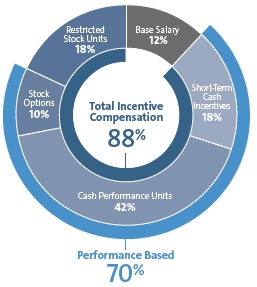 | | 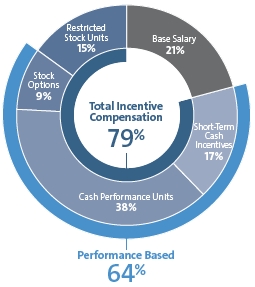 |
Our Short- and Long-Term Incentives | Short-Term Incentives
(Paid in Cash)
| 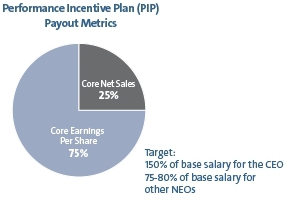 | 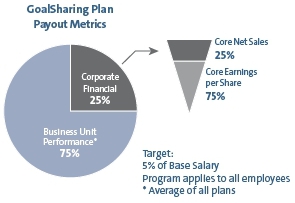 |
Long-Term Incentives
(Paid in CPUs, RSUs and Options)
|  |
CORNING20182019 PROXY STATEMENT | 43 |
Table of Contents Compensation Discussion & Analysis 2017Target Total Compensation
| CEO | | ALL OTHER NEOs | | | |  | | 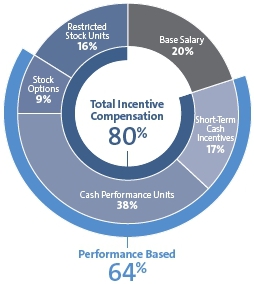 |
| Our Short- and Long-Term Incentives | | Short-Term Incentives | | (Paid in Cash) | 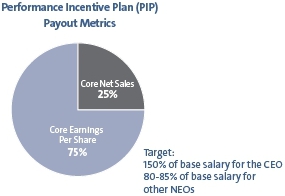 | 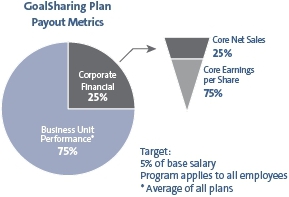 |
| Long-Term Incentives | | (CPU, RSU and Option Awards) |  |
| 44 | CORNING2019 PROXY STATEMENT |
Table of Contents Compensation Discussion & Analysis 2018 Compensation Metrics Our key compensation metrics are Core Earnings per Share (Core EPS), Core Net Sales and Adjusted Operating Cash Flow less CapEx. These metrics are designed to ensure the success of our Strategy and Capital Allocation Framework by improving profitability (Core EPS), incenting salestop line growth improving earnings per share(Core Net Sales) and generating operating cash flow.(Adjusted Operating Cash Flow less CapEx). | | CORE EPS | | CORE NET SALES | | ADJUSTED OPERATING
CASH FLOW LESS CAPEX | | | | | | | | 20172018 Actual Results
| $1.78 | $1.72
| |
$10,514
million
| | $81611,398
million
| $926
million | | | | | | | | 20172018 Score as %
of Target Payout
| | 173%116%
of target for 20172018
| | 155%for PIP
182%*127%for CPUs*
of target for 2017
2018 | | 110%128%
of target for 20172018
|
* The Core Net Sales Scorepayout scales for CPUs and PIP differ; CPUs are capped at 150% and PIP is 144%, since CPUs have a maximum payout opportunity of 150%capped at 200%. Please see page 47 for more information. Please see “Our 20172018 Performance Highlights” on page 6 for more information about our Core Performance Measures and Appendix A to this proxy statement for a reconciliation of the non-GAAP measures we use in this proxy statement to the most directly comparable GAAP financial measures. Core Net Sales, Core Earnings per Share (Core EPS), Core Net Sales and Adjusted Operating Cash Flow are non-GAAP financial measures used by our management to measure the true economics of our currency hedges and obtain a clearer view of Corning’s operating results.
| | | Accordingly, these Core Performance Measures form the basis for our compensation performance metrics. |
| CORNING2019 PROXY STATEMENT | 45 |
44 | CORNING2018 PROXY STATEMENT |
Table of Contents Compensation Discussion & Analysis 2018 Company Performance Overview 2017 Business Environment and Company Performance
In 2017,2018, we utilized our financial strength to continue our focus on innovation, advancing key programs across our market-access platforms. Some ofplatforms to make progress in our key achievements in 2017 included:Strategy and Capital Allocation Framework. Highlights of progress across Corning’s market-access platforms include: ● | Celebrating a major milestoneOptical Communications:Secured contracts with industry leaders in the productioncarrier and data center segments that will add significant sales in 2019 and beyond, introduced new products for the hyperscale data center and carrier environments and expanded market access through the acquisition of our3M’s Communication Markets Division
●one billionth kilometer of optical fiberMobile Consumer Electronics:. We also continued our technologyExtended the company’s leadership with the introductionlaunch and adoption of a new multi-use platform to simplify installation and reduce the costs of deploying 4G and 5G networks. | ● | Shippingthe world’s first Gen 10.5 glass. In addition, we captured new opportunities for Corning Iris™ Glass, which is featured in new ultra-slim, ultra-bright lines of monitors.
| ● | Expanding intonew Corning® Gorilla® Glass applications6 as well as other cover glass and sensing technology innovations
●Automotive:andincreasedGained significant new sales and platform wins for gasoline particulate filters including reaching the amountproduction milestone of our glass on mobile electronic devices. Additionally, the superior drop performance of Gorilla Glass 5 has enabled new smartphone designs that feature glass on both the front and back. | ● | Securing an exclusiveglobal supply agreement1 million GPFs; increased pull for gas particulate filters.
| ● | Winning new customers forGorilla Glass for Automotive, which will be featured on solutions, particularly the industry’s first AutoGrade™ Glass Solutions for automotive interiors, reaching more than thirty-five automotive platforms globally.55 platform wins to date
| ● | LaunchingLife Sciences Vessels:Increased shipments of Corning Valor® Glass fourfold year over year, indicating progress toward certification across more pharmaceutical companies
●Display:, a revolutionary new pharmaceutical packaging solution that dramatically reduces particle contamination, breaks,Reached stable returns as the glass pricing environment continued to improve and cracks. As a result, Valor helps protect patients, while increasingCorning extended its global leadership by establishing the world’s first Gen 10.5 manufacturing throughput.facility |
Please see “Our 20172018 Performance Highlights” on page 6 and “Our Strategy and Capital Allocation Framework” on page 7 for additional information on Corning’s 20172018 financial performance. |
20172018 Performance and Compensation Alignment
Each year we set rigorous and challenging performance goals aligned with our strategic objectives. We continue to believe that top line growth, overall profitability, revenue growth, and the generation of operating cash generationflow are the most important measures to the successful execution of our Strategy and Capital Allocation Framework and delivery of long-term shareholder value. Approximately 88%89% of the CEO’s target total compensation (excluding employee benefits and perquisites) and 79%80% of the other NEOs’ target total compensation (excluding employee benefits and perquisites) is variable and depends upon our operating performance or is linked to our stock price. Net profitability and sales growth, both short- and long-term, drive success under our Strategy and Capital Allocation Framework. Accordingly, we have incentive measures linked to both short- and long-term outcomes. Our short-term incentives are cash payments composed of the Performance Incentive Plan (PIP) and the GoalSharing plan. Under each of the PIP and the GoalSharing plan, Core EPS (75% weight) measures bottom line profitability (75% weight) and Core Net Sales (25% weight) focuses on increasing top line growth (25% weight).growth. These two financial goals comprise 100% of PIP payouts for NEOs. Actual performance was well above the established PIP targets for 2017,2018, with the blended result being a payout of 175%126% of PIP target. GoalSharing is a company-wide plan that rewards our workforce for the Company’s and Business Unit’s success by including compensation objectives reflecting a combination of corporate financial (25% weight) and business unit performance (75% weight). NEOs receive payouts based on the weighted average performance of all business unit plans, which resulted in a payout of 7.34%6.41% of base salary for 2017.2018. | 46 | CORNING2019 PROXY STATEMENT |
Table of Contents Compensation Discussion & Analysis Our Long-Term Incentive (LTI) awards reflect our belief that cash flows and revenue growth enable investments that will sustain our growth over the long term and that the interests of our executives and shareholders should be aligned. LTI awards are comprised of 60% Cash Performance Units (CPUs), 25% Restricted Stock Units (RSUs), and 15% Stock Options. CPU awards are based 70% on Adjusted Operating Cash Flow less CapEx and 30% on Core Net Sales, averaged over a three-year performance period. In 2017, the CPU payout was 120% of the performance target resulting in a total payout of 103% of target for the 3-year period 2015-2017. CORNING2018 PROXY STATEMENT | 45 |
Table of Contents
Compensation Discussion & Analysis
In addition because ROIC improvement is important to the delivery of the commitments made pursuantabove measures, 2016 CPUs are subject to our Strategy and Capital Allocation Framework, and an important metric for many of our shareholders based on their feedback, we added an ROIC modifier to the CPUs in 2016. 2016 CPUs earned for the year three-year performance period (2016 through 2018) and 2017 CPUs earned for the three-year performance period (2017 through 2019) will be increased or decreasedof up to 10% depending+/-10% based on Corning’s ROIC performanceimprovement over the three-year performance period compared2016 through 2018. We implemented this ROIC modifier in response to pre-established performance targets.investor feedback and in support of our Capital Allocation Framework. We define ROIC as core net income before interest, divided by invested capital. Core net income before interest is calculated using constant exchange rates for Japanese yen, New Taiwan dollar and Chinese yuan against the U.S. dollar, and a constant tax rate. Invested capital is the sum of total assets excluding foreign currency hedge assets less total liabilities excluding foreign currency hedge liabilities and debt. The Compensation Committee approved this ROIC modifier calculation in early 2016.
The following table compares the 20172018 actual results and targeted goals for each performance measure compared with 2016 actual results.2017. | | 2017 | | 2016 | | 2018 | | 2017 | | Measure | | Actual and
% increase
vs. ’16 Actual | | Target and
% increase
vs. ’16 Actual | | Actual | | Target | | Actual and
% increase
vs. ’17 Actual | | Target and
% increase
vs. ’17 Actual | | Actual | | Target | Core EPS
Percentage increase vs ’16 Actual | | td.72 | | td.57 | | td.55 | | td.55 | | | +11.0% | | +1.3% | | | | | | | Core EPS | | | $1.78 | | $1.74 | | $1.60 | | $1.57 | | Percentage increase vs ’17 Actual | | | +11.9% | | +8.8% | | | | | | Core Net Sales (millions) | | td0,514 | | $9,945 | | $9,710 | | $9,996 | | td1,398 | | td1,028 | | td0,258 | | $9,945 | | +8.3% | | +2.4% | | | | | | +11.5% | | +7.5% | | | | | Adjusted Operating Cash Flow
less CapEx (millions) | | $816 | | $756 | | td,651 | | td,593 | | | N/A(1) | | N/A(1) | | | | | | | Adjusted Operating Cash Flow | | | $926 | | $696 | | $816 | | $756 | | less CapEx (millions) | | | N/A(1) | | N/A(1) | | | | |
| (1) | Adjusted Operating Cash Flow less CapEx goals are established yearly, independent of the prior year. |
Please see “Our 20172018 Performance Highlights” on page 6 for more information about our Core Performance Measures and Appendix A to this proxy statement for a reconciliation of the non-GAAP measures we use in this proxy statement to the most directly comparable GAAP financial measures. In 2018, Corning used constant currency rates for the Japanese yen of ¥107:$1, for the New Taiwan dollar of NT$31:$1, for the Chinese yuan of ¥6.7:$1 and for the South Korean won of ₩1,175:$1, and restated all prior periods to these constant currency rates for comparability purposes. For additional information about our Core Performance Measures, please see page 6. Our rigorous goal setting process is demonstrated by the following thresholdspayout scale for our short- and long-term incentive plans: | | |
| Short Term/Annual Incentive
2017 PIP Measures |
| Long-Term Incentive
2017 CPU Measures
(Year One of Three-Year Average Plan) | | | |
| Core EPS Goal
(Weighted 75%) |
| Core Net Sales Goal
(Weighted 25%) |
| Adjusted Operating Cash
Flow less CapEx Goal (Weighted 70%) |
| Core Net Sales Goal
(Weighted 30%) | | | Payout % | | Core
EPS
(in $M) | | % of
2017 Plan | | Core Net
Sales
(in $M) | | % of
2016
Core Net
Sales | | Adjusted
OCF less
CapEx (in $M) | | % of
2017 Plan | | Core Net
Sales
(in $M) | | % of
2016
Core Net
Sales | | | 200% | | $1.76 | | 112% | | $10,647 | | 110% | | Capped at 150% | | | 150% | | $1.68 | | 107% | | $10,260 | | 106% | | $1,056 | | 140% | | $10,647 | | 110% | | | 125% | | $1.64 | | 105% | | $10,066 | | 104% | | $906 | | 120% | | $10,066 | | 104% | | TARGET | | 100% | | $1.57 | | 100% | | $9,945 | | 102% | | $756 | | 100% | | $9,945 | | 102% | | | 75% | | $1.42 | | 90% | | $9,776 | | 101% | | $606 | | 80% | | $9,776 | | 101% | | | 50% | | $1.26 | | 80% | | $9,679 | | 100% | | $556 | | 74% | | $9,679 | | 100% | | | 0% | | $1.18 | | 75% | | $9,292 | | 96% | | $456 | | 60% | | $9,292 | | 96% |
| | | | Short Term/Annual Incentive
2018 PIP Measures | | Long-Term Incentive
2018 CPU Measures
(Year Three of 2016-2018 Plan) | | | | | Core EPS Goal
(Weighted 75%) | | Core Net Sales Goal
(Weighted 25%) | | Adjusted Operating Cash
Flow less CapEx Goal (Weighted 70%) | | Core Net Sales Goal
(Weighted 30%) | | | Payout % | | Core
EPS | | Growth
(over
prior year) | | Core Net
Sales
(in $M) | | Growth
(over
prior year) | | Adjusted
OCF less
CapEx (in $M) | | % of
2018 Plan | | Core Net
Sales
(in $M) | | % of
2017
Core Net
Sales | | | 200% | | $1.96 | | 22.8% | | $11,490 | | 12.0% | | Capped at 150% | | | 150% | | 1.89 | | 18.6% | | 11,387 | | 11.0% | | $1,096 | | 157.5% | | $11,490 | | 12.0% | | | 125% | | 1.81 | | 13.4% | | 11,205 | | 9.2% | | 896 | | 128.7% | | 11,387 | | 11.0% | | TARGET | | 100% | | 1.74 | | 9.4% | | 11,028 | | 7.5% | | 696 | | 100.0% | | 11,028 | | 7.5% | | | 75% | | 1.64 | | 2.7% | | 10,601 | | 3.3% | | 496 | | 71.3% | | 10,601 | | 3.3% | | | 50% | | 1.60 | | 0.5% | | 10,387 | | 1.3% | | 429 | | 61.7% | | 10,387 | | 1.3% | | | 0% | | 1.42 | | -10.7% | | 10,054 | | -2.0% | | 296 | | 42.5% | | 10,054 | | -2.0% |
| CORNING2019 PROXY STATEMENT | 47 |
As discussedTable of Contents
Compensation Discussion & Analysis ROIC Modifier In 2016, based on page 44, Corning’s 2017 performance results for Core EPSinvestor feedback and Core Net Sales exceededin support of our Capital Allocation Framework, the annual target payout opportunity (173% and 182%, respectively), with the blended result for short-term incentives being 175%. Adjusted Operating Cash Flow less CapEx and Core Net Sales exceeded the annual target payout opportunity (110% and 144%, respectively), yieldingCompensation Committee added a blended result of 120% of the annual target opportunity for the 2017 earned portion of CPUs. 2017 CPUs are further subject to anthree-year ROIC modifier of ±to CPUs. With this modifier, the CPU payout may be increased or decreased up to 10% based on ROIC improvementperformance over the three-year performance period. For the 2016-2018 performance period, (2017-2019) against pre-established targets.the ROIC target was established at 250 basis points, which the Committee believed was challenging but achievable through continued strong operating performance. The setting of this target reflected the multi-year operating plan for the company and management’s assessment of future Company performance. The ROIC modifier for 2016 CPUs (based on 2016 through 2018 performance) was as follows: ROIC Improvement
2016 – 2018
(in basis points) | | Modifier (Adjustment to 2016 CPUs) | | 250 | | +10% | | 175 | | +5% | | 100 | | No adjustment | | 50 | | -5% | | 0 | | -10% |
From 2016 to 2018, ROIC improved 174 basis points, resulting in a +4.74% increase to the 2016 CPU payout made in 2019. Results for Short Term Incentives and the 2016-2018 LTI Plan | Short Term Incentives | PERFORMANCE INCENTIVE PLAN (PIP)
100% CORPORATE FINANCIAL PERFORMANCE | | Components | | Weighting | | % of target
earned | | Core EPS | | 75% | | 116% | | Core Net Sales | | 25% | | 155% | | 2018 performance result | | | | 126% | | | GOALSHARING – 25% CORPORATE PERFORMANCE,
75% BUSINESS UNIT PERFORMANCE | | Components | | | | % of base
salary earned | | Corporate financial performance — | | | | | | 1.25% target × 126% performance | | | | | | (See PIP above) | | 25% | | 1.58% | | Average Business Unit Performance | | 75% | | 4.83% | | 2018 performance result | | | | 6.41% |
| Long Term Incentives | CASH PERFORMANCE UNITS
(60% OF LTI TARGET – OTHER 40% ARE RSUs AND OPTIONS) | | Components | | Weighting | | % of target
earned, 2018
performance
year | | Operating Cash Flow less CapEx | | 70% | | 128% | | Core Net Sales | | 30% | | 127% | | 2018 performance result | | | | 128% | | | | 2016-2018 CPU PERFORMANCE RESULTS | | Components | | | | % of target
earned,
2016-2018
performance | | 2016 performance result | | | | 88% | | 2017 performance result | | | | 120% | | 2018 performance result | | | | 128% | | 2016-2018 average performance | | | | 112% |
46ROIC MODIFIER | | 2016-2018 average performance | × | ROIC Modifier | = | Final percentage of target amount of 2016 CPUs to be paid in 2018 | | 112% × 4.74% =117% |
| 48 | CORNING20182019 PROXY STATEMENT |
Table of Contents Compensation Discussion & Analysis Total Shareholder Return Corning’s Total Shareholder Return (TSR), which consists of stock price appreciation and reinvestment of common dividends, was 34.7% in 2017. Our three-year annualized TSR performance was 14.4% and our five-year annualized TSR performance was 23.3%, both outperformingoutperformed the S&P 500 Index.Index over the last 1-, 3-, and 5-year periods as of year-end 2018. Since the introduction of our Strategy and Capital Allocation Framework, we have outperformed the S&P 500 Index by approximately 2.5nearly three times in terms of total shareholder return. The Strategy and Capital Allocation Framework has paid off from a financial perspective.
Between its inception in October 2015 and year-end 2017,2018, Corning had total shareholder returnTSR of approximately 102%
95% vs. less than 40%35% for the S&P 500. |
| ANNUALIZED TOTAL SHAREHOLDER RETURN | | TOTAL SHAREHOLDER RETURN SINCE START OF FRAMEWORK | As of year-end 20172018 | | October 21, 2015 through year-end 20172018 |
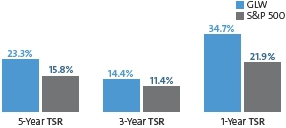 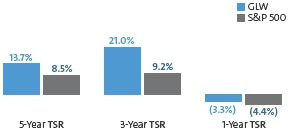 | |   | Source: Bloomberg | | Source: Bloomberg |
Shareholder Engagement At our 2017 annual
meeting of shareholders,
our Say on Pay proposal
At our 2018 annual meeting of shareholders, our Say on Pay proposal received support from
92%
of votes cast. | | 90% | | of votes cast. |
Strong Say on Pay Results.At our 20172018 Annual Meeting of shareholders, our Say on Pay proposal received support from 92%90% of votes cast. We have received 90% or greater support for our Say on Pay proposal each of the past three years. We view this level of shareholder support as an affirmation of our current pay practices and pay for performance philosophy. Shareholder Outreach.In 2017,2018, as part of our shareholder outreach program, we met with shareholders representing approximately 40%45% of our outstanding shares, and approximately two-thirds of our top fifty shareholders. In these meetings, we discussed our Strategy and Capital Allocation Framework (SCAF), as well as governance, compensation, human capital management and sustainability matters. We learned through these meetings thatmeetingsthat our investors are pleased with our Strategy and Capital Allocation Frameworkthe SCAF and believe we have clearly articulated how our Strategy and Capital Allocation Frameworkit creates shareholder value and is connectedtoconnected to management incentivescompensation at Corning. These shareholders also were generally supportive of our executive compensation program, the direct linkage of financial metrics in our incentiveperformance-based variable compensation plans to our Strategy and Capital Allocation Framework,the SCAF, and the addition of the ROIC modifier.modifier that was implemented in 2016 in response to investor feedback. As in previous years, shareholders were not prescriptive about compensation plan design. Instead, they were more interested to see that the results and outcomes delivered by the incentive plans were aligned appropriately with Corning’s performance and had appropriately incented our executives to deliver on our Strategy and Capital Allocation Framework. See “Shareholder Communication” on page 11 for additional information.SCAF. CORNING20182019 PROXY STATEMENT | 4749 |
Table of Contents Compensation Discussion & Analysis Robust Compensation Program Governance Corning has rigorous and robust governance with respect to its executive compensation plan: ✓ | Close alignment of pay with performance over both the short and long termlong-term horizon, | | | | and delivery of the goals of our Strategy and Capital Allocation Framework ✓ | Mix of cash and equity incentives tied to short-term financial performance and long-term value creation | | | ✓ | CEO total compensation targeted within a competitive range of the Compensation Peer Group median | | | ✓ | Caps on payout levels for annual incentives in a budgeted down-cycle year | | | ✓ | Significant NEO share ownership requirements | | | ✓ | Anti-hedging and pledging policies | | | ✓ | Clawback policy | | | ✓ | Employee applicable to both cash and equity plan specifies minimumcompensation✓Minimum 3-year vesting period stretching over at least 3 years for restricted stock or restricted stock unit awards | | | | in employee equity plan ✓ | Independent compensation consultant advisor to the Compensation Committee | | | ✓ | History of demonstrated responsiveness to shareholder concerns and feedback, and ongoing commitment to shareholder engagement | | | ✓ | Limited and modest perquisites that have a sound benefit to the Company’s business | | | ✖ | ✕No tax gross-ups or tax assistance on perquisites | | | ✖ | ✕No repricing or cash buyout of underwater stock options without shareholder approval | | | ✖ | ✕No excise tax gross-ups for officer agreements entered into after July 2004 |
20172018 Executive Compensation Program Details
Our key compensation program principles are as follows: | ● | Provide a competitive base salary | | | | | ● | Pay for performance | | | | | ● | Incent execution of our Strategy and Capital Allocation Framework | | | | | ● | Apply a team-based management approach | | | | | ● | Increase the proportion of performance-based incentive compensation for more senior positions | | | | | ● | Align the interests of our executive group with shareholders |
Base Salary Base salaries provide a form of fixed compensation and are reviewed annually by the Committee, taking into accountwhich considers internal equity and individual performance, as well as competitive positioning, as discussed in the “Compensation Peer Group” section starting on page 52.54. In 2017, all NEOs with the exception of2018, Mr. Tripeny receivedWeeks’ base salary increases of approximatelyincreased by 3%, consistent with the salary increase budget for all other U.S. salaried employees. Mr. Tripeny received a base salary increase of 17.7%15% as part of a multi-year strategy to better align his overall compensation package to comparable external salary benchmarks as he continues to demonstrate strong performance as CFO. Base salaries of the remaining NEOs increased by 5.5% as a result of strong performance and to align compensation with both internal and external salary benchmarks as the Company grows. | 50 | CORNING2019 PROXY STATEMENT |
Table of Contents Compensation Discussion & Analysis Short-Term Incentives Short-term incentives are designed to reward NEOs for Corning’s consolidated annual financial performance supporting our Strategy and Capital Allocation Framework and team-based management approach. As discussed above, they are composed ofCorning has two annual cash bonus plans,short-term incentive plans: the PIPPerformance Incentive Plan (PIP) and GoalSharing. 48 | CORNING2018 PROXY STATEMENT |
TablePIP targets are individually established by the Committee each February as a percentage of Contentsyear-end salary depending on the competitive marketplace and level of experience. In 2018, Mr. Weeks’ PIP target is unchanged at 150% of year-end base salary. Mr. McRae’s PIP target is 85% of year-end base salary and other NEOs have PIP targets of 80%. PIP goals are approved in February and payments are made by the following March 15 once the performance results are known. As outlined on page 48, the 2018 PIP payout will be 126% of target based on performance achievement above the pre-established targets.
Compensation Discussion & Analysis
Short-Term IncentivesGoalSharing is designed to motivate employees to work together to achieve the most critical goals in each business unit. All Corning employees are eligible for GoalSharing with a target generally equal to 5% of base salary. Earned GoalSharing may be 0% - 10% of base salary, and is weighted 25% on corporate financial performance and 75% on business unit performance. The NEOs’ GoalSharing is based 25% on corporate financial performance and 75% on the average of the results of all business unit plans. GoalSharing goals are approved in 2017February each year and payment are made by the end of the following February once the performance results are known. As outlined on page 48, the 2018 GoalSharing payout will be 6.41% of year-end base pay due to achievement above the pre-established targets.

| Performance
Measures | Target
Opportunity
| 2017 Performance
Target | 2017 Actual
Results | Earned Award
for 2017 | Performance
Incentive Plan
Core EPS (75%)
Core Net Sales (25%)
| CEO:
150%
of base salary
Other NEOs:
75%-80%
of base salary
| Core EPS:
$1.57
Core Net Sales:$9,945 million
| Core EPS:
$1.72
Core Net Sales:$10,514 million
| Core EPS result
(75% of weight):
173% of target payout
Core Net Sales result
(25% of weight):
182% of target payout
Blended result:
175% of target payout
| GoalSharing
Average of all
business unit plans
| 5% of
base salary
| 25% Core EPS and Core Net Sales (as noted above)
75% Business unit performance
NEO awards are based on the average of all business unit plans
| 7.34% of base salary
| 7.34% of base salary
|
Long-Term Incentives Long-term incentivesLong-Term Incentives (LTI) are comprised of cash and equity in the form of 1) cash performance units (CPUs), 2) restricted stock units (RSUs),CPUs, RSUs, and 3) stock options (Options). Target value amounts are established by the Committee for each NEO annually in February. We believe it is important to link LTI amounts to financial measures that support the execution of our Strategy and Capital Allocation Framework and generate long-term value for our shareholders. We also believe it is important for a portion of LTI to be in the form of equity to align our NEOs’executives’ stock ownership interests with those of our shareholders.
LTI targets are established by the Committee for each NEO annually in February. Mr. Weeks’ 2018 LTI target is $9 million. Other NEOs’ targets may be found in footnote 3 to the Summary Compensation Table on page 58 and range from $2.125 million to $2.4 million. | ● | CPUsrepresent 60% of the annual target LTI value.target. Payout is based on cash generation and revenue growth, measures that support our Strategy and Capital Allocation Framework as well as our long-term financial health and success. The performance measures for CPUs are 1) Adjusted Operating Cash Flow less CapEx (70%), which aligns the cash flow goal to our capital allocation plan and maintains focus on our CapEx, and 2) Core Net Sales (30%). Actual CPUs earned are based on the average performance over a three-year period. CPUs awarded in 20172018 are also subject to a three-year ROIC modifier of up to ±10% to further align compensation earned with the goal of our Strategy and Capital Allocation Framework to improve our corporate ROIC. Accordingly, CPUs earned for the years 2017-20192018-2020 will be paid out (in 2020)2021) subject to an adjustment of up to ±10%, depending on Corning’s ROIC performance over the three yearthree-year performance period compared to a pre-established performance target. | | | | ● | RSUsrepresent 25% of the annual target LTI value. The number of RSUs granted is determined based on the closing stock price aton the endfirst business day of March,April, and awards cliff vest approximately three years from the grant date. | | | | ● | Optionsrepresent 15% of the annual target LTI value. The number of Options granted is determined using a Black-Scholes valuation. Options were granted aton the endfirst business day of March.April. Vesting is three years after the grant date, and the option awards have a maximum ten-year term. |
CORNING20182019 PROXY STATEMENT | 4951 |
Table of Contents Compensation Discussion & Analysis 2017 Long-Term Incentives – Cash Component

| Performance
Metrics | Target
Opportunity
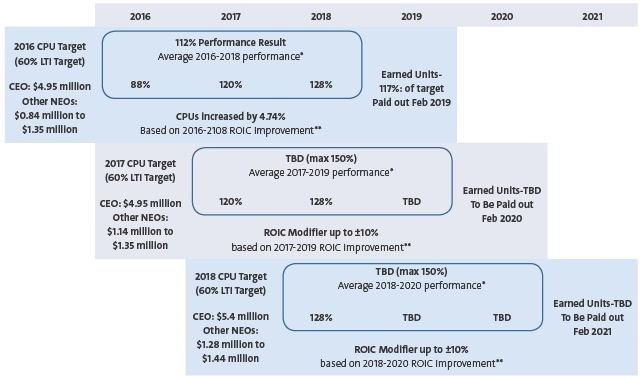
| Performance
Target | 2017 Actual
Results | Earned Award
for 2017 | Adjusted Operating
Cash Flow (70%)
Core Net Sales
(30%)
| CEO:
$4.95 million
Other NEOs:
$1.14 million to
$1.35 million
| Applies to the
following CPUs:
Year 1 of 3:
2017–2019,
Year 2 of 3:
2016–2018, and
Year 3 of 3:
2015–2017
Adjusted Operating
Cash Flow, less
CapEx$756 million
Core Net Sales:
$9,945 million
| Adjusted
Operating Cash
Flow less CapEx:
$816 million
Result: 110% of
target payout
Core Net Sales:
$10,514 million
Result: 144% of
target payout
Blended Result:
120% of
target payout
| 2017–2019 CPUs
Year 1: 120% of target payout
Year 2: TBD
Year 3: TBD
Three-year average, ±10%:
TBD*
2016–2018 CPUs
Year 1: 88% of target payout
Year 2: 120% of target payout
Year 3: TBD
Three-year average, ±10%:
TBD**
2015–2017 CPUs
Year 1: 100% of target payout
Year 2: 88% of target payout
Year 3: 120% of target payout
Three-year average: 103% of target payout, paid in 2018
|
| * | Subject to a ±10% adjustment based on ROIC improvement from 2017 through 2019 against pre-established targets.Performance targets are established in February each year for the calendar year. See page 48 for 2018 performance measures and results | | ** | Subject to a ±10% adjustment based on3-year ROIC improvement from 2016 through 2018 against pre-established targets.
target is established at the beginning of each 3-year performance period. See page 48 for 2016-2018 performance measure and results |
20172018 Long-Term Incentives – Equity Components


| Compensation
Component | Target
Opportunity | Number of
Units/Options Granted | Vesting
Period | Value
Realized | Restricted
Stock
Units (RSUs) | CEO:
$2.25 million Other NEOs:
$0.53 million to
$0.6 million | CEO:
$2.06 million
Other NEOs:
$0.48 million to
$0.56 million
| 25% of annualLTI target,LTI value, based on the closing price of Corning’s commonstock on the grant date (March 31, 2017)(April 2, 2018) | Approximately
3 years | Dependent upon Corning common stock price on the vesting date | Stock
Options | CEO:
$1.35 million Other NEOs:
$0. 32 million to
$0.36 million | CEO:
$1.24 million
Other NEOs:
$0.29 million to
$0.34 million
| 15% of annualLTI target, LTI value, based on the Black Scholes Valuation at the time of the grant (April 2, 2018)(March 31, 2017) | 3 years | Dependent upon Corning common stock price increase, if any, between time of the grant and the time of exercise |
5052 | CORNING20182019 PROXY STATEMENT |
Table of Contents Compensation Discussion & Analysis CEO Target Compensation Over the past thirteenfourteen years, under the leadership of Mr. Weeks, Corning has consistently increased Core Net Sales, Core EPS, and Adjusted Operating Cash Flow. We have continued to grow,grown significantly, achieved the lowest cost position and market leadership in many key businesses, and created new-to-the-world product categories, such as Corning® Gorilla® Glass, heavy-duty diesel substrates and filters, customized fiber-to-the-home solutions and Corning Valor® Glass. InBased on this sustained level of performance, in February 2017,2018, the Compensation Committee approved a 3% base salary increase for Mr. Weeks, with all other compensation elements remaining flat:and an increase in LTI target to $9 million.
| ● | Base salary– increased by 3% in line with base salary increases for all other U.S. based salaried employees. | | ● | Target Short-Term Incentives Target–remained flat at 155% of base salary, comprised of a PIP target of 150% of base salary and a GoalSharing target of 5% of base salary.
| | ● | Target Long-Term Incentives Target– remained flat compared with 2016 LTI target at $8,250,000.increased to $9 million from $8.25 million
|
Eighty-eightEighty-nine percent of Mr. Weeks’ pay is directly tied to Corning’s operating performance and stock price.
Employee Benefits and Perquisites Employee Benefits:Our NEOs are eligible to participate in the same employee benefits plans as all other eligible U.S. salaried employees. These plans include medical, dental, life insurance, disability, matching gifts, qualified defined benefit and defined contribution plans. We also maintain non-qualified defined benefit and defined contribution retirement and long-term disability plans with the same general features and benefits as our qualified plans for all U.S. salaried employees affected by tax law compensation, contribution or deduction limits. In addition to the standard benefits available to all eligible U.S. salaried employees, the NEOs are eligible for the benefits and perquisites described in this section. Executive Supplemental Pension Plan (ESPP):We maintain an ESPP to reward and retain long-serving individuals who are critical to executing Corning’s innovation strategy. Our non-qualified ESPP covers approximately 20 active participants, including all of the NEOs. In 2006, we capped the percentage of cash compensation earned as a retirement benefit under the ESPP at a maximum of 50% of final average pay for 25 or more years of service, a change that applies to all the NEOs except Dr. Morse. The definition of pay used to determine benefits includes base salary and annual cash bonuses; long-termbonuses. Long-term cash or equity incentives are not included and do not affect retirement benefits. Executives must have at least ten years of service to be vested under this plan. All of the NEOs meet thatthe ten-year vesting requirement. While we seek to maintain well-funded qualified retirement plans, we do not fund our non-qualified retirement plans. For additional details of the ESPP benefits and plan features, please refer to the section entitled “Retirement Plans” on page 62.64. Executive Physical and Wellness:All executives are eligible for an annual physical exam in addition to wellness programs sponsored by Corning for all employees. Relocation and Expatriate-Related Expenses:As part of our global mobility program, our policies provide that employees who relocate to another country at our request are eligible for certain relocation and expatriate benefits to facilitate the transition and international assignment. These benefits include moving expenses, allowances for housing and goods and services, and tax assistance. These policies are intended to recognize and compensate employees for incremental costs incurred with moving or with living and working outside of the employee’s home country. The goal of these relocation and expatriate assistance programs is to ensure that employees are not financially advantaged or disadvantaged as a resultbecause of their relocation and/or international assignment, including related taxes. In July 2016, Mr. Clappin’s assignment in Tokyo ended and he relocated back to Corning, NY. While he was based in Tokyo, Mr. Clappin was eligible for expatriate benefits. These amounts are detailed in footnote 5, section (v) to the Summary Compensation Table. CORNING20182019 PROXY STATEMENT | 5153 |
Table of Contents Compensation Discussion & Analysis Other Executive Perquisites:We provide the NEOs with an overall allowance that can be used for home security, modest personal aircraft usage, and limited financial counseling services. Each NEO is responsible for all taxes on any imputed income resulting from these perquisites. Given the limited commercial flight options available in the Corning, New York area, the Committee believes that a well-managed program of limited personal aircraft use provides an extremely important benefit at a reasonable cost to the Company. We closely monitor business and personal usage of our planes and limit personal usage to keep it at a low percentage of total usage. The Committee establishes annual personal aircraft usage caps under this program (both hours and absolute dollar value) for each NEO. The established cap for the CEO was 100 hours and $170,000; the cap for the other NEOs was approximately half this level or lower. Actual utilization falls below these caps. For additional details, refer to footnotes relating to “All Other Compensation” included with the Summary Compensation Table starting on page 56.58. Executive Severance:We have entered into severance agreements with each NEO. The severance agreements provide clarity for both Corning and the executive if the executive’s employment terminates. By having an agreement in place, we avoid the uncertainty, negotiations and potential litigation that may otherwise occur in the event of termination. The agreements are competitive with market practices at many other large companies and are helpful in retaining senior executives. Additional details can be found under “Arrangements with Named Executive Officers” on page 65.67. Executive Change-in-Control Agreements:The Committee believes that it is in the best interests of shareholders, employees and the communities in which Corning operates to ensure an orderly process if a change in control were to occur. The Committee also believes it is important to prevent the loss of key management personnel (who would be difficult to replace) that may occur in connection with a potential or actual change in control. Therefore, we have provided each NEO with a change-in-control agreement (separate from the severance agreements described above). The change-in-control agreements provide that an executive’s employment must be terminated or effectively terminated in connection with a change in control in order to receive severance benefits. Additional details about the specific agreements can be found under “Arrangements with Named Executive Officers – Change-in-Control Agreements” on page 67.69. In 2012, the Committee approved updated forms of agreements for all corporate officers entering into change-in-control agreements after July 2004, which contain no provision for gross-ups for excise taxes, and cap severance and other benefits at 2.99 times base salary plus target bonus, with cash severance for most officers limited to 2 times base salary plus target bonus. Except for Mr. Tripeny, whose agreement is dated January 1, 2015, our current NEOs have grandfathered agreements that were entered into prior to July 2004. |
In 2012, the Committee approved updated forms of agreements for all corporate officers entering into change-in-control agreements after July 2004, which contain no provision for gross-ups for excise taxes, and cap severance and other benefits at 2.99 times base salary plus target bonus, with cash severance for most officers limited to 2 times base salary plus target bonus. Except for Mr. Tripeny, whose agreement is dated January 1, 2015, our current NEOs have grandfathered agreements that were entered into prior to July 2004. Compensation Peer Group Corning is a diversified technology company with five reportable business segments. The majority of our businesses do not have U.S. public company peers. Most of our businesses compete with non-U.S. companies in Asia and Europe, or privately-held companies that do not provide comparable executive compensation disclosure. In attempting to identify peer companies for compensation purposes, Corning must look to globally diversified companies or innovation companies in other industries to find organizations of similar size and complexity (when viewed in terms of revenues, net income, market capitalization, assets and number of employees). For these reasons, our peer group for compensation purposes does not closely resemble the companies with which we compete for business. | ● | Our largest competitors and most relevant financial performance peers are not U.S. public companies.
| | ● | Corning must look to globally diversified companies or innovation companies in other industries to find companies of similar size and complexity. |
52 | CORNING2018 PROXY STATEMENT |
Table of Contents
Compensation Discussion & Analysis
We currently participate in and use several executive compensation surveys for NEO positions. We continue to usePrimary surveys are the Willis Towers Watson General Industry Executive Compensation Survey, and the Equilar TrueValue Survey. In 2017, we discontinued use of the Mercer Executive Compensation surveySurvey and supplemented our sources with a small group of specialized senior executive matches found in the Aon Hewitt Total Compensation Measurement Survey for Executives. The surveys provide general market data for relevant positions in companies with revenues and market capitalization similar to Corning’s in both the Technology industry and in general industry. | 54 | PERCENT RANK, CORNING VERSUS COMPENSATION PEER GROUP2019 PROXY STATEMENT |

Compensation Discussion & Analysis 2018 Compensation Peer Group The Compensation Peer Group in 2018 is set forth below. It is the same as the Compensation Peer Group in 2017, except for Monsanto Company and Praxair, Inc., which were acquired during 2018 and are no longer included. | Advanced Micro Devices, Inc. | | Cummins Inc. | | Medtronic, Inc. | | QUALCOMM, Inc.TE Connectivity Limited | | Agilent Technologies, Inc. | | Danaher Corporation | | Monsanto CompanyMotorola Solutions, Inc. | | Rockwell Automation, Inc.Texas Instruments Incorporated | | Applied Materials, Inc. | | Dover Corporation | | Motorola Solutions,NetApp, Inc. | | TE Connectivity LimitedThermo Fisher Scientific, Inc. | | BorgWarner, Inc. | | Eaton Corporation PLC | | NetApp,PPG Industries, Inc. | | Texas Instruments Incorporated | | Boston Scientific Corporation | | Harris Corporation | | PPG Industries,QUALCOMM, Inc. | | Thermo Fisher Scientific, Inc. | | Broadcom Corporation | | Juniper Networks, Inc. | | Praxair,Rockwell Automation, Inc. | | |
The Company selects a fair and challenging Compensation Peer Group as a reference point when setting its executive compensation. The Company’s percentage ranking versus the Compensation Peer Group is near to or well-above the median in all measured categories. | PERCENT RANK, CORNING VERSUS COMPENSATION PEER GROUP |

Corning uses the Compensation Peer Group solely as a reference point, in combination with broader executive compensation surveys, to assess each NEO’s target total direct compensation (i.e., salary, target bonus, and the grant date fair value of long-term incentives). Our goal is to position our CEO’s target total direct compensation within a competitive range of the Compensation Peer Group median. Median target total direct CEO compensation in the Compensation Peer Group was determined to be $11.2$12.9 million, and 75th percentile target total direct CEO compensation was $13.2$15.4 million, compared with Corning target total direct CEO compensation of $11.8$12.7 million. Beyond the CEO, external data serves as a reference point, with internal equity and individual performance and impact being more important considerations in establishing a base salary and target total direct compensation for the other NEOs. Compensation Program – Other Governance Matters Role of Compensation Consultant The Compensation Committee has the authority to retain and terminate a compensation consultant, and to approve the consultant’s fees and all other terms of such engagement. Since 2014, the Committee has retained an executive compensation expert from Frederic W. Cook & Co., Inc. (FW Cook) as its independent consultant. In 2017,2018, FW Cook attended all Committee meetings. FW Cook advises the Committee on all matters related to NEO and director compensation and assists the Committee in interpreting its data as well as data and recommendations received from the Company. In 2017,2018, the Company also engaged Compensation Advisory Partners LLC (CAP), and Willis Towers Watson (WTW) to assist management with various executive compensation matters. The Committee conducted an independence review of FW Cook, CAP and WTW pursuant to SEC and NYSE rules, and concluded that the work of each firm for Committee did not raise any conflicts of interest concerns. FW Cook provides no services to Corning other than the services rendered to the Committee. CORNING20182019 PROXY STATEMENT | 5355 |
Table of Contents Compensation Discussion & Analysis Role of Executive Management in the Executive Compensation Process Corning’s executive vice president, People and Digital and senior vice president (SVP), Human Resources and SVP, Global Compensation and Benefits, working closely with other members of Corning’s Human Resources, Law and Finance departments, are responsible for designing and implementing executive compensation programs and discussing with the Committee significant proposals or topics that affect executive compensation at the Company. The SVP, Global Compensation and Benefits, formulates the target total compensation recommendations for all of the NEOs (except the CEO) and reviews the recommendations for each of the other NEOs with the CEO. The NEOs do not recommend or suggest individual compensation actions that benefit them personally. The CEO may propose adjustments he deems appropriate before management’s recommendations are submitted to the Committee. Recommendations for the CEO’s compensation are prepared by the Committee’s independent compensation consultant (FW Cook) and are not discussed or reviewed with the CEO prior to the Committee’s review and the CEO is not present for discussion of his compensation by the Committee. After the annual budget is finalized each year, the Committee receives management’s recommendations for the compensation plan performance metrics and sets the final targets for the year. The CFO typically attends the annual Committee meeting to review the CD&A, and attends that portion of the February Committee meeting where performance metrics are reviewed. Clawback Policy Our clawback policy gives the Committee the sole and absolute discretion to make retroactive adjustments to any cash or equity-based incentive compensation paid to certain executive officers and other key employees if such payment was based upon the achievement of financial results that were subsequently the subject of a restatement. The Committee has discretion to seek recovery of any amount that it determines was received inappropriately by such individuals. Anti-Hedging Policy Our anti-hedging policy prohibits employees and directors from selling or buying publicly traded options on Corning stock, or trading in any Corning stock derivatives. Additionally, these individuals may not engage in transactions in which they may profit from short-term speculative swings in the value of Corning stock utilizing “short sales” or “put” or “call” options. Anti-Pledging Policy Our anti-pledging policy prohibits employees and directors from holding Corning stock in a margin account or pledging Company securities as collateral for a loan. Tax Deductibility of Compensation Historically, the Committee has made compensation decisions with an eye towards deductibility of performance-based pay under IRC Section 162(m). However, the Tax Cuts and Jobs Act of 2017 (the(“the Tax Act)Act”) that was signed into law December 22, 2017 eliminated the exemption from Section 162(m)’s deduction limit for performance-based compensation, effective for taxable years beginning after December 31, 2017. Compensation paid to our covered officers in excess of $1 million therefore will not be deductible unless it qualifies for transition relief. Given the changing nature of the deductibility for such compensation, the Committee will be reviewing the Tax Act in 2018 and its application and impact, if any, on the Company’s compensation programs. Accounting Implications In designing our compensation and benefit programs, we review the accounting implications of our decisions. We seek to deliver cost-effective compensation and benefit programs that meet both the needs of the Company and our employees. 5456 | CORNING20182019 PROXY STATEMENT |
Table of Contents Compensation Discussion & Analysis Compensation Committee Report The Compensation Committee of the Board of Directors (the Committee), which is composed entirely of independent directors, is responsible to the Board of Directors and our shareholders for the oversight and administration of executive compensation at Corning. The Committee approves the principles guiding the Company’s compensation philosophy, reviews and approves executive compensation levels (including cash compensation, equity incentives, benefits and perquisites for officers) and reports its actions to the Board of Directors for review and, as necessary, approval. The Committee is responsible for interpreting Corning’s executive compensation plans and programs. In the event of any questions or disputes, the Committee may use its judgment and/or discretion to make final administrative decisions regarding these plans and programs. It is our practice that all compensation decisions affecting a corporate officer must be reviewed and approved by the Committee. Additional details regarding the role and responsibilities of the Committee are defined in the Committee Charter, located in the Corporate Governance section of the Company’s website. The Committee has reviewed and discussed the foregoing CD&A with management. Based on our review and discussions with management, we recommended to the Board of Directors that the CD&A be included in this proxy statement and in our Annual Report on Form 10-K for the year ended December 31, 2017.2018. The Compensation Committee: Deborah D. Rieman,Chair
Leslie A. Brun
Richard T. Clark
Kurt M. Landgraf
Hansel E. Tookes II CORNING20182019 PROXY STATEMENT | 5557 |
Table of Contents Compensation Discussion & Analysis 20172018 Compensation Tables
20172018 Summary Compensation Table
This table describes the total compensation paid to our NEOs for fiscal years 2018, 2017 2016 and 2015,2016, as required. The components of the total compensation are described in the footnotes below and in more detail in the tables and narratives that follow. For information on the role of each component of compensation, see the description under “Compensation Discussion and Analysis.” Named
Executive Officer | Year | Salary
($) | Stock
Awards(1)
($) | Option
Awards(2)
($) | Non-Equity
Incentive Plan
Compensation(3)
($) | Change in
Pension
Value And
Non-qualified
Deferred
Compensation
Earnings(4)
($) | All Other
Compensation(5)
($) | Total
($) | | Wendell P. Weeks | 2017 | $1,370,971 | $2,062,503 | $1,154,705 | $9,240,173 | $2,680,783 | $359,440 | $16,868,575 | | Chairman, Chief | 2016 | 1,337,740 | 2,062,491 | 963,399 | 5,750,512 | 928,531 | 266,582 | 11,309,255 | | Executive Officer and | 2015 | 1,353,096 | 1,999,990 | 1,116,499 | 4,407,018 | 1,306,544 | 255,841 | 10,438,988 | | President | | | | | | | | | | R. Tony Tripeny | 2017 | 553,269 | 475,011 | 265,933 | 1,796,340 | 858,254 | 111,412 | 4,060,219 | | Senior Vice President | 2016 | 504,808 | 349,991 | 163,480 | 916,406 | 214,950 | 126,222 | 2,275,857 | | and Chief Financial | 2015 | 434,135 | 387,494 | 146,542 | 650,617 | 0 | 75,299 | 1,694,087 | | Officer | | | | | | | | | | James P. Clappin | 2017 | 703,600 | 524,988 | 293,929 | 2,401,287 | 674,260 | 157,335 | 4,755,399 | | President, Corning | 2016 | 686,538 | 525,007 | 245,230 | 1,537,749 | 66,568 | 3,452,856 | 6,513,948 | | Glass Technologies | 2015 | 695,000 | 524,997 | 293,084 | 1,200,392 | 56,178 | 1,672,111 | 4,441,762 | | Lawrence D. McRae | 2017 | 750,173 | 562,491 | 314,921 | 2,610,289 | 893,805 | 78,304 | 5,209,983 | | Vice Chairman | 2016 | 731,971 | 562,505 | 262,737 | 1,633,734 | 90,676 | 83,329 | 3,364,952 | | and Corporate | 2015 | 713,173 | 587,488 | 300,063 | 1,245,685 | 0 | 77,177 | 2,923,586 | | Development Officer | | | | | | | | | | David L. Morse | 2017 | 646,683 | 524,988 | 293,929 | 2,321,182 | 1,154,083 | 115,809 | 5,056,674 | | Executive Vice | 2016 | 631,010 | 525,007 | 245,230 | 1,498,641 | 468,668 | 97,390 | 3,465,946 | | President and Chief | | | | | | | | | | Technology Officer | | | | | | | | |
2018 Non-Equity Incentive Plan Compensation for each NEO, shown in the table below in column (f), is arrived at by adding together the relevant 2018 value in each of columns (A), (B), (C), (D), (X) and (Y) from the tables in Footnote 3 below. | (a) | | (b) | | (c) | | (d)(1) | | (e)(2) | | (f)(3) | | (g)(4) | | (h)(5) | | (i) | | Named Executive Officer | | Year | | Salary
($) | | Stock
Awards
($) | | Option
Awards
($) | | Non-Equity
Incentive Plan
Compensation
($) | | Change in
Pension
Value And
Nonqualified
Deferred
Compensation
Earnings
($) | | All Other
Compensation
($) | | Total
($) | | Wendell P. Weeks | | 2018 | | $1,412,769 | | $2,250,004 | | $1,068,905 | | $9,496,910 | | $214,550 | | $477,933 | | $14,921,071 | | Chairman, Chief Executive | | 2017 | | 1,370,971 | | 2,062,503 | | 1,154,705 | | 9,240,173 | | 2,680,783 | | 359,440 | | 16,868,575 | | Officer and President | | 2016 | | 1,337,740 | | 2,062,491 | | 963,399 | | 5,750,512 | | 928,531 | | 266,582 | | 11,309,255 | | R. Tony Tripeny | | 2018 | | 643,269 | | 531,248 | | 252,380 | | 2,128,343 | | 784,470 | | 137,172 | | 4,476,882 | | Executive Vice President and | | 2017 | | 553,269 | | 475,011 | | 265,933 | | 1,796,340 | | 858,254 | | 111,412 | | 4,060,219 | | Chief Financial Officer | | 2016 | | 504,808 | | 349,991 | | 163,480 | | 916,406 | | 214,950 | | 126,222 | | 2,275,857 | | James P. Clappin | | 2018 | | 731,515 | | 587,497 | | 279,101 | | 2,521,206 | | 49,144 | | 333,350 | | 4,501,813 | | Executive Vice President, | | 2017 | | 703,600 | | 524,988 | | 293,929 | | 2,401,287 | | 674,260 | | 157,335 | | 4,755,399 | | Corning Glass Technologies | | 2016 | | 686,538 | | 525,007 | | 245,230 | | 1,537,749 | | 66,568 | | 3,452,856 | | 6,513,948 | | Lawrence D. McRae | | 2018 | | 780,113 | | 600,012 | | 285,043 | | 2,720,709 | | 58,395 | | 68,687 | | 4,512,959 | | Vice Chairman and Corporate | | 2017 | | 750,173 | | 562,491 | | 314,921 | | 2,610,289 | | 893,805 | | 78,304 | | 5,209,983 | | Development Officer | | 2016 | | 731,971 | | 562,505 | | 262,737 | | 1,633,734 | | 90,676 | | 83,329 | | 3,364,952 | | David L. Morse | | 2018 | | 677,465 | | 562,494 | | 267,225 | | 2,444,561 | | 444,224 | | 149,850 | | 4,545,819 | | Executive Vice President and | | 2017 | | 646,683 | | 524,988 | | 293,929 | | 2,321,182 | | 1,154,083 | | 115,809 | | 5,056,674 | | Chief Technology Officer | | 2016 | | 631,010 | | 525,007 | | 245,230 | | 1,498,641 | | 468,668 | | 97,390 | | 3,465,946 |
| (1) | The amounts in the Stock Awards column reflect the aggregate grant date fair value computed in accordance with FASB ASC Topic 718 of awards of restricted stock units and restricted stock awards granted pursuant to the 2012 Long-Term Incentive Plan.long term incentive plan. Assumptions used in the calculation of these amounts are included in Note 191 to the Company’s audited financial statements for the fiscal year ended December 31, 20172018 included in the Company’s Annual Report on Form 10-K filed with the SEC on February 15, 2018.12, 2019. This same method was used for the fiscal years ended December 31, 20162017 and 2015.2016. There can be no assurance that the grant date fair value amounts will ever be realized. | | (2) | The amounts in the OptionOptions Awards column reflect the aggregate grant date fair value computed in accordance with FASB ASC Topic 718 of stock option awards granted pursuant to the 2012 Long-Term Incentive Plan.long term incentive plan. Assumptions used in the calculation of these amounts are included in Note 191 to the Company’s audited financial statements for the fiscal year ended December 31, 20172018 included in the Company’s Annual Report on Form 10-K filed with the SEC on February 15, 2018.12, 2019. The grant date fair value amounts may never be realized. | | (3) | The amounts in the Non-Equity Incentive Plan Compensation column reflect the sum of annual short term incentive payments and earned cash performance units under the Long-Term Incentive Plan.units. All of the annual cash bonuses paid to the NEOs are performance-based. Cash bonuses are paid annually through two plans: (i) GoalSharing; and (ii) the Performance Incentive Plan (PIP). Awards earned under the 20172018 GoalSharing plan were 7.34%6.41% of each NEO’s year-end base salary and paid in February 2018.2019. Awards earned under the 20172018 PIP were based on actual corporate performance compared to the Core EPS and Core Net Salescore net sales goals established for the plans in February 2017.2018. Based on actual performance, each of the NEOs earned PIP awards equal to 175%126% of their annual target bonus opportunities (established as a percentage of year-end base salary). Cash awards earned under the PIP for 20172018 will be paid in March 2018. 2019. |
5658 | CORNING20182019 PROXY STATEMENT |
Table of Contents Compensation Discussion & Analysis The following table indicates awards earned under the PIP and the GoalSharing Plan reflected in the Non-Equity Incentive Plan Compensation column above:
| | Named Executive Officer | Year End
Base Salary | 2017
PIP Target % | Actual 2017 PIP
Performance
Results
(% Tgt.) | 2017
PIP $ Award | Actual 2017
GoalSharing
Performance % | 2017
GoalSharing
$ Award | | Wendell P. Weeks | $1,392,000 | 150% | 175% | $3,654,000 | 7.34% | $102,173 | | R. Tony Tripeny | 600,000 | 75% | 175% | 787,500 | 7.34% | 44,040 | | James P. Clappin | 714,400 | 75% | 175% | 937,650 | 7.34% | 52,437 | | Lawrence D. McRae | 761,700 | 80% | 175% | 1,066,380 | 7.34% | 55,909 | | Dr. David L. Morse | 656,600 | 75% | 175% | 861,788 | 7.34% | 48,194 |
| Named Executive Officer | | Year End
Base Salary | | 2018
PIP Target % | | Actual 2018 PIP
Performance
Results
(% Tgt.) | | (X)
2018
PIP $ Award | | Actual 2018
GoalSharing
Performance % | | (Y)
2018
GoalSharing
$ Award | | Wendell P. Weeks | | $1,435,200 | | 150% | | 126% | | $2,712,528 | | 6.41% | | $91,996 | | R. Tony Tripeny | | 690,000 | | 80% | | 126% | | 695,520 | | 6.41% | | 44,229 | | James P. Clappin | | 750,000 | | 80% | | 126% | | 756,000 | | 6.41% | | 48,075 | | Lawrence D. McRae | | 800,000 | | 85% | | 126% | | 856,800 | | 6.41% | | 51,280 | | David L. Morse | | 700,000 | | 80% | | 126% | | 705,600 | | 6.41% | | 44,870 |
In addition to the 20172018 PIP and 20172018 GoalSharing awards noted above, the amounts in the Non-Equity Incentive Plan Compensation column (f) also reflect the earned portions of CPU Awards granted in 2018, 2017 2016 and 20152016 on the basis of 20172018 performance against established measures. 20172018 CPU award payouts will be made in 20202021 based on actual corporate performance compared to the established performance goals averaged over three years (2017, 2018(2018, 2019 and 2019)2020) and subject to a ±10%the ROIC modifier as described on page 49 .48. 2017 and 2016 CPU award payouts are based on performance goals averaged over three years (2017, 2018 and 2019) and (2016, 2017 and 2018) respectively and isare also subject to a ±10%the ROIC modifier. 2015 CPU award payouts are based on performance goals averaged over three years (2015, 2016Adjusted operating cash flow, capex and 2017). Thecore net sales goals for 2017 were Adjusted Operating Cash Flow less Capex (70%)2019 and Core Net Sales (30%), as well as a three-year ROIC goal established in February 2017. Adjusted Operating Cash Flow less Capex and Core Net Sales goals for 2018 and 20192020 are yet to be established. While the final payout amounts for 20172018 and 20162017 CPU awards are unknown, the table below reflects the earned amount of 2018, 2017 2016 and 20152016 CPU awards which are reflected in the Non-Equity“Non-Equity Incentive Plan CompensationCompensation” column above, on the basis of 20172018 performance metrics which excludes the portion of the 2018 award that remains unearned because ROIC performance against targets (2018-2020) are not yet known and the portion of 2017 award that remains unearned because ROIC performance against targets (2017-2019) are not yet known andknown. The 3-year ROIC modifier for the portionperiod 2016-2018 was +4.74%. The summary compensation table includes an adjustment for 2016 CPUs as shown in the table below as a result of 2016 award that remains unearned because ROIC performance against targets (2016-2018) are not yet known.this modifier. | | Named Executive Officer | 2017 CPU
Target
Award ($) | 2017 CPU
Performance
Results % | Prorated Earned
2017 CPU Award
Based on 2017
Performance
(Year One of
Three)
($)* | 2016 CPU
Target
Award
($) | Prorated Earned
2016 CPU Award
Based on 2017
Performance
(Year Two of
Three)
($)* | 2015 CPU
Target Amount | Prorated Earned
2015 CPU Award
Based on 2017
Performance
(Year Three of
Three)
($) | | Wendell P. Weeks | $4,950,000 | 120% | $1,782,000 | $4,950,000 | $1,782,000 | $4,800,000 | $1,920,000 | | R. Tony Tripeny | 1,140,000 | 120% | 410,400 | 840,000 | 302,400 | 630,000 | 252,000 | | James P. Clappin | 1,260,000 | 120% | 453,600 | 1,260,000 | 453,600 | 1,260,000 | 504,000 | | Lawrence D. McRae | 1,350,000 | 120% | 486,000 | 1,350,000 | 486,000 | 1,290,000 | 516,000 | | Dr. David L. Morse | 1,260,000 | 120% | 453,600 | 1,260,000 | 453,600 | 1,260,000 | 504,000 |
| Named Executive Officer | 2018 LTI
Target | 2018 CPU
Target
Award
($) | 2018 CPU
Performance
Results % | (A)
Prorated Earned
2018 CPU Award
Based on 2018
Performance
(Year One of
Three)
($)* | 2017 CPU
Target
Award
($) | (B)
Prorated Earned
2017 CPU Award
Based on 2018
Performance
(Year Two of
Three)
($)* | 2016 CPU
Target
Amount | (C)
Prorated Earned
2016 CPU Award
Based on 2018
Performance
(Year Three of
Three)*
($) | (D)
Prorated Earned
2016 CPU Award
Based on
True-up of
2016 - 2018
Performance and
ROIC Modifier**
($) | | Wendell P. Weeks | $9,000,000 | $5,400,000 | 128% | $2,073,600 | $4,950,000 | $1,900,800 | $4,950,000 | $1,900,800 | $817,186 | | R. Tony Tripeny | 2,125,000 | 1,275,000 | 128% | 489,600 | 1,140,000 | 437,760 | 840,000 | 322,560 | 138,674 | | James P. Clappin | 2,350,000 | 1,410,000 | 128% | 541,440 | 1,260,000 | 483,840 | 1,260,000 | 483,840 | 208,011 | | Lawrence D. McRae | 2,400,000 | 1,440,000 | 128% | 552,960 | 1,350,000 | 518,400 | 1,350,000 | 518,400 | 222,869 | | David L. Morse | 2,250,000 | 1,350,000 | 128% | 518,400 | 1,260,000 | 483,840 | 1,260,000 | 483,840 | 208,011 | | | | | | | | | | |
| * | reduced by 10% sinceto accommodate the ROIC modifier willresult which is not be known until after fullthe end of the 3-year performance period. These amounts get trued-up and reported in the third and final year of each 3-year performance period. | | ** | 2016 CPUs earned as a result of the true-up of final performance under the 3-year plan as well as the ROIC modifier of +4.74% based on 2016-2018 ROIC improvement against pre-established targets are knownobjectives |
(4) | The amounts in the Change“Change in Pension Value andAnd Nonqualified Deferred Compensation EarningsEarnings” column reflect the increase in the actuarial present value of the NEO’s benefits under all defined benefit pension plans established by the Company determined using interest rate and mortality rate assumptions consistent with those used in the Company’s financial statements. Although the Change“Change in Pension Value and Non-qualifiedAnd Nonqualified Deferred Compensation EarningsEarnings” column is also used to report the amount of above market earnings on compensation that is deferred under the non-qualifiednonqualified deferred compensation plans,plan, Corning does not have any above market earnings under its non-qualifiednonqualified deferred compensation plan, also referred to as the Supplemental Investment Plan. In 2017,2018 the discount rate used to value the actuarial liability decreasedincreased approximately 4269 basis points from 4.02%3.6% to 3.6%, resulting in an increase in the pension values of Messrs. Weeks, Tripeny, Clappin, McRae and Dr. Morse in the amounts of $2,680,783, $858,254, $674,260, $893,805, and $1,154,083, respectively.4.29%. Discount rate changes over the past several years have resulted in significant year-to-year fluctuations in the present value of pension benefits as shown below: |
| | Named Executive Officer | 2017 Present
Value in
Pension
Benefits ($) | 2016 Present
Value in
Pension
Benefits ($) | 2015 Present
Value in
Pension
Benefits ($) | 2014 Present
Value in
Pension
Benefits ($) | | Wendell P. Weeks | $27,488,220 | $24,807,437 | $23,878,906 | $22,572,362 | | R. Tony Tripeny | 6,190,094 | 5,331,840 | 5,116,890 | ----------Not a NEO--------- | | James P. Clappin | 9,430,892 | 8,756,632 | 8,690,064 | 8,633,886 | | Lawrence D. McRae | 10,376,899 | 9,483,094 | 9,392,418 | 9,501,949 | | Dr. David L. Morse | 9,571,835 | 8,417,752 | ------------------------------Not a NEO-------------------------- | | Valuation Discount Rate | 3.60% | 4.02% | 4.25% | 4.00% |
| Named Executive Officer | | 2018 Present
Value in
Pension
Benefits ($) | | 2017 Present
Value in
Pension
Benefits ($) | | 2016 Present
Value in
Pension
Benefits ($) | | 2015 Present
Value in
Pension
Benefits ($) | | Wendell P. Weeks | | $27,702,770 | | $27,488,220 | | $24,807,437 | | $23,878,906 | | R. Tony Tripeny | | 6,974,564 | | 6,190,094 | | 5,331,840 | | 5,116,890 | | James P. Clappin | | 9,480,036 | | 9,430,892 | | 8,756,632 | | 8,690,064 | | Lawrence D. McRae | | 10,435,294 | | 10,376,899 | | 9,483,094 | | 9,392,418 | | David L. Morse | | 10,016,059 | | 9,571,835 | | 8,417,752 | | -------Not an NEO-------- | | Valuation Discount Rate | | 4.29% | | 3.60% | | 4.02% | | 4.25% |
CORNING20182019 PROXY STATEMENT | 5759 |
Table of Contents Compensation Discussion & Analysis (5) | The following table shows “All Other Compensation” amounts provided to the NEOs. Capped personal aircraft rights, financial counseling services and home security are the only perquisites offered to the NEOs. The value of the personal aircraft rights in the table below reflects the incremental cost of providing such perquisites and is calculated based on the average variable operating costs to the Company. Hourly rates are developed using variable operating costs that include fuel costs, mileage, maintenance, crew travel expense, catering and other miscellaneous variable costs. Fixed costs that do not change based on usage, such as pilot salaries, hangerhangar expense and general taxes and insurance are excluded. |
| | Named Executive Officer | Year | Company
Match on
Qualified
401(k) Plan | Company
Match on
Supplemental
Investment
Plan | Value of
Personal
Aircraft
Rights(i) | Value of Home
Security Costs
and Financial
Counseling(ii) | Expatriate
Benefits | Other(iii) | TOTALS | | Wendell P. Weeks | 2017 | $14,603 | $75,028 | $94,117 | $165,921 | (iv) | $0 | | $9,771 | $359,440 | | | 2016 | 9,880 | 73,165 | 56,893 | 109,520 | (iv) | 0 | | 17,124 | 266,582 | | | 2015 | 9,880 | 73,674 | 83,804 | 80,639 | (iv) | 0 | | 7,844 | 255,841 | | R. Tony Tripeny | 2017 | 4,800 | 30,685 | 14,138 | 50,859 | | 0 | | 10,930 | 111,412 | | | 2016 | 4,800 | 25,017 | 4,303 | 80,030 | | 0 | | 12,072 | 126,222 | | | 2015 | 4,800 | 24,154 | 4,553 | 40,250 | | 0 | | 1,542 | 75,299 | | James P. Clappin | 2017 | 7,410 | 65,894 | 49,039 | 23,461 | | 0 | | 11,531 | 157,335 | | | 2016 | 7,410 | 58,473 | 54,708 | 17,791 | | 3,311,896 | (v) | 2,578 | 3,452,856 | | | 2015 | 7,410 | 75,854 | 52,796 | 342 | | 1,525,614 | (v) | 10,095 | 1,672,111 | | Lawrence D. McRae | 2017 | 16,673 | 0 | 58,055 | 3,231 | | 0 | | 345 | 78,304 | | | 2016 | 16,364 | 0 | 59,489 | 6,781 | | 0 | | 695 | 83,329 | | | 2015 | 16,364 | 0 | 45,693 | 14,776 | | 0 | | 344 | 77,177 | | David L. Morse | 2017 | 14,820 | 52,554 | 24,588 | 12,052 | | 0 | | 11,795 | 115,809 | | | 2016 | 14,820 | 45,734 | 20,080 | 12,389 | | 0 | | 4,367 | 97,390 |
| Named Executive Officer | | Year | | Company Match
on Qualified
401(k) Plan | | Company Match
on Supplemental
Investment Plan | | Value of
Personal
Aircraft
Rights(i) | | Value of Home
Security Costs
and Financial
Counseling(ii) | | Expatriate
Benefits | | Other(iii) | | TOTALS | | Wendell P. Weeks | | 2018 | | $16,227 | | $77,320 | | $195,485 | | $179,746 | (iv) | | $0 | | | $9,155 | | $477,933 | | | 2017 | | 14,603 | | 75,028 | | 94,117 | | 165,921 | (iv) | | 0 | | | 9,771 | | 359,440 | | | 2016 | | 9,880 | | 73,165 | | 56,893 | | 109,520 | (iv) | | 0 | | | 17,124 | | 266,582 | | R. Tony Tripeny | | 2018 | | 4,900 | | 54,092 | | 17,758 | | 47,219 | | | 0 | | | 13,203 | | 137,172 | | | 2017 | | 4,800 | | 30,685 | | 14,138 | | 50,859 | | | 0 | | | 10,930 | | 111,412 | | | 2016 | | 4,800 | | 25,017 | | 4,303 | | 80,030 | | | 0 | | | 12,072 | | 126,222 | | James P. Clappin | | 2018 | | 16,810 | | 89,499 | | 53,820 | | 18,680 | | | 132,122 | (v) | | 22,419 | | 333,350 | | | 2017 | | 7,410 | | 65,894 | | 49,039 | | 23,461 | | | 0 | | | 11,531 | | 157,335 | | | 2016 | | 7,410 | | 58,473 | | 54,708 | | 17,791 | | | 3,311,896 | (v) | | 2,578 | | 3,452,856 | | Lawrence D. McRae | | 2018 | | 16,981 | | 0 | | 47,673 | | 3,620 | | | 0 | | | 413 | | 68,687 | | | 2017 | | 16,673 | | 0 | | 58,055 | | 3,231 | | | 0 | | | 345 | | 78,304 | | | 2016 | | 16,364 | | 0 | | 59,489 | | 6,781 | | | 0 | | | 695 | | 83,329 | | David L. Morse | | 2018 | | 15,129 | | 82,896 | | 29,369 | | 10,708 | | | 0 | | | 11,748 | | 149,850 | | | 2017 | | 14,820 | | 52,554 | | 24,588 | | 12,052 | | | 0 | | | 11,795 | | 115,809 | | | 2016 | | 14,820 | | 45,734 | | 20,080 | | 12,389 | | | 0 | | | 4,367 | | 97,390 |
| (i) | Amounts shown above reflect aircraft usage over the calendar 20172018 although the Executive Allowanceexecutive allowance runs from November 1 through October 30. Mr. Weeks’ use of Corning aircraft for travel to external board meetings is also included. | | (ii) | NEOs may use their Executive Allowanceexecutive allowance for residential security orand financial counseling services. | | (iii) | These amounts include costcosts attributable to executive physicals, including associated travel costs, an annual Board gift, and contributions made under the Corning Incorporated Foundation Matching GiftGifts Program. | | (iv) | This reflects Company-paid expenses relating to personal and residential security benefitting Mr. Weeks and, through association, his family. Mr. Weeks’ personal safety and security are of vital importance to the Company’s business and prospects, and the Board considers these costs and the associated expense reduction program to be appropriate. However, because these costs can be viewed as conveying a personal benefit to Mr. Weeks, they are reported as perquisites in this column. | | (v) | This reflects expenses pursuant to our standard global mobility program in connection with Mr. Clappin’s assignment in Tokyo, Japan as President, Corning Glass Technologies which were largely associated with taxes and housing.Technologies. Mr. Clappin repatriated back to the US in July 2016. Given the length of his assignment, trailing foreign tax payments are possible based on the allocation of long-term incentive compensation to appropriate tax jurisdictions. |
5860 | CORNING20182019 PROXY STATEMENT |
Table of Contents Compensation Discussion & Analysis 20172018 Grants of Plan Based Awards
|
|
|
|
|
|
|
| Estimated Future Payouts Under
Non-Equity Incentive Plan Awards |
|
|
|
|
|
|
|
|
|
| | |
| | Estimated Future Payouts Under
Non-Equity Incentive Plan Awards | | | | Named
Executive
Officer | | Award | | Grant
Date |
| Date of
Committee
Action | | Threshold(1)
($) |
| Target(1)
($) |
| Maximum(1)
($) |
| All Other
Stock
Awards:
Number
of Shares
of Stock or
Units
(#) |
| All Other
Option
Awards:
Number of
Securities
Underlying
Options
(#) |
| Exercise
or Base
Price of
Option
Awards
($/Sh) |
| Closing
Market
Price on
Date of
Grant |
| Grant Date
Fair Value
of Stock
and Option
Awards | Award | Grant
Date | Date of
Committee
Action | | Threshold(1)
($) | Target(1)
($) | Maximum(1)
($) | | All Other
Stock
Awards:
Number
of Shares
of Stock or
Units
(#) | All Other
Option
Awards:
Number of
Securities
Underlying
Options
(#) | Exercise
or Base
Price of
Option
Awards
($/Sh) | Closing
Market
Price on
Date of
Grant | Grant Date
Fair Value
of Stock
and Option
Awards | | Wendell P. | | Performance | | | | | | | | | | | | | | | | | | | | | Performance | | | | | | | | Weeks | | Incentive Plan | | n/a | | | | $0 | | $2,088,000 | | $4,176,000 | | | | | | | | | | | Incentive Plan | n/a | | | $0 | $2,152,800 | $4,305,600 | | | | | | GoalSharing Plan | | n/a | | | | 0 | | 69,600 | | 139,200 | | | | | | | | | | | | | | Cash Performance | | | | | | | | | | | | | | | | | | | | | | | | Units | | 2/1/17 | | 2/1/17 | | 0 | | 4,950,000 | | 8,167,500 | | | | | | | | | | | GoalSharing Plan | n/a | | | 0 | 71,760 | 143,520 | | | | | | Time-Based | | | | | | | | | | | | | | | | | | | | | Cash Performance Units | 2/6/18 | 2/6/18 | | 0 | 5,400,000 | 8,910,000 | | | | | | Restricted Stock | | | | | | | | | | | | | | | | | | | | | Time-Based Restricted | | | | | | | | | Units | | 3/31/17 | | 2/1/17 | | | | | | | | 76,389 | | | | | | 27.00 | | $2,062,503(2) | Stock Units | 4/2/18 | 2/6/18 | | | | | 83,241 | | 27.03 | $2,250,004(2) | | | Stock Options | | 3/31/17 | | 2/1/17 | | | | | | | | | | 137,514 | | 27.00 | | 27.00 | | 1,154,705(3) | Stock Options | 4/2/18 | 2/6/18 | | | | | 149,849 | 27.03 | 1,068,905(3) | | R. Tony | | Performance | | | | | | | | | | | | | | | | | | | | | Performance | | | | | | | | Tripeny | | Incentive Plan | | n/a | | | | 0 | | 450,000 | | 900,000 | | | | | | | | | | | Incentive Plan | n/a | | | 0 | 552,000 | 1,104,000 | | | | | | GoalSharing Plan | | n/a | | | | 0 | | 30,000 | | 60,000 | | | | | | | | | | | GoalSharing Plan | n/a | | | 0 | 34,500 | 69,000 | | | | | | Cash Performance Units | | 2/1/17 | | 2/1/17 | | 0 | | 1,140,000 | | 1,881,000 | | | | | | | | | | | Cash Performance Units | 2/6/18 | 2/6/18 | | 0 | 1,275,000 | 2,103,750 | | | | | | Time-Based Restricted | | | | | | | | | | | | | | | | | | | | | Time-Based Restricted | | | | | | | | | Stock Units | | 3/31/17 | | 2/1/17 | | | | | | | | 17,593 | | | | | | 27.00 | | 475,011(2) | Stock Units | 4/2/18 | 2/6/18 | | | | | 19,654 | | 27.03 | 531,248(2) | | | Stock Options | | 3/31/17 | | 2/1/17 | | | | | | | | | | 31,670 | | 27.00 | | 27.00 | | 265,933(3) | Stock Options | 4/2/18 | 2/6/18 | | | | | 35,381 | 27.03 | 252,380(3) | | James P. | | Performance | | | | | | | | | | | | | | | | | | | | | Performance | | | | | | | | Clappin | | Incentive Plan | | n/a | | | | 0 | | 535,800 | | 1,071,600 | | | | | | | | | | | Incentive Plan | n/a | | | 0 | 600,000 | 1,200,000 | | | | | | GoalSharing Plan | | n/a | | | | 0 | | 35,720 | | 71,440 | | | | | | | | | | | GoalSharing Plan | n/a | | | 0 | 37,500 | 75,000 | | | | | | Cash Performance Units | | 2/1/17 | | 2/1/17 | | 0 | | 1,260,000 | | 2,079,000 | | | | | | | | | | | Cash Performance Units | 2/6/18 | 2/6/18 | | 0 | 1,410,000 | 2,326,500 | | | | | | Time-Based Restricted | | | | | | | | | | | | | | | | | | | | | Time-Based Restricted | | | | | | | | | Stock Units | | 3/31/17 | | 2/1/17 | | | | | | | | 19,444 | | | | | | 27.00 | | 524,988(2) | Stock Units | 4/2/18 | 2/6/18 | | | | | 21,735 | | 27.03 | 587,497(2) | | | Stock Options | | 3/31/17 | | 2/1/17 | | | | | | | | | | 35,004 | | 27.00 | | 27.00 | | 293,929(3) | Stock Options | 4/2/18 | 2/6/18 | | | | | 39,127 | 27.03 | 279,101(3) | | Lawrence D. | | Performance | | | | | | | | | | | | | | | | | | | | | Performance | | | | | | | | McRae | | Incentive Plan | | n/a | | | | 0 | | 609,360 | | 1,218,720 | | | | | | | | | | | Incentive Plan | n/a | | | 0 | 680,000 | 1,360,000 | | | | | | GoalSharing Plan | | n/a | | | | 0 | | 38,085 | | 76,170 | | | | | | | | | | | GoalSharing Plan | n/a | | | 0 | 40,000 | 80,000 | | | | | | Cash Performance Units | | 2/1/17 | | 2/1/17 | | 0 | | 1,350,000 | | 2,227,500 | | | | | | | | | | | Cash Performance Units | 2/6/18 | 2/6/18 | | 0 | 1,440,000 | 2,376,000 | | | | | | Time-Based Restricted | | | | | | | | | | | | | | | | | | | | | Time-Based Restricted | | | | | | | | | Stock Units | | 3/31/17 | | 2/1/17 | | | | | | | | 20,833 | | | | | | 27.00 | | 562,491(2) | Stock Units | 4/2/18 | 2/6/18 | | | | | 22,198 | | 27.03 | 600,012(2) | | | Stock Options | | 3/31/17 | | 2/1/17 | | | | | | | | | | 37,504 | | 27.00 | | 27.00 | | 314,921(3) | Stock Options | 4/2/18 | 2/6/18 | | | | | 39,960 | 27.03 | 285,043(3) | | David L. | | Performance | | | | | | | | | | | | | | | | | | | | | Performance | | | | | | | | Morse | | Incentive Plan | | n/a | | | | 0 | | 492,450 | | 984,900 | | | | | | | | | | | Incentive Plan | n/a | | | 0 | 560,000 | 1,120,000 | | | | | | GoalSharing Plan | | n/a | | | | 0 | | 32,830 | | 65,660 | | | | | | | | | | | GoalSharing Plan | n/a | | | 0 | 35,000 | 70,000 | | | | | | Cash Performance Units | | 2/1/17 | | 2/1/17 | | 0 | | 1,260,000 | | 2,079,000 | | | | | | | | | | | Cash Performance Units | 2/6/18 | 2/6/18 | | 0 | 1,350,000 | 2,227,500 | | | | | | Time-Based Restricted | | | | | | | | | | | | | | | | | | | | | Time-Based Restricted | | | | | | | | | Stock Units | | 3/31/17 | | 2/1/17 | | | | | | | | 19,444 | | | | | | 27.00 | | 524,988(2) | Stock Units | 4/2/18 | 2/6/18 | | | | | 20,810 | | 27.03 | 562,494(2) | | | Stock Options | | 3/31/17 | | 2/1/17 | | | | | | | | | | 35,004 | | 27.00 | | 27.00 | | 293,929(3) | Stock Options | 4/2/18 | 2/6/18 | | | | | 37,462 | 27.03 | 267,225(3) |
| (1) | The amounts shown in the columns titled “Threshold”(d), “Target”(e) and “Maximum”(f) reflect the award amounts under (i) the Company’s 20172018 Performance Incentive Plan (PIP) (ii) 20172018 GoalSharing Plan and (iii) the Cash Performance Units under the Company’s 2012 Long- TermLong-Term Incentive Plan. Awards under these plans are paid in cash. If the threshold level of performance is not met the payout will be 0%. If the performance target is met, the payout is 100% of the target award. If the maximum level of performance is met for GoalSharing and PIP, the payout is 200% of the target award and 165% for CPUs which representsCPUs. These payouts incorporate the 150% performance metrics cap plus the maximum 10% ROIC modifier. PIP and GoalSharing awards are based on the individual’s 20172018 bonus target and yearendyear-end base salary. Actual awards earned for CPUs are based on average performance against established metrics over three years (2017, 2018, 2019)(2018, 2019, 2020), adjusted up or down by up to 10% based on ROIC results versus the pre-established goal for the three-year period, and will be payable in February 2020.2021. | | (2) | This amount reflectsThese amounts reflect the total grant date fair value computed in accordance with FASB ASC Topic 718 of stock awards granted in calendar year 20172018 pursuant to the Company’s 2012 Long-Term Incentive Plan and correspondscorrespond to the amounts set forth in the Stock Awards“Stock Awards” column of the 20172018 Summary Compensation Table. Stock awards vest 100% three years after grant date.
| | (3) | These amounts reflect the total grant date fair value computed in accordance with FASB ASC Topic 718 of stock options granted in calendar year 20172018 pursuant to the Company’s 2012 Long-Term Incentive Plan and correspondscorrespond to the amounts set forth in the Option Awards“Option Awards” column of the 20172018 Summary Compensation Table. Stock options vest 100% three years after grant date. |
CORNING20182019 PROXY STATEMENT | 5961 |
Table of Contents Compensation Discussion & Analysis Outstanding Equity Awards at 20172018 Fiscal Year-End The following table shows stock option awards classified as exercisable and unexercisable as of December 31, 2017.2018. The table also shows unvested restricted stock and restricted stock unit awards assuming a market value of $31.99$30.21 a share (the NYSE closing price of the Company’s stock on December 29, 2017)31, 2018). Option Awards | Option Awards |
| Stock Awards | Option Awards | | Stock Awards | Named
Executive
Officer | | Grant
Date |
| Vesting
Code(1) | | Number of
Securities Underlying
Unexercised Options
Exercisable
(#) | | Number of
Securities Underlying
Unexercised Options
Unexercisable
(#) | | Option
Exercise
Price
($) | | Option
Expiration
Date | | Number of
Shares or Units
of Stock That
Have Not Vested(2)
(#) | | Market Value of
Shares or Units
of Stock That
Have Not Vested(3)
($) | | Grant
Date | | Vesting
Code(1) | | Number of
Securities Underlying
Unexercised Options
Exercisable
(#) | | Number of
Securities Underlying
Unexercised Options
Unexercisable
(#) | | Option
Exercise
Price
($) | | Option
Expiration
Date | | Number of
Shares or Units
of Stock That
Have Not Vested
(#)(2) | | Market Value of
Shares or Units
of Stock That
Have Not Vested
($)(3) | | Wendell P. | | 01/03/12 | | A | | 111,835 | | 0 | | 13.04 | | 1/3/2022 | | 254,224 | | 8,132,626 | | 04/30/13 | | A | | 114,943 | | 0 | | 14.50 | | 4/30/2023 | | 249,780 | | $7,545,854 | | Weeks | | 02/01/12 | | A | | 113,049 | | 0 | | 12.90 | | 2/1/2022 | | | | | | 05/31/13 | | A | | 108,436 | | 0 | | 15.37 | | 5/31/2023 | | | | | | | 03/01/12 | | A | | 112,439 | | 0 | | 12.97 | | 3/1/2022 | | | | | | | | 03/28/13 | | A | | 125,031 | | 0 | | 13.33 | | 3/28/2023 | | | | | | | | 04/30/13 | | A | | 114,943 | | 0 | | 14.50 | | 4/30/2023 | | | | | | | | 05/31/13 | | A | | 108,436 | | 0 | | 15.37 | | 5/31/2023 | | | | | | 03/31/14 | | A | | 42,027 | | 0 | | 20.82 | | 3/31/2024 | | | | | | | 03/31/14 | | A | | 42,027 | | 0 | | 20.82 | | 3/31/2024 | | | | | | 04/30/14 | | A | | 41,846 | | 0 | | 20.91 | | 4/30/2024 | | | | | | | 04/30/14 | | A | | 41,846 | | 0 | | 20.91 | | 4/30/2024 | | | | | | 05/30/14 | | A | | 41,080 | | 0 | | 21.30 | | 5/30/2024 | | | | | | | 05/30/14 | | A | | 41,080 | | 0 | | 21.30 | | 5/30/2024 | | | | | | 03/31/15 | | A | | 44,092 | | 0 | | 22.68 | | 3/31/2025 | | | | | | | 03/31/15 | | A | | 0 | | 44,092 | | 22.68 | | 3/31/2025 | | | | | | 04/30/15 | | A | | 47,778 | | 0 | | 20.93 | | 4/30/2025 | | | | | | | 04/30/15 | | A | | 0 | | 47,778 | | 20.93 | | 4/30/2025 | | | | | | 05/29/15 | | A | | 47,801 | | 0 | | 20.92 | | 5/29/2025 | | | | | | | 05/29/15 | | A | | 0 | | 47,801 | | 20.92 | | 5/29/2025 | | | | | | 03/31/16 | | A | | 0 | | 49,366 | | 20.89 | | 3/31/2026 | | | | | | | 03/31/16 | | A | | 0 | | 49,366 | | 20.89 | | 3/31/2026 | | | | | | 04/29/16 | | A | | 0 | | 55,236 | | 18.67 | | 4/29/2026 | | | | | | | 04/29/16 | | A | | 0 | | 55,236 | | 18.67 | | 4/29/2026 | | | | | | 05/31/16 | | A | | 0 | | 49,366 | | 20.89 | | 5/31/2026 | | | | | | | 05/31/16 | | A | | 0 | | 49,366 | | 20.89 | | 5/31/2026 | | | | | | 03/31/17 | | A | | 0 | | 137,514 | | 27.00 | | 3/31/2027 | | | | | | | 03/31/17 | | A | | 0 | | 137,514 | | 27.00 | | 3/31/2027 | | | | | | 04/02/18 | | A | | 0 | | 149,849 | | 27.03 | | 4/2/2028 | | | | | | | Total | | | | 810,686 | | 431,153 | | | | | | | | | | Total | | | | 488,003 | | 441,331 | | | | | | | | | | R. Tony Tripeny | | 12/02/09 | | B | | 8,333 | | 0 | | 17.82 | | 12/2/2019 | | 50,612 | | $1,619,078 | | 02/01/12 | | A | | 7,229 | | 0 | | 12.90 | | 2/1/2022 | | 51,999 | | $1,570,890 | | | 01/04/10 | | B | | 8,333 | | 0 | | 19.56 | | 1/4/2020 | | | | | | 03/01/12 | | A | | 14,456 | | 0 | | 12.97 | | 3/1/2022 | | | | | | | 02/01/10 | | B | | 8,334 | | 0 | | 18.16 | | 2/1/2020 | | | | | | 03/28/13 | | A | | 16,075 | | 0 | | 13.33 | | 3/28/2023 | | | | | | | 01/03/11 | | B | | 7,720 | | 0 | | 19.19 | | 1/3/2021 | | | | | | 04/30/13 | | A | | 14,778 | | 0 | | 14.50 | | 4/30/2023 | | | | | | | 02/01/11 | | B | | 6,529 | | 0 | | 22.69 | | 2/1/2021 | | | | | | 05/31/13 | | A | | 13,942 | | 0 | | 15.37 | | 5/31/2023 | | | | | | | 03/01/11 | | B | | 6,725 | | 0 | | 22.03 | | 3/1/2021 | | | | | | 03/31/14 | | A | | 6,004 | | 0 | | 20.82 | | 3/31/2024 | | | | | | | 01/03/12 | | A | | 14,379 | | 0 | | 13.04 | | 1/3/2022 | | | | | | 04/30/14 | | A | | 5,978 | | 0 | | 20.91 | | 4/30/2024 | | | | | | | 02/01/12 | | A | | 14,535 | | 0 | | 12.90 | | 2/1/2022 | | | | | | 05/30/14 | | A | | 5,869 | | 0 | | 21.30 | | 5/30/2024 | | | | | | | 03/01/12 | | A | | 14,456 | | 0 | | 12.97 | | 3/1/2022 | | | | | | 03/31/15 | | A | | 5,787 | | 0 | | 22.68 | | 3/31/2025 | | | | | | | 03/28/13 | | A | | 16,075 | | 0 | | 13.33 | | 3/28/2023 | | | | | | 04/30/15 | | A | | 6,271 | | 0 | | 20.93 | | 4/30/2025 | | | | | | | 04/30/13 | | A | | 14,778 | | 0 | | 14.50 | | 4/30/2023 | | | | | | 05/29/15 | | A | | 6,274 | | 0 | | 20.92 | | 5/29/2025 | | | | | | | 05/31/13 | | A | | 13,942 | | 0 | | 15.37 | | 5/31/2023 | | | | | | 03/31/16 | | A | | 0 | | 8,377 | | 20.89 | | 3/31/2026 | | | | | | | 03/31/14 | | A | | 6,004 | | 0 | | 20.82 | | 3/31/2024 | | | | | | 04/29/16 | | A | | 0 | | 9,373 | | 18.67 | | 4/29/2026 | | | | | | | 04/30/14 | | A | | 5,978 | | 0 | | 20.91 | | 4/30/2024 | | | | | | 05/31/16 | | A | | 0 | | 8,377 | | 20.89 | | 5/31/2026 | | | | | | | 05/30/14 | | A | | 5,869 | | 0 | | 21.30 | | 5/30/2024 | | | | | | 03/31/17 | | A | | 0 | | 31,670 | | 27.00 | | 3/31/2027 | | | | | | | 03/31/15 | | A | | 0 | | 5,787 | | 22.68 | | 3/31/2025 | | | | | | 04/02/18 | | A | | 0 | | 35,381 | | 27.03 | | 4/2/2028 | | | | | | | 04/30/15 | | A | | 0 | | 6,271 | | 20.93 | | 4/30/2025 | | | | | | Total | | | | 102,663 | | 93,178 | | | | | | | | | | James P. | | | 03/31/15 | | A | | 11,574 | | 0 | | 22.68 | | 3/31/2025 | | 63,815 | | $1,927,851 | | Clappin | | | 04/30/15 | | A | | 12,542 | | 0 | | 20.93 | | 4/30/2025 | | | | | | | 05/29/15 | | A | | 0 | | 6,274 | | 20.92 | | 5/29/2025 | | | | | | 05/29/15 | | A | | 12,548 | | 0 | | 20.92 | | 5/29/2025 | | | | | | | 03/31/16 | | A | | 0 | | 8,377 | | 20.89 | | 3/31/2026 | | | | | | 03/31/16 | | A | | 0 | | 12,566 | | 20.89 | | 3/31/2026 | | | | | | | 04/29/16 | | A | | 0 | | 9,373 | | 18.67 | | 4/29/2026 | | | | | | 04/29/16 | | A | | 0 | | 14,060 | | 18.67 | | 4/29/2026 | | | | | | | 05/31/16 | | A | | 0 | | 8,377 | | 20.89 | | 5/31/2026 | | | | | | 05/31/16 | | A | | 0 | | 12,566 | | 20.89 | | 5/31/2026 | | | | | | | 03/31/17 | | A | | 0 | | 31,670 | | 27.00 | | 3/31/2027 | | | | | | 03/31/17 | | A | | 0 | | 35,004 | | 27.00 | | 3/31/2027 | | | | | | | Total | | | | 151,990 | | 76,129 | | | | | | | | | | 04/02/18 | | A | | 0 | | 39,127 | | 27.03 | | 4/2/2028 | | | | | | | | Total | | | | 36,664 | | 113,323 | | | | | | | | |
6062 | CORNING20182019 PROXY STATEMENT |
Table of Contents Compensation Discussion & Analysis Option Awards | Option Awards |
| Stock Awards | Option Awards | | Stock Awards | Named
Executive
Officer |
| Grant
Date |
| Vesting
Code(1) |
| Number of
Securities Underlying
Unexercised Options
Exercisable
(#) |
| Number of
Securities Underlying
Unexercised Options
Unexercisable
(#) |
| Option
Exercise
Price
($) |
| Option
Expiration
Date |
| Number of
Shares or Units
of Stock That
Have Not Vested(2)
(#) | | Market Value of
Shares or Units
of Stock That
Have Not Vested(3)
($) | | Grant
Date | | Vesting
Code(1) | | Number of
Securities Underlying
Unexercised Options
Exercisable
(#) | | Number of
Securities Underlying
Unexercised Options
Unexercisable
(#) | | Option
Exercise
Price
($) | | Option
Expiration
Date | | Number of
Shares or Units
of Stock That
Have Not Vested
(#)(2) | | Market Value of
Shares or Units
of Stock That
Have Not Vested
($)(3) | | James P. | | 03/31/15 | | A | | 0 | | 11,574 | | 22.68 | | 3/31/2025 | | 64,973 | | $2,078,486 | | | Clappin | | 04/30/15 | | A | | 0 | | 12,542 | | 20.93 | | 4/30/2025 | | | | | | | | 05/29/15 | | A | | 0 | | 12,548 | | 20.92 | | 5/29/2025 | | | | | | | | 03/31/16 | | A | | 0 | | 12,566 | | 20.89 | | 3/31/2026 | | | | | | | | 04/29/16 | | A | | 0 | | 14,060 | | 18.67 | | 4/29/2026 | | | | | | | | 05/31/16 | | A | | 0 | | 12,566 | | 20.89 | | 5/31/2026 | | | | | | | | 03/31/17 | | A | | 0 | | 35,004 | | 27.00 | | 3/31/2027 | | | | | | | | Total | | | | 0 | | 110,860 | | | | | | | | | | | Lawrence D. | | 01/04/10 | | B | | 15,333 | | 0 | | 19.56 | | 1/4/2020 | | 71,295 | | $2,280,727 | | 01/03/11 | | B | | 16,888 | | 0 | | 19.19 | | 1/3/2021 | | 67,402 | | $2,036,214 | | McRae | | 02/01/10 | | B | | 15,334 | | 0 | | 18.16 | | 2/1/2020 | | | | | | 02/01/11 | | B | | 14,283 | | 0 | | 22.69 | | 2/1/2021 | | | | | | | 01/03/11 | | B | | 16,888 | | 0 | | 19.19 | | 1/3/2021 | | | | | | | | 02/01/11 | | B | | 14,283 | | 0 | | 22.69 | | 2/1/2021 | | | | | | 03/01/11 | | B | | 14,711 | | 0 | | 22.03 | | 3/1/2021 | | | | | | | 03/01/11 | | B | | 14,711 | | 0 | | 22.03 | | 3/1/2021 | | | | | | 04/30/13 | | A | | 12,841 | | 0 | | 14.50 | | 4/30/2023 | | | | | | | 04/30/13 | | A | | 32,841 | | 0 | | 14.50 | | 4/30/2023 | | | | | | 05/31/13 | | A | | 30,982 | | 0 | | 15.37 | | 5/31/2023 | | | | | | | 05/31/13 | | A | | 30,982 | | 0 | | 15.37 | | 5/31/2023 | | | | | | 03/31/14 | | A | | 12,008 | | 0 | | 20.82 | | 3/31/2024 | | | | | | | 03/31/14 | | A | | 12,008 | | 0 | | 20.82 | | 3/31/2024 | | | | | | 04/30/14 | | A | | 11,956 | | 0 | | 20.91 | | 4/30/2024 | | | | | | | 04/30/14 | | A | | 11,956 | | 0 | | 20.91 | | 4/30/2024 | | | | | | 05/30/14 | | A | | 11,737 | | 0 | | 21.30 | | 5/30/2024 | | | | | | | 05/30/14 | | A | | 11,737 | | 0 | | 21.30 | | 5/30/2024 | | | | | | 03/31/15 | | A | | 11,850 | | 0 | | 22.68 | | 3/31/2025 | | | | | | | 03/31/15 | | A | | 0 | | 11,850 | | 22.68 | | 3/31/2025 | | | | | | 04/30/15 | | A | | 12,840 | | 0 | | 20.93 | | 4/30/2025 | | | | | | | 04/30/15 | | A | | 0 | | 12,840 | | 20.93 | | 4/30/2025 | | | | | | 05/29/15 | | A | | 12,847 | | 0 | | 20.92 | | 5/29/2025 | | | | | | | 05/29/15 | | A | | 0 | | 12,847 | | 20.92 | | 5/29/2025 | | | | | | 03/31/16 | | A | | 0 | | 13,463 | | 20.89 | | 3/31/2026 | | | | | | | 03/31/16 | | A | | 0 | | 13,463 | | 20.89 | | 3/31/2026 | | | | | | 04/29/16 | | A | | 0 | | 15,064 | | 18.67 | | 4/29/2026 | | | | | | | 04/29/16 | | A | | 0 | | 15,064 | | 18.67 | | 4/29/2026 | | | | | | 05/31/16 | | A | | 0 | | 13,463 | | 20.89 | | 5/31/2026 | | | | | | | 05/31/16 | | A | | 0 | | 13,463 | | 20.89 | | 5/31/2026 | | | | | | 03/31/17 | | A | | 0 | | 37,504 | | 27.00 | | 3/31/2027 | | | | | | | 03/31/17 | | A | | 0 | | 37,504 | | 27.00 | | 3/31/2027 | | | | | | 04/02/18 | | A | | 0 | | 39,960 | | 27.03 | | 4/2/2028 | | | | | | | Total | | | | 176,073 | | 117,031 | | | | | | | | | | Total | | | | 162,943 | | 119,454 | | | | | | | | | | David L. Morse | | 12/02/09 | | B | | 11,000 | | 0 | | 17.82 | | 12/2/2019 | | 64,892 | | $2,075,895 | | 03/31/14 | | A | | 12,008 | | 0 | | 20.82 | | 3/31/2024 | | 62,863 | | $1,899,091 | | | 01/04/10 | | B | | 11,000 | | 0 | | 19.56 | | 1/4/2020 | | | | | | 04/30/14 | | A | | 11,956 | | 0 | | 20.91 | | 4/30/2024 | | | | | | | 02/01/10 | | B | | 11,000 | | 0 | | 18.16 | | 2/1/2020 | | | | | | 05/30/14 | | A | | 11,737 | | 0 | | 21.30 | | 5/30/2024 | | | | | | | 01/03/11 | | B | | 11,098 | | 0 | | 19.19 | | 1/3/2021 | | | | | | 03/31/15 | | A | | 11,574 | | 0 | | 22.68 | | 3/31/2025 | | | | | | | 02/01/11 | | B | | 9,386 | | 0 | | 22.69 | | 2/1/2021 | | | | | | 04/30/15 | | A | | 12,542 | | 0 | | 20.93 | | 4/30/2025 | | | | | | | 03/01/11 | | B | | 9,667 | | 0 | | 22.03 | | 3/1/2021 | | | | | | 05/29/15 | | A | | 12,548 | | 0 | | 20.92 | | 5/29/2025 | | | | | | | 3/31/2014 | | A | | 12,008 | | 0 | | 20.82 | | 3/31/2024 | | | | | | 03/31/16 | | A | | 0 | | 12,566 | | 20.89 | | 3/31/2026 | | | | | | | 4/30/2014 | | A | | 11,956 | | 0 | | 20.91 | | 4/30/2024 | | | | | | 04/29/16 | | A | | 0 | | 14,060 | | 18.67 | | 4/29/2026 | | | | | | | 5/30/2014 | | A | | 11,737 | | 0 | | 21.30 | | 5/30/2024 | | | | | | 05/31/16 | | A | | 0 | | 12,566 | | 20.89 | | 5/31/2026 | | | | | | | 3/31/2015 | | A | | 0 | | 11,574 | | 22.68 | | 3/31/2025 | | | | | | 03/31/17 | | A | | 0 | | 35,004 | | 27.00 | | 3/31/2027 | | | | | | | 4/30/2015 | | A | | 0 | | 12,542 | | 20.93 | | 4/30/2025 | | | | | | 04/02/18 | | A | | 0 | | 37,462 | | 27.03 | | 4/2/2028 | | | | | | | 5/29/2015 | | A | | 0 | | 12,548 | | 20.92 | | 5/29/2025 | | | | | | Total | | | | 72,365 | | 111,658 | | | | | | | | | | | 03/31/16 | | A | | 0 | | 12,566 | | 20.89 | | 3/31/2026 | | | | | | | | 04/29/16 | | A | | 0 | | 14,060 | | 18.67 | | 4/29/2026 | | | | | | | | 05/31/16 | | A | | 0 | | 12,566 | | 20.89 | | 5/31/2026 | | | | | | | | 03/31/17 | | A | | 0 | | 35,004 | | 27.00 | | 3/31/2027 | | | | | | | | Total | | | | 98,852 | | 110,860 | | | | | | | | | |
| (1) | The company uses the following vesting codes | | A | 100% Vesting 3 years after grant date | | B | 1/3 Vesting 1 year after grant date, 1/3 Vesting 2 years after grant date and 1/3 Vesting 3 years after grant date | | (2) | Amounts include: | | (i) | 83,925; 10,703; 21,804; 22,336; and 21,723 restricted share units granted to Messrs. Weeks, Tripeny, Clappin, McRae and Dr. Morse respectively, on March 31, 2015, which vest on April 16, 2018; Mr. McRae was granted 2,623 restricted shares of our common stock on July 15, 2015, which will vest on July 15, 2018 as a result of his promotion to Vice Chairman. Mr. Tripeny was granted 6,558 restricted shares of our common stock on July 15, 2015, which will vest on July 15, 2018 as a result of his promotion to Chief Financial Officer.
| | (ii) | 93,910; 15,758; 23,725; 25,503 and 23,725 restricted share units granted to Messrs. Weeks, Tripeny, Clappin, McRae and Dr. Morse, respectively, on March 31, 2016, which vest on April 15, 2019. | | (iii)(ii) | 76,389; 17,593; 19,444; 20,833;72,629; 16,587; 18,355; 19,701 and 19,44418,328 restricted share units granted to Messrs. Weeks, Tripeny, Clappin, McRae and Dr. Morse, respectively, on March 31, 2017, which vest on April 15, 2020.
| | (iii) | 83,241; 19,654; 21,735; 22,198 and 20,810 restricted share units granted to Messrs. Weeks, Tripeny, Clappin, McRae and Dr. Morse, respectively, on April 2, 2018, which vest on April 15, 2021. | | (3) | Year-end market price is based on the December 29, 201731, 2018 NYSE closing price of $31.99.$30.21. |
CORNING20182019 PROXY STATEMENT | 6163 |
Table of Contents Compensation Discussion & Analysis Options Exercised and Shares Vested in 20172018 The following table sets forth certain information regarding options exercised and restricted stock and restricted stock units that vested during 20172018 for the NEOs.
|
| Option Awards |
| Stock Awards | | Option Awards | | Stock Awards | Named Executive Officer | | Number of Shares
Acquired on Exercise
(#) | | Value Realized
on Exercise
($) | | Number of Shares
Acquired on Vesting
(#) | | Value Realized
on Vesting
($) | | Number of Shares
Acquired on Exercise
(#) | | Value Realized
on Exercise
($) | | Number of Shares
Acquired on Vesting
(#) | | Value Realized
on Vesting
($) | | Wendell P. Weeks | | 686,524 | | 5,071,537 | | 85,710 | | 2,263,944 | | 462,354 | | $8,220,903 | | 87,685 | | $2,429,749 | | R. Tony Tripeny | | 114,667 | | 1,597,571 | | 12,255 | | 323,017 | | 67,659 | | 1,043,723 | | 18,267 | | 514,600 | | James P. Clappin | | 171,483 | | 1,136,929 | | 28,596 | | 756,466 | | 0 | | 0 | | 22,893 | | 634,915 | | Lawrence D. McRae | | 149,801 | | 1,899,153 | | 36,296 | | 962,146 | | 50,667 | | 854,808 | | 26,091 | | 725,960 | | David L. Morse | | 128,103 | | 1,167,958 | | 24,276 | | 641,133 | | 63,151 | | 670,437 | | 22,839 | | 633,569 |
Retirement Plans Qualified Pension Plan Corning maintains a qualified defined benefit pension plan to provide retirement income to Corning’s U.S.-based employees which was amended effective July 1, 2000, to include a cash balance component. All salaried and non-union hourly employees as of July 1, 2000, were given a choice to prospectively accrue benefits under the previously existing career average earnings formula or a cash balance formula, if so elected. Employees hired subsequent to July 1, 2000, earn benefits solely under the cash balance formula. Benefits earned under the career average earnings formula are equal to 1.5% of plan compensation plus 0.5% of plan compensation on which employee contributions have been made. Under the career average earnings formula, participants may retire as early as age 55 with 5 years of service. Unreduced benefits are available when a participant attains the earlier of age 60 with 5 years of service or age 55 with 30 years of service. Otherwise, benefits are reduced 4% for each year by which retirement precedes the attainment of age 60. Pension benefits earned under the career average earnings formula are distributed in the form of a lifetime annuity with six years of payments guaranteed. Benefits earned under the cash balance formula are expressed in the form of a hypothetical account balance. Each month a participant’s cash balance account is increased by (1) pay credits based on the participant’s plan compensation for that month and (2) interest credits based on the participant’s hypothetical account balance at the end of the prior month. Pay credits vary between 3% and 8% based on the participant’s age plus service at the end of the year. Interest credits are based on 10-year Treasury bond yields, subject to a minimum credit of 3.80%. Pension benefits under the cash balance formula may be distributed as either a lump sum of the participant’s hypothetical account balance or an actuarial equivalent life annuity. Messrs. Weeks, Clappin, McRae and Dr. Morse are earning benefits under the career average earnings formula. Mr. Tripeny is earning benefits under the cash balance formula. All of the active NEOs are currently eligible to retire under the plan. Supplemental Pension Plan and Executive Supplemental Pension Plan Since 1986, Corning has maintained non-qualified pension plans to attract and retain its executive workforce by providing eligible employees with retirement benefits in excess of those permitted under the qualified plans. The benefits provided under the Supplemental Pension Plan (SPP) are equal to the difference between the benefits provided under the Corning Incorporated Pension Plan and benefits that would have been provided thereunder if not for the limitations of the Employee Retirement Income Security Act of 1974, as amended, and the Internal Revenue Code of 1986, as amended (the IRC)Code). 62 | CORNING2018 PROXY STATEMENT |
Table of Contents
Compensation Discussion & Analysis
Each NEO participates in the Corning Incorporated Executive Supplemental Pension Plan (ESPP). Participants in the ESPP receive no benefits from the SPP, other than earned SPP benefits under the cash balance formula prior to their participation in the ESPP, if any. Executives fully vest in their ESPP benefit upon attainment of age 50 with 10 years of service. All NEOs are fully vested in the ESPP. | 64 | CORNING2019 PROXY STATEMENT |
Table of Contents Compensation Discussion & Analysis Under the ESPP, participants earn benefits based on the highest 60 consecutive months of average plan compensation over the last 120 months immediately preceding the date of termination of employment. A change in the benefits provided under the ESPP formula was approved in December 2006. Subsequent toFollowing the change, gross benefits determined under this plan are equal to one of two benefit formulas: Formula A: 2.0% of average plan compensation multiplied by years of service up to 25 years. Formula B: 1.5% of average plan compensation multiplied by years of service. Benefits are determined under Formula A for all NEOs except for Dr. Morse.Morse, whose benefits are determined under Formula B. Benefits earned under the Corning Incorporated Pension Plan and the cash balance formula of the SPP prior to ESPP participation, if any, will offset benefits earned under the ESPP. Participants may retire as early as age 55 with 10 years of service. Unreduced benefits under Formulas A and B are available when a participant attains the earlier of age 60 with 10 years of service or age 55 with 25 years of service, provided their accrued benefit is less than four-times-the-annual-compensation limitation under Section 401(a)(17) of the IRCCode ($1,080,0001,100,000 in 2017)2018). Participants with accrued benefits in excess of four times the annual compensation limitation under Section 401(a)(17) of the IRCCode must be age 57 with 25 years of service to receive an unreduced benefit under the ESPP. Otherwise, benefits are reduced 4% for each year by which retirement precedes the attainment of age 60. Benefit reductions of 1% per year by which retirement precedes age 57 apply if the four-times-annual-compensation-limit rule noted above is in effect for the participant. Benefits earned under the ESPP are distributed in the form of a lifetime annuity, with six years of payments guaranteed except for benefits earned under the cash balance formula of the SPP prior to becoming a participant in the ESPP, which is distributed as a lump sum of the participant’s hypothetical accountcredited balance. All NEOs are currently eligible to retire under the ESPP. Pension Benefits The table below shows the actuarial present value of accumulated benefits payable to each of the NEOs, including the number of years of service credited to each such NEO, under the qualified pension plan and the ESPP. These amounts were determined using interest rate and mortality rate assumptions consistent with those used in the Company’s financial statements with the exception of the assumed retirement age and the assumed probabilities of leaving employment prior to retirement. Retirement was assumed to occur at the earliest possible unreduced retirement age for each plan in which the executive participates. For purposes of determining the earliest unreduced retirement age, service was assumed to be granted until the actual date of retirement. For example, an executive under the ESPP formula who is age 50 with 20 years of service would be assumed to retire at age 55 due to eligibility of unreduced benefits at 25 years of service or age 57, if the four times annual compensation limit rule noted previously applies. No termination, disability or death was assumed to occur prior to retirement. Otherwise, the assumptions used are described in Note 1311 to our Financial Statements for the year ended December 31, 2017,2018, of our Annual Report on Form 10-K filed with the SEC on February 15, 2018. Information regarding the qualified pension plan can be found under the heading “Qualified Pension Plan”.12, 2019. CORNING20182019 PROXY STATEMENT | 6365 |
Table of Contents Compensation Discussion & Analysis | Named Executive Officer | | Plan Name | | Number of years
Credited Service
(#) | | Present Value of
Accumulated Benefit
($) | | Payments During
Last Fiscal Year
($) | | Plan Name | | Number of years
Credited Service
(#) | | Present Value of
Accumulated Benefit
($) | | Payments During
Last Fiscal Year
($) | | Wendell P. Weeks | | Qualified Pension Plan | | 35 | | | $2,096,825 | | $0 | | Qualified Pension Plan | | 36 | | | 1,976,797 | | $0 | | | ESPP | | 25 | (1) | | 25,391,395 | | 0 | | ESPP | | 25 | (1) | | 25,725,973 | | 0 | | R. Tony Tripeny | | Qualified Pension Plan | | 32 | | | 331,274 | | 0 | | Qualified Pension Plan | | 33 | | | 358,560 | | 0 | | | ESPP | | 25 | (1) | | 5,858,820 | | 0 | | ESPP | | 25 | (1) | | 6,616,004 | | 0 | | James P. Clappin | | Qualified Pension Plan | | 38 | | | 1,539,001 | | 0 | | Qualified Pension Plan | | 39 | | | 1,470,978 | | 0 | | | ESPP | | 25 | (1) | | 7,891,891 | | 0 | | ESPP | | 25 | (1) | | 8,009,058 | | 0 | | Lawrence D. McRae | | Qualified Pension Plan | | 32 | | | 1,749,810 | | 0 | | Qualified Pension Plan | | 33 | | | 1,662,390 | | 0 | | | ESPP | | 25 | (1) | | 8,627,089 | | 0 | | ESPP | | 25 | (1) | | 8,772,904 | | 0 | | David L. Morse | | Qualified Pension Plan | | 42 | | | 1,882,591 | | 0 | | Qualified Pension Plan | | 43 | | | 1,783,856 | | 0 | | | ESPP | | 42 | (2) | | 7,689,244 | | 0 | | ESPP | | 43 | (2) | | 8,232,203 | | 0 |
| (1) | Under Formula A, years of service are capped at 25 years, in determining benefits under the ESPP. | | (2) | Under Formula B, years of service are not capped. |
The compensation considered for purposes of determining benefits under the qualified pension plan and the ESPP for the NEOs is the “Salary” plus the GoalSharing and PIP cash bonuses set forth in the Summary Compensation Table. Bonuses are included as compensation in the calendar year paid. Long-term cash or equity incentives are not (and have never been) considered as eligible earnings for determining retirement benefits under these plans. For the 20172018 calendar year, the NEOs eligible earnings and final average compensation were as follows: | | As of December 31, 2017 | | As of December 31, 2018 | | Named Executive Officer | | Eligible Pension
Earnings | | Final Average
Earnings | | Eligible Pension
Earnings | | Final Average
Earnings | | Wendell P. Weeks | | $3,174,683 | | $3,225,897 | | $5,168,942 | | $3,580,781 | | R. Tony Tripeny | | 887,115 | | 758,209 | | 1,474,809 | | 934,515 | | James P. Clappin | | 1,187,109 | | 1,163,477 | | 1,721,603 | | 1,285,019 | | Lawrence D. McRae | | 1,297,107 | | 1,247,903 | | 1,902,402 | | 1,380,344 | | David L. Morse | | 1,091,084 | | 1,051,056 | | 1,587,447 | | 1,175,195 |
Non-qualified Deferred Compensation The table below shows the contributions, earnings and account balances for the NEOs in the Supplemental Investment Plan. Pursuant to the Company’s Supplemental Investment Plan, the NEOs may choose to defer up to 75% of annual base salary and up to 75% of GoalSharing and PIP cash bonuses. The participant chooses from the same funds available under our Company Investment Plan (401(k)) in which to “invest” the deferred amounts. No cash is actually invested in the unfunded accounts under the Supplemental Investment Plan. Deferred amounts incur gains and losses based on the performance of the individual participant’s investment fund selections. Participants may change their elections among these fund options. Corning does not have any above market earnings under its Supplemental Investment Plan. All of our current NEOs have more than three years of service with the Company, so all of the Company’s matching contributions are fully vested. Participants cannot withdraw any amounts from their deferred compensation balances until retirement from the Company at or after age 55 with 5 years of service. Participants may elect to receive distributions as a lump sum payment or two to five annual installments. If an NEO leaves the Company prior to retirement, the account balance is distributed in a lump sum six months following the executive’s departure. No NEO withdrawals or distributions were made in 2017.2018. 6466 | CORNING20182019 PROXY STATEMENT |
Table of Contents Compensation Discussion & Analysis | Named Executive Officer | | Aggregate Balance
at January 1, 2017
($) | | Executive
Contributions
in 2017
($)(1) | | Company
Contributions
in 2017
($)(2) | | Aggregate
Earnings
in 2017
($)(3) | | Aggregate
Withdrawals/
Distributions
in 2017
($) | | Aggregate
Balance as of
December 31, 2017
($) | | Aggregate Balance
at January 1, 2018
($) | | Executive
Contributions
in 2018
($)(1) | | Company
Contributions
in 2018
($)(2) | | Aggregate
Earnings
in 2018
($)(3) | | Aggregate
Withdrawals/
Distributions
in 2018
($) | | Aggregate
Balance as of
December 31, 2018
($) | | Wendell P. Weeks | | 5,272,670 | | 72,902 | | 75,028 | | 836,698 | | 0 | | 6,257,298 | | 6,257,298 | | 75,129 | | 77,320 | | (231,055 | ) | | 0 | | 6,178,692 | | R. Tony Tripeny | | 1,935,668 | | 153,423 | | 30,685 | | 330,428 | | 0 | | 2,450,204 | | 2,450,204 | | 270,462 | | 54,092 | | (132,755 | ) | | 0 | | 2,642,003 | | James P. Clappin | | 3,721,299 | | 261,773 | | 65,894 | | 748,736 | | 0 | | 4,797,702 | | 4,797,702 | | 319,991 | | 89,499 | | (48,252 | ) | | 0 | | 5,158,940 | | Lawrence D. McRae | | 0 | | 0 | | 0 | | 0 | | 0 | | 0 | | 0 | | 0 | | 0 | | — | | 0 | | 0 | | David L. Morse | | 1,061,070 | | 42,554 | | 52,554 | | 9,698 | | 0 | | 1,165,876 | | 1,165,876 | | 67,123 | | 82,896 | | 22,022 | | 0 | | 1,337,917 |
(1)(1) | Reflects participation in the Supplemental Investment Plan by Messrs. Weeks, Tripeny, Clappin, and Dr. Morse in the deferral of a portion of their 20172018 base salaries and participation by Messrs. Weeks, Tripeny and Clappin, and Dr. Morse in the deferral of a portion of the bonus received in 20172018 for prior year performance. The Named Executive Officers’ contributions are included in the Summary Compensation Table, as a part of Salary and/or Non-Equity Incentive Plan Compensation. | (2)(2) | Reflects Company match on the Supplemental Investment Plan which was credited to the account of the Named Executive Officers in 2017.2018. All of these amounts are included in the All Other Compensation column of the Summary Compensation Table (and are also detailed in footnote (5) to that Table). | (3)(3) | Reflects aggregate earnings on each type of deferred compensation listed above. The earnings on deferred base salary and bonus payments are calculated based on the actual returns from the same fund choices that Company employees have in the qualified 401(k) plan. Currently, employees have 14 fund choices that they may select from. As non-qualifiednonqualified plans, these plans are unfunded which means that no actual dollars are invested in these funds. The Company does not provide any above market interest rates or other special terms for any deferred amounts. These amounts are not included in the Change in Pension Value column of the Summary Compensation Table. |
Arrangements with Named Executive Officers Severance Agreements We have entered into severance agreements with each of our NEOs. All new executive severance agreements and executive change-in-control agreements entered into after July 2004, limit the benefits that may be provided to an executive to 2.99 times the executive’s annual compensation of base salary plus target incentive payments. Messrs. Weeks, Clappin, McRae and Dr. Morse have agreements which were in effect prior to July 2004. Mr. Tripeny has a severance agreement dated as of January 1, 2015. Severance Agreements—Mr. Weeks Under Mr. Weeks’ severance agreement, if he is terminated involuntarily, and without cause, or as a result of disability, he is entitled to the following: | ● | Base salary, reimbursable expenses and annual bonus accrued and owing as of the date of termination (lump sum payment); | | | | ● | A severance amount equal to 2.99 times his then-base salary plus an annual bonus amount (calculated at 100% of target that would have been paid for the fiscal year in which the termination occurs) (lump sum payment); | | | | ● | Continued participation in the Company’s benefit plans for up to three years; and | | | | ● | In the calendar year following the year in which the termination occurs (subject to a six-month waiting period), the purchase of his principal residence by the Company upon request. |
If however, Mr. Weeks is terminated for cause or he resigns, he would (1) be entitled to accrued, but unpaid salary (lump sum payment) and any reimbursable expenses accrued or owing to him and, if terminated for cause, (2) forfeit any outstanding stock awards. CORNING20182019 PROXY STATEMENT | 6567 |
Table of Contents Compensation Discussion & Analysis Severance Agreements—Other Named Executive Officers Under the severance agreements, an NEO is entitled to severance payments if he is terminated involuntarily other than for cause. Generally, under the severance agreements, an NEO (other than Mr. Weeks) is entitled to receive the following: | ● | Accrued but unpaid base salary, reimbursable expenses, vacation pay and the executive’s target percentage for the annual bonus plans multiplied by the executive’s salary, pro-rated to the last day of the month closest to the termination date (lump sum payment); | | | | ● | A severance amount equal to two times the executive’s then-base salary plus an annual bonus amount (an amount equal to executive’s salary multiplied by the executive’s target percentage in effect on the termination date under the Company’s Performance Incentive Plan and 5% target under the GoalSharing Plan) (lump sum payment); | | | | ● | Continued medical, dental and hospitalization benefits for 24 months; | | | | ● | In the calendar year following the year in which the termination occurs (subject to a six-month waiting period), the purchase of his principal residence by the Company upon request; and | | | | ● | Outplacement benefits up to a maximum amount of $50,000. |
The following table reflects the amounts that would be payable under the various arrangements assuming termination occurred at December 31, 2017.2018. | TERMINATION SCENARIOS (INCLUDING SEVERANCE, IF ELIGIBLE) | TERMINATION SCENARIOS (INCLUDING SEVERANCE, IF ELIGIBLE) | TERMINATION SCENARIOS (INCLUDING SEVERANCE, IF ELIGIBLE) | | Named Executive Officer | | | | Voluntary(1)
$ | | For Cause
$ | | Death
$ | | Disability(1)
$ | | Without Cause
$ | | | | Voluntary(1) | | For Cause | | Death | | Disability(1) | | Without Cause | | Wendell P. Weeks | | Severance Amount | | n/a | | n/a | | n/a | | n/a | | $10,613,304 | | | Severance Amount | | n/a | | n/a | | n/a | | n/a | | $10,942,682 | | | | Value of Benefits Continuation | | n/a | | n/a | | n/a | | n/a | | 75,981 | (2) | | Value of Benefits Continuation | | n/a | | n/a | | n/a | | n/a | | 75,972 | (2) | | | Value of Outplacement Services | | n/a | | n/a | | n/a | | n/a | | n/a | | | Value of Outplacement Services | | n/a | | n/a | | n/a | | n/a | | n/a | | | | Purchase of Principal Residence | | n/a | | n/a | | n/a | | n/a | | 250,000 to 1,000,000 | (3) | | Purchase of Principle Residence | | n/a | | n/a | | n/a | | n/a | | $250,000 to $1,000,000 | (3) | | | Pension—Non-Qualified Annuity | | $1,491,429 | | $0 | | $1,491,429 | | $1,491,429 | | 1,491,429 | | | Pension Non-Qualified Annuity | | $1,664,086 | | $0 | | $1,664,086 | | $1,664,086 | | $1,664,086 | | | | Pension—Non-Qualified Lump Sum | | n/a | | n/a | | n/a | | n/a | | n/a | | | Pension—Non-Qualified Lump Sum | | n/a | | n/a | | n/a | | n/a | | n/a | | | | Pension—Qualified Annuity | | 122,871 | | 122,871 | | 61,435 | | 122,871 | | 122,871 | | | Pension—Qualified Annuity | | $127,729 | | $127,729 | | $63,864 | | $127,729 | | $127,729 | | | R. Tony Tripeny | | Severance Amount | | n/a | | n/a | | n/a | | n/a | | 2,100,000 | | | Severance Amount | | n/a | | n/a | | n/a | | n/a | | 2,415,000 | | | | Value of Benefits Continuation | | n/a | | n/a | | n/a | | n/a | | 50,654 | (2) | | Value of Benefits Continuation | | n/a | | n/a | | n/a | | n/a | | 50,648 | (2) | | | Value of Outplacement Services | | n/a | | n/a | | n/a | | n/a | | 50,000 | | | Value of Outplacement Services | | n/a | | n/a | | n/a | | n/a | | 50,000 | | | | Purchase of Principal Residence | | n/a | | n/a | | n/a | | n/a | | 50,000 to 250,000 | (3) | | Purchase of Principle Residence | | n/a | | n/a | | n/a | | n/a | | 50,000 to 250,000 | (3) | | | Pension—Non-Qualified Annuity | | 346,433 | | 0 | | 270,111 | | 346,433 | | 346,433 | | | Pension Non-Qualified Annuity | | 430,664 | | 0 | | 337,845 | | 430,664 | | 430,664 | | | | Pension—Non-Qualified Lump Sum | | n/a | | n/a | | n/a | | n/a | | n/a | | | Pension—Non-Qualified Lump Sum | | n/a | | n/a | | n/a | | n/a | | n/a | | | | Pension—Qualified Lump Sum | | 325,294 | | 325,294 | | 325,294 | | 325,294 | | 325,294 | | | Pension—Qualified Lump Sum | | 366,033 | | 366,033 | | 366,033 | | 366,033 | | 366,033 | | | James P. Clappin | | Severance Amount | | n/a | | n/a | | n/a | | n/a | | 2,571,840 | | | Severance Amount | | n/a | | n/a | | n/a | | n/a | | 2,775,000 | | | | Value of Benefits Continuation | | n/a | | n/a | | n/a | | n/a | | 30,874 | (2) | | Value of Benefits Continuation | | n/a | | n/a | | n/a | | n/a | | 30,868 | (2) | | | Value of Outplacement Services | | n/a | | n/a | | n/a | | n/a | | 50,000 | | | Value of Outplacement Services | | n/a | | n/a | | n/a | | n/a | | 50,000 | | | | Purchase of Principal Residence | | n/a | | n/a | | n/a | | n/a | | 0 | (3) | | Purchase of Principle Residence | | n/a | | n/a | | n/a | | n/a | | 0 | (3) | | | Pension—Non-Qualified Annuity | | 487,601 | | 0 | | 372,688 | | 487,601 | | 487,601 | | | Pension Non-Qualified Annuity | | 543,582 | | 0 | | 418,713 | | 543,582 | | 543,582 | | | | Pension—Non-Qualified Lump Sum | | n/a | | n/a | | n/a | | n/a | | n/a | | | Pension—Non-Qualified Lump Sum | | n/a | | n/a | | n/a | | n/a | | n/a | | | | Pension—Qualified Annuity | | 94,875 | | 94,875 | | 47,438 | | 94,875 | | 94,875 | | | Pension—Qualified Annuity | | 99,733 | | 99,733 | | 49,867 | | 99,733 | | 99,733 | | | Lawrence D. McRae | | Severance Amount | | n/a | | n/a | | n/a | | n/a | | 2,818,290 | | | Severance Amount | | n/a | | n/a | | n/a | | n/a | | 3,040,000 | | | | Value of Benefits Continuation | | n/a | | n/a | | n/a | | n/a | | 50,654 | (2) | | Value of Benefits Continuation | | n/a | | n/a | | n/a | | n/a | | 50,648 | (2) | | | Value of Outplacement Services | | n/a | | n/a | | n/a | | n/a | | 50,000 | | | Value of Outplacement Services | | n/a | | n/a | | n/a | | n/a | | 50,000 | | | | Purchase of Principal Residence | | n/a | | n/a | | n/a | | n/a | | 50,000 to 250,000 | (3) | | Purchase of Principle Residence | | n/a | | n/a | | n/a | | n/a | | $50,000 to $250,000 | (3) | | | Pension—Non-Qualified Annuity | | 518,033 | | 0 | | 416,589 | | 518,033 | | 518,033 | | | Pension Non-Qualified Annuity | | 579,469 | | 0 | | 469,055 | | 579,469 | | 579,469 | | | | Pension—Non-Qualified Lump Sum | | n/a | | n/a | | n/a | | n/a | | n/a | | | Pension—Non-Qualified Lump Sum | | n/a | | n/a | | n/a | | n/a | | n/a | | | | Pension—Qualified Annuity | | 104,829 | | 104,829 | | 52,414 | | 104,829 | | 104,829 | | | Pension—Qualified Annuity | | 109,687 | | 109,687 | | 54,843 | | 109,687 | | 109,687 | | | David L. Morse | | Severance Amount | | n/a | | n/a | | n/a | | n/a | | 2,363,760 | | | Severance Amount | | n/a | | n/a | | n/a | | n/a | | 2,590,000 | | | | Value of Benefits Continuation | | n/a | | n/a | | n/a | | n/a | | 33,422 | (2) | | Value of Benefits Continuation | | n/a | | n/a | | n/a | | n/a | | 33,416 | (2) | | | Value of Outplacement Services | | n/a | | n/a | | n/a | | n/a | | 50,000 | | | Value of Outplacement Services | | n/a | | n/a | | n/a | | n/a | | 50,000 | | | | Purchase of Principal Residence | | n/a | | n/a | | n/a | | n/a | | 250,000 to 1,000,000 | (3) | | Purchase of Principle Residence | | n/a | | n/a | | n/a | | n/a | | 250,000 to 1,000,000 | (3) | | | Pension—Non-Qualified Annuity | | 527,567 | | 0 | | 387,793 | | 527,567 | | 559,144 | | | Pension Non-Qualified Annuity | | 617,892 | | 0 | | 460,514 | | 617,892 | | 653,197 | | | | Pension—Non-Qualified Lump Sum | | n/a | | n/a | | n/a | | n/a | | n/a | | | Pension—Non-Qualified Lump Sum | | n/a | | n/a | | n/a | | n/a | | n/a | | | | Pension—Qualified Annuity | | 128,912 | | 128,912 | | 64,456 | | 128,912 | | 128,912 | | | Pension—Qualified Annuity | | 133,770 | | 133,770 | | 66,885 | | 133,770 | | 133,770 | |
| 68 | CORNING2019 PROXY STATEMENT |
Table of Contents Compensation Discussion & Analysis | (1) | Non-qualified plan benefits shown for all NEOs are payable from the Executive Supplemental Pension Plan. The timing and form of the benefits payable in the table above for a voluntary termination are as follows: Messrs. Weeks, Tripeny, McRae and Clappin’s Executive Supplemental Pension Plan benefits are payable as an immediate life annuity. Dr. Morse’s benefit is payable as an immediate life annuity with six years guaranteed. |
66 | CORNING2018 PROXY STATEMENT |
Table of Contents
Compensation Discussion & Analysis
| (2) | The value of welfare benefits continuation is estimated at $25,327$25,324 per year for family coverage (three years of benefits continuation for Mr. Weeks and two years of benefits continuation for Messrs. Tripeny and McRae).McRae. Mr. Clappin’s benefits continuation is $15,437$15,434 per year for two years. Dr. Morse’s benefits continuation is $16,711$16,708 for two years. | | (3) | Under the terms of the severance agreements, the NEOs may also request that Corning purchase their principal residence in the Corning, New York area. Corning is unable to accurately and precisely estimate the value that may be delivered under this provision as it requires an independent appraisal of the executive’s residence as well as, for Mr. Weeks and Dr. Morse, a calculation of the executive’s purchase price of the residence plus a percentage of documented improvements made to the property. These values are not maintained by Corning in its normal course of business. They are required only if an executive is terminated. Such purchase must be finalized in the calendar year following the year in which the executive’s termination occurred (subject to a six-month waiting period). Mr. Clappin does not currently have a principal residence in the Corning, New York area. |
Change-in-Control Agreements We have entered into change-in-control agreements with each of the NEOs. These agreements are intended to provide for continuity of management if there is a change in control of the Company. These agreements will be effective until the executive leaves the employ of Corning or until the executive ceases to be an officer of Corning. If during the term of the agreement a change in control occurs, the restrictions on all restricted stock and restricted stock units held by the NEO lapse, and any stock options vest and become immediately exercisable. The NEOs are also entitled to severance and other benefits upon certain terminations of employment following or in connection with a change in control. | ● | For Mr. Weeks, benefits are payable if he (i) is terminated without cause or resigns for “good reason”, each during a “potential change in control period” or (ii) resigns or is terminated for any reason or within four years following a change in control. | | | | ● | For the NEOs (other than Mr. Weeks), benefits are payable if their employment is terminated (other than for cause, by reason of death or disability, or by the executive for any reason) during a potential change in control period, or within two years following a change in control. |
The benefits payable are as follows: | ● | Accrued but unpaid base salary, reimbursable expenses, vacation pay and the executive’s target percentage for the annual bonus plans multiplied by the executive’s salary, pro-rated to the last day of the month closest to the termination date (lump sum payment); | | | | ● | A severance amount equal to 2.99 times (for Mr. Weeks) and two times (for Messrs. McRae, Clappin, Tripeny and Dr. Morse) the NEO’s then-current base salary plus an annual bonus amount (lump sum payment); | | | | ● | Continued participation in the Company’s benefit plans for 3 years; | | | | ● | Upon request, purchase of the NEO’s principal residence in the Corning, NY area; and | | | | ● | Outplacement benefits (equal to 20% of base salary) (excluding Mr. Weeks). |
If the employment of an NEO (other than Mr. Weeks) is terminated for cause or he resigns for other than good reason, or the NEO’s employment terminates by reason of death or disability, the NEO is entitled to accrued but unpaid base salary, reimbursable expenses, vacation pay and the executive’s target percentage for the annual bonus plans multiplied by the executive’s salary, pro-rated to the last day of the month closest to the termination date (lump sum payment). In addition, each NEO except Mr. Tripeny is generally entitled to receive a gross-up payment in an amount sufficient to make him whole for any federal excise tax on excess parachute payments imposed under Section 280G and 4999 of the IRC. However, if the federal excise tax can be avoided by reducing the related payments by a present value of $45,000 or less, then the payment will be reduced to the extent necessary to avoid the excise tax and no gross-up payment will be made to the NEO. CORNING20182019 PROXY STATEMENT | 6769 |
Table of Contents Compensation Discussion & Analysis The following table reflects the amounts that would be payable under the various arrangements assuming that a change in control occurred on December 31, 20172018 | | Cash-based | | Long-Term Incentives(1) | | | | Cash-based | | Long-Term Incentives(1) | | | | Named Executive Officer | | Cash
Severance
($) | | Interrupted
Perf. Cycles
($) | | ESPP
($) | | Misc.
Benefits
($) | | Excise
Tax Gross-Up
($) | | Interrupted
CPU Perf. Cycles
($) | | Share-based
Awards
($) | | Total
Benefits
($) | | Cash
Severance
($) | | Interrupted
Perf. Cycles
($) | | ESPP
($) | | Misc.
Benefits
($) | | Excise
Tax Gross Up
($) | | Interrupted
CPU Perf. Cycles
($) | | Share-based
Awards
($) | | Total
Benefits
($) | | Wendell P. Weeks | | 10,648,800 | | 0 | | 24,061,179 | | 125,981 | | 0 | | 10,197,000 | | 12,118,600 | | 57,151,560 | | 15,574,119 | | 0 | | 25,547,425 | | 125,972 | | 0 | | 11,439,032 | | 10,021,399 | | 62,707,947 | | R. Tony Tripeny | | 2,100,000 | | 0 | | 5,525,756 | | 100,654 | | 0 | | 2,045,414 | | 2,280,616 | | 12,052,440 | | 2,415,000 | | 0 | | 6,571,298 | | 100,648 | | 0 | | 2,523,225 | | 2,049,374 | | 13,659,545 | | James P. Clappin | | 2,571,840 | | 0 | | 7,653,911 | | 80,874 | | 0 | | 2,595,583 | | 3,104,775 | | 16,006,983 | | 2,775,000 | | 0 | | 7,966,827 | | 80,868 | | 0 | | 2,949,831 | | 2,561,120 | | 16,333,646 | | Lawrence D. McRae | | 2,818,290 | | 0 | | 8,572,525 | | 100,654 | | 0 | | 2,781,009 | | 3,361,953 | | 17,634,431 | | 3,040,000 | | 0 | | 8,717,633 | | 100,648 | | 0 | | 3,084,631 | | 2,708,464 | | 17,651,376 | | David L. Morse | | 2,363,760 | | 0 | | 8,801,820 | | 83,421 | | 0 | | 2,595,583 | | 3,102,184 | | 16,946,768 | | 2,590,000 | | 0 | | 9,411,026 | | 83,417 | | 0 | | 2,788,837 | | 2,527,066 | | 17,400,346 |
| (1) | Long-term incentives include a combination of equity (stock options and restricted stock units) and cash (cash performance units) which vest upon a change of control. |
In addition to the above, the NEOs may also request that Corning purchase their principal residence. Corning is unable to accurately and precisely estimate the value as it requires an independent appraisal of the executive’s residence and, for all, a calculation of the executive’s purchase price of such residence and any documented improvements made to the property. This is data that Corning does not maintain in its normal course of business. See footnote (3) to the “Termination Scenarios” on page 67.69. 6870 | CORNING20182019 PROXY STATEMENT |
Table of Contents Pay Ratio DisclosureCompensation Discussion & Analysis
Pay Ratio Disclosure For 2017,2018, our last completed fiscal year, the median annual total compensation of all employees,the median employee, excluding our CEO, was $47,410$52,095 and the annual total compensation of our CEO was $16,868,575.$14,921,071. Accordingly, the ratio of the CEO’s annual total compensation to the median annual total compensation of all employeesthe median employee was 356:286:1. This reflects analysis of our global workforce of 45,17550,045 employees as of October 1, 2017,2018, which excludes 581597 employees in Brazil, 6879 employees in Hungary, 326334 employees in India, 952 employees in Indonesia, 3 employees in Pakistan, 118 employees in South Africa and 146168 employees in Turkey, which are de minimis. We used estimated total cash compensation to determine the median employee. Our estimate of total cash compensation for our full 20172018 fiscal year included (i) annual base salary plus annual incentives calculated at target for salaried employees and (ii) hourly salary rate times annual standard hours plus additional adjustments for shift differentials, estimated overtime rates, production bonuses, holiday bonuses, fixed bonuses and other cash allowances paid to hourly employees. While our compensation programs and practices did not change materially, our total headcount grew by 10.6%. Accordingly, we deemed it prudent to update our median employee in 2018. Our estimates were based on an analysis of the pay components and payrolls in each of the 3042 countries in which we operate, excluding Brazil, Hungary, India, Indonesia, Pakistan, South Africa and Turkey. Total cash compensation rates of employees paid in foreign currencies were converted into U.S. dollars using our standard monthly foreign exchange conversion rates in effect on October 1, 20172018 for the determination of the median and December 31, 20172018 for the year-end actual total compensation. Once the median employee was identified, actual total compensation was determined in accordance with Item 402(c)(2)(x) of Regulation S-K. The SEC’s rules for identifying the median compensated employee and calculating the pay ratio based on that employee’s annual total compensation allow companies to adopt a variety of methodologies, to apply certain exclusions, and to make reasonable estimates and assumptions that reflect their employee populations and compensation practices. As a result, the pay ratio reported by other companies may not be comparable to the pay ratio reported above, as other companies have different employee populations and compensation practices and may utilize different methodologies, exclusions, estimates and assumptions in calculating their own pay ratios. CORNING20182019 PROXY STATEMENT | 6971 |
Table of Contents
Ratification of Appointment of Independent Registered Public Accounting Firm
| |   |
The Audit Committee (the Committee) evaluates our independent auditorregistered public accounting firm each year and has appointed PricewaterhouseCoopers LLP (PwC) as our independent registered public accounting firm for 2018.2019. PwC has served in this role since 1944. The Committee concluded that many factors contribute to the continued support of PwC’s independence, such as the oversight of the Public Company Accounting Oversight Board (PCAOB) through the establishment of audit, quality, ethics, and independence standards in addition to conducting audit inspections; the mandating of reports on internal control over financial reporting; PCAOB requirements for audit partner rotation; and limitations imposed by regulation and by the Committee on non-audit services provided by PwC. The Committee preapproves all audit and permitted non-audit services that PwC performs for the Company, and it approves the audit fees associated with the engagement of PwC. All services provided to Corning by PwC in 20162017 and 20172018 were pre-approved by the Committee in accordance with the policy. The Committee and the PCAOB require key PwC partners assigned to our audit to be rotated at least every five years. The Committee and its Chair oversee the selection process for each new lead engagement partner. Throughout this process, the Committee and management provide input to PwC about the Company’s priorities, discuss candidate qualifications and interview potential candidates put forth by the firm. In considering continuing auditor independence,determining whether to reappoint PwC, the Committee periodically considers whether there should betook into consideration a regular rotationnumber of the independent registered public accounting firm. The membersfactors, including: | ● | PwC’s global capabilities to handle the breadth and complexity of Corning’s global operations; | | | | ● | PwC’s technical expertise and knowledge of Corning’s industry and global operations; | | | | ● | The quality and candor of PwC’s communications with the Committee and management, which include routine executive sessions with the Committee held without management present and a management survey of PwC’s performance; | | | | ● | PwC’s independence; | | | | ● | The appropriateness of PwC’s fees; and | | | | ● | PwC’s tenure as our independent registered public accounting firm, including the benefits of that tenure (including higher audit quality due to PwC’s deep understanding of Corning’s business and accounting policies and practices), the avoidance of significant costs and disruptions that would be associated with retaining a new independent auditor, and the controls and processes in place such as rotation of key partners and an annual assessment of PwC’s qualifications, service quality, sufficiency of resources, quality of communications, working relationship with our management, objectivity and professional skepticism that help ensure PwC’s continued independence. |
| 72 | CORNING2019 PROXY STATEMENT |
Table of Contents Proposal 3Ratification of Appointment of Independent Registered Public Accounting Firm Based on its evaluation, the Committee believe PwC’s institutional knowledge and deep expertise regarding Corning’s global operations and business, accounting policies and practices, and internal control over financial reporting is valuable. The members of the Committee believebelieves that the continued retention of PwC to serve as the Company’s independent registered public accounting firm is in the best interests of the Company and its investors. As a mattershareholders. The Board concurs and requests that the shareholders ratify the appointment of good corporate governance,PwC as Corning’s independent registered public accounting firm for the Board submits the selection of the independent audit firm to our stockholders for ratification.fiscal year ending December 31, 2019. If the selection of PwC is not ratified by a majority of the shares of common stock present or represented at the annual meeting and entitled to vote on the matter, the Committee will review its future selection of an independent registered public accounting firm in light of that vote result. Even if the selection is ratified, the Committee in its discretion may appoint a different registered public accounting firm at any time during the year if the Committee determines that such change would be appropriate.
Corning expects representatives of PwC to be present at the Annual Meeting and available to respond to questions that may be raised there. These representatives may comment on the financial statements if they so desire.   | FOR | Our Board unanimously recommends a vote FOR the ratification of the appointment of PricewaterhouseCoopers LLP as our independent registered public accounting firm for the fiscal year ending December 31, 2018.2019. |
70 | CORNING2018 PROXY STATEMENT |
Table of Contents
Proposal 3 Ratification of Appointment of Independent Registered Public Accounting Firm
Fees Paid to Independent Registered Public Accounting Firm Aggregate fees for professional services rendered by PwC in 20162017 and 2017:2018: | | 2016 | | | 2017 | | 2017 | | 2018 | | Audit Fees | | $8,798,000 | | $ | 8,223,000 | | $8,223,000 | | $9,572,000 | | Audit-Related Fees | | 486,000 | | | 357,000 | | 357,000 | | 357,000 | | Tax Fees | | 596,000 | | | 948,000 | | 948,000 | | 326,000 | | All Other Fees | | 163,000 | | | 235,000 | | 235,000 | | 58,000 | | Total Fees | $ | 10,043,000 | | $ | 9,763,000 | | $9,763,000 | | $10,313,000 |
Audit Fees.These fees are composed of professional services rendered in connection with the annual audit of Corning’s consolidated financial statements, including the audit of the effectiveness of internal control over financial reporting, and reviews of Corning’s quarterly consolidated financial statements on Form 10-Q that are customary under auditing standards generally accepted in the United States. Audit fees also include statutory audits of Corning’s foreign jurisdiction subsidiaries, audits of new information technology systems, tax-related audit support, comfort letters, consents for other SEC filings and reviews of documents filed with the SEC. The increase from 2017 to 2018 primarily relates to statutory audits at new locations and incremental audit procedures relating to an acquisition and the impact of the Tax Cuts and Jobs Act. Audit-Related Fees.These fees are composed of professional services rendered in connection with due diligence pertaining to acquisitions, procedures to translate certain financial statements for foreign subsidiaries, employee benefit plan audits, agreed-upon procedures and the evaluation of new accounting policies. Tax Fees.These fees are composed of statutory tax compliance, assistance for Corning’s foreign jurisdiction subsidiaries’ tax returns, expatriate tax return compliance and other tax compliance projects. All Other Fees.These fees are composed of an information technology security assessment, contract compliance assessment, and licensing technical accounting software from the independent registered public accounting firm. | CORNING2019 PROXY STATEMENT | 73 |
Table of Contents Proposal 3Ratification of Appointment of Independent Registered Public Accounting Firm Policy Regarding Audit Committee Pre-Approval of Audit and Permitted Non-Audit Services of Independent Registered Public Accounting Firm The Audit Committee has adopted a policy for pre-approval of audit and permitted non-audit services by Corning’s independent registered public accounting firm. The full Audit Committee approves annually projected services and fee estimates for these services and other major types of services. The Audit Committee chairman has been designated by the Audit Committee to approve any services arising during the year that were not pre-approved by the Audit Committee and services that were pre-approved, but for which the associated fees will materially exceed the budget established for the type of service at issue. Services approved by the chairman are communicated to the full Audit Committee at its next regular meeting. For each proposed service, the independent registered public accounting firm is required to provide supporting documentation detailing said service and confirm that the provision of such services does not impair its independence. The Audit Committee regularly reviews reports detailing services provided to Corning by its independent registered public accounting firm. CORNING2018 PROXY STATEMENT | 71 |
Table of Contents
Proposal 3 Ratification of Appointment of Independent Registered Public Accounting Firm
Report of the Audit Committee The purpose of the Audit Committee is to assist the Board of Directors in its general oversight of Corning’s financial reporting, internal controls and audit functions. The Audit Committee operates under a written charter adopted by the Board of Directors. The directors who serve on the Audit Committee have no financial or personal ties to Corning (other than director compensation and equity ownership as described in this proxy statement) and are all “financially literate” and “independent” for purposes of the New York Stock Exchange listing standards. The Board of Directors has determined that none of the Audit Committee members has a relationship with Corning that may interfere with the members’ independence from Corning and its management. The Audit Committee met with management periodically during the year to consider the adequacy of Corning’s internal controls and the objectivity of its financial reporting. The Audit Committee discussed these matters with Corning’s independent registered public accounting firm and with the appropriate financial personnel and internal auditors. The Audit Committee also discussed with Corning’s senior management and independent registered public accounting firm the process used for certifications by Corning’s chief executive officer and chief financial officer that are required for certain of Corning’s filings with the SEC. The Audit Committee met privately with both the independent registered public accounting firm and the internal auditors, both of whom have unrestricted access to the Audit Committee. The Audit Committee has reviewed and discussed the consolidated financial statements with management and the independent registered public accounting firm. Management is responsible for: the preparation, presentation and integrity of Corning’s financial statements; accounting and financial reporting principles; establishing and maintaining disclosure controls and procedures (as defined in Exchange Act Rule 13a-15(e)); establishing and maintaining internal control over financial reporting (as defined in Exchange Act Rule 13a-15(f)); evaluating the effectiveness of disclosure controls and procedures; evaluating the effectiveness of internal control over financial reporting; and evaluating any change that has materially affected, or is reasonably likely to materially affect, internal control over financial reporting. The independent registered public accounting firm is responsible for performing an independent audit of the consolidated financial statements and expressing an opinion on the conformity of those financial statements with accounting principles generally accepted in the United States, as well as expressing an opinion on the effectiveness of internal control over financial reporting. During the course of 2017,2018, management updated the documentation, and performed testing and evaluation of Corning’s system of internal control over financial reporting in response to the requirements set forth in Section 404 of the Sarbanes-Oxley Act of 2002 and related regulations. The Audit Committee was kept apprised of the progress of the evaluation, and it provided oversight and advice to management during the process. In connection with this oversight, the Audit Committee received periodic updates provided by management, internal audit and the independent registered public accounting firm at each regularly scheduled Audit Committee meeting. At the conclusion of the process, management provided the Audit Committee with, and the Audit Committee reviewed a report on, the effectiveness of Corning’s internal control over financial reporting. The Audit Committee | 74 | CORNING2019 PROXY STATEMENT |
Table of Contents Proposal 3Ratification of Appointment of Independent Registered Public Accounting Firm also reviewed: the report of management contained in Corning’s Annual Report on Form 10-K for the year ended December 31, 2017,2018, filed with the SEC; as well as PricewaterhouseCoopers LLP’s Report of Independent Registered Public Accounting Firm included in Corning’s Annual Report on Form 10-K for the year ended December 31, 20172018 related to its audits of the consolidated financial statements and financial statement schedule, and the effectiveness of internal control over financial reporting. 72 | CORNING2018 PROXY STATEMENT |
Table of Contents
Proposal 3 Ratification of Appointment of Independent Registered Public Accounting Firm
The Audit Committee has discussed with the independent registered public accounting firm the matters required by the applicable requirements of the Public Company Accounting Oversight Board. In addition, the Audit Committee has received from the independent registered public accounting firm the written disclosures and the letter required by applicable requirements of the Public Company Accounting Oversight Board regarding the independent registered public accounting firm’s communications with the Audit Committee concerning independence and discussed with them their independence from Corning and its management. The Audit Committee has considered whether the provision of permitted non-audit services by the independent registered public accounting firm to Corning is compatible with the auditor’s independence. Based on these reviews and discussions, the Audit Committee recommended to the Board of Directors and the Board of Directors approved that the audited financial statements be included in Corning’s Annual Report on Form 10-K for the year ended December 31, 2017.2018. The Audit Committee: Kurt M. Landgraf,Chair
Donald W. Blair
Leslie A. Brun
Stephanie A. Burns
Deborah A. Henretta
Daniel P. Huttenlocher
Deborah D. Rieman
Mark S. Wrighton CORNING20182019 PROXY STATEMENT | 7375 |
Table of Contents Proposal 4
Approval of the 2019 Equity Plan for
Non-Employee Directors | |  |
In 2010, Corning shareholders voted to approve the 2010 Equity Plan for Non-Employee Directors (the 2010 Plan), which was a continuation of a similar program first adopted in 2000 and amended in 2003 and 2006. The 2010 Plan enabled the Board from time to time to make discretionary awards of shares and/or grants of options to purchase shares of Corning’s common stock to non-employee directors. In February 2019, the Board approved the adoption of the 2019 Equity Plan for Non-Employee Directors (the 2019 Plan), which will replace the 2010 Plan, and directed it be submitted to shareholders for approval. The affirmative vote of the holders of a majority of the shares of Corning’s common stock cast at the 2019 Annual Meeting is required to approve the 2019 Plan. If shareholders approve, the 2019 Plan will become effective on the date of such approval and will continue until it expires on May 2, 2029 or until it is replaced by another plan. In the event shareholders do not approve, the 2019 Plan will not become effective and the 2010 Plan will continue until its scheduled expiration on May 1, 2020 or when shares are no longer available, whichever is earlier. Our Board of Directors recommends that you vote to approve the 2019 Plan. The 2019 Plan is intended to benefit the shareholders of Corning by providing a means to attract, retain and reward non-employee directors who contribute to the longer-term financial success of the Company and to align their interests with those of the shareholders by increasing their proprietary interest in the Company. As of March 1, 2019, options and restricted share units covering an aggregate of 946,855 shares of Corning’s common stock were outstanding under the 2010 Plan. On March 4, 2019, the closing price of Corning’s common stock was $34.88. The following is a summary of the principal features of the 2019 Plan. Every aspect of the 2019 Plan is not addressed in this summary.Shareholders are encouraged to read the full text of the 2019 Plan that is attached to this proxy statement as Appendix B. Summary of the 2019 Equity Plan for Non-Employee Directors Committee.The 2019 Plan is to be administered by the Compensation Committee (the Committee) of the Board of Directors. The Committee will determine (within the parameters specified in the 2019 Plan) when and to which eligible directors it may grant awards (collectively, Awards) of shares of the Company’s common stock (Shares) or options to purchase Shares (Options), in such type and magnitude, and subject to such terms and conditions, as it may determine. Effective Date of the 2019 Plan.The 2019 Plan is effective for Awards granted on or after May 2, 2019. Eligibility.Only directors of the Company who, at the time of grant of an Award, are not employees of the Company, are eligible to receive Awards under the 2019 Plan. Currently, 13 of Corning’s 14 directors are eligible to participate in the 2019 Plan. Available Shares.Subject to adjustment as contemplated by the 2019 Plan, the maximum number of Shares that may be used for Awards is 1,500,000. | 76 | CORNING2019 PROXY STATEMENT |
Table of Contents Proposal 4Approval of the 2019 Equity Plan for Non-Employee Directors Adjustments.The Committee will determine whether a corporate transaction, such as (but not limited to) any stock dividend, stock split, extraordinary cash dividend, recapitalization, reorganization, merger, consolidation, split-up, spin-off, combination or exchange of shares or other similar occurrence, has affected the price per Share or the number of Shares outstanding such that an adjustment to outstanding Awards is required to preserve (or prevent enlargement of) the benefits or potential benefits to be made available under the 2019 Plan. In the event of such a transaction, the Committee will, in such manner it deems equitable, adjust (i) the maximum number and kind of shares available under the 2019 Plan (ii) the number and kind of shares subject to outstanding Awards; and (iii) the exercise price of outstanding Options. If the Company is not the surviving corporation of a merger or other similar event, or in the event of a liquidation or reorganization of the Company, and in the absence of the surviving corporation’s assumption of outstanding Awards under the 2019 Plan, the Committee may provide for appropriate adjustment and/or settlement of Awards at either the time of grant or at a subsequent date. The Committee may also adjust Awards as it deems appropriate and consistent with the 2019 Plan’s purpose in the event of any other change of control of the Company. Annual Award Limits.The maximum number of Shares subject to Awards granted during a single fiscal year to any Director, taken together with any cash fees paid during the fiscal year to the Director in respect of the Director’s service as a member of the Board during such year (including service as a member or chair of any committees of the Board), shall not exceed $700,000 in total value. Types of Awards. Stock Options.Options represent a right to purchase a specified number of Shares during a specified period at a price per Share no less than one hundred percent (100%) of the closing price of a Share on the New York Stock Exchange (NYSE). No Option shall be “repriced” (e.g., by reducing the exercise price, cancelling the Option in exchange for another Option with a lower exercise price, or cancelling the Option for cash or another Award, other than in connection with a change in control or an equitable adjustment following an applicable corporate transaction) without shareholder approval. The Shares covered by an Option may be purchased by cash payment of the exercise price or such other means as the Committee may permit, including (i) tendering Shares valued using the market price at the time of exercise, (ii) authorizing a third party to sell Shares acquired on exercise of an Option and remitting to the Company a sufficient portion of sale proceeds to pay the exercise price or (iii) any combination of the above. All Options shall be non-qualified options. No Option shall have an expiration date later than ten years after its grant date. Unless otherwise provided by the Committee, each Option will terminate on the earliest of (1) the third anniversary of the date on which the grantee ceased to be a Director, (2) the date on which written notice of termination of the Option is given to the Director (or such later date specified in the notice), and (3) the Option’s expiration date. Stock Award.A stock award is a grant of Shares or a right to receive Shares (or their cash equivalent or a combination of both) in the future, subject to such conditions, restrictions and contingencies as the Committee shall determine. Stock Award Settlements and Payments.The Committee, in its discretion, will determine whether dividends or dividend equivalent payments will be paid or credited to a director’s account prior to the time that a Stock Award becomes vested. Stock awards may be settled through cash payments, the delivery of Shares, the granting of Awards or a combination thereof, as the Committee shall determine. Any Award settlement may be subject to such conditions, restrictions and contingencies as the Committee shall determine. Amendments and Termination.Any amendments of the 2019 Plan will comply with NYSE listing requirements and any applicable legal requirements. The Board may amend the 2019 Plan as it deems necessary and appropriate to better achieve its purpose, provided, however, that: (i) the number of available Shares cannot be increased and (ii) an Option cannot be “repriced” unless an amendment is properly approved by the Company’s shareholders. Notwithstanding anything to the contrary in the Plan, the Board may amend the Plan in such manner as may be necessary to enable the Plan to achieve its stated purposes in any jurisdiction in a tax- efficient manner and in compliance with local rules and regulations. The Board may suspend or terminate the 2019 Plan at any time. Any such suspension or termination shall not materially impair any outstanding Award granted under the 2019 Plan or the applicable director’s rights regarding such an Award. | CORNING2019 PROXY STATEMENT | 77 |
Table of Contents Proposal 4Approval of the 2019 Equity Plan for Non-Employee Directors Section 409A.The Company intends that all Awards be structured to comply with, or be exempt from, Section 409A of the Internal Revenue Code of 1986, as amended, and the regulations issued thereunder (“Section 409A”), such that no adverse tax consequences, interest, or penalties under Section 409A apply. The Committee may, without a participant’s consent, amend the 2019 Plan or any Awards, adopt policies and procedures, or take any other actions as are necessary or appropriate to preserve the 2019 intended tax treatment of Awards, including actions intended to (A) exempt the 2019 Plan or any Award from Section 409A, or (B) comply with Section 409A, including regulations, guidance, compliance programs or other interpretive authority that may be issued after an Award’s grant date. The Company will have no obligation to avoid the taxes, penalties or interest under Section 409A with respect to any Award and will have no liability to any participant or any other person if any Award, compensation or other benefits under the 2019 Plan are determined to constitute “nonqualified deferred compensation” subject to taxes, penalties or interest under Section 409A. New Plan Benefits Table.See “Director Compensation” on page 37 for information about awards made to directors under the 2010 Plan during fiscal year 2018.  | FOR | Our Board unanimously recommends a vote FOR the approval of the 2019 Equity Plan for Non-Employee Directors. |
Equity Compensation Plan Information The following table shows the total number of outstanding options and shares available for other future issuances of options under all of our existing equity compensation plans, including the 2012 Long-Term Incentive Plan and our 2010 Equity Plan for Non-Employee Directors as of December 31, 2018. | | A | | B | | C | | Plan Category | | Securities To Be Issued
Upon Exercise of
Outstanding Options,
Warrants and Rights | | Weighted-Average
Exercise Price
of Outstanding
Options, Warrants
and Rights | | Number of Securities Remaining
Available for Future Issuance
Under Equity Compensation Plans
(excluding securities reflected in
column A) | | Equity Compensation Plans Approved by Security Holders(1) | | 20,285,069 | | $ | 14.68 | | 61,767,482 | | Equity Compensation Plans Not Approved Security Holders | | 0 | | | | | 0 | | Total | | 20,285,069 | | $ | 14.68 | | 61,767,482 |
| (1) | Shares indicated are total grants under the most recent shareholder approved plans as well as any shares remaining outstanding from any prior shareholder approved plans. |
| 78 | CORNING2019 PROXY STATEMENT |
Table of Contents Frequently Asked
Questions About the
Meeting and Voting | |   |
Why Did You Send Me This Proxy Statement? We sent this proxy statement and the enclosed proxy card to you because our Board of Directors is soliciting your proxy to vote at the Annual Meeting. This proxy statement summarizes information concerning the matters to be presented at the meeting and related information that will help you make an informed vote. This proxy statement and the accompanying proxy card are first being distributed or made available to shareholders on or about March 16, 2018.22, 2019. When and Where is the Annual Meeting? The Annual Meeting will be held on Thursday, April 26, 2018,May 2, 2019, at 11 a.m. Eastern Time, at The Corning Museum of Glass, One Museum Way, Corning, New York 14830. Who May Attend the Annual Meeting? The Annual Meeting is open to holders of our common shares who held such shares as of the meeting’s record date, February 27, 2018.March 4, 2019. To attend the meeting, you will need to register upon arrival. We may check for your name on our shareholders’ list and ask you to produce valid photo ID. If your shares are held in street name by your broker or bank, you should bring your most recent brokerage account statement or otherID and evidence of your share ownership. If we cannot verify that you own Corning shares, it is possible that you will not be admitted to the meeting. What Am I Voting On? AtThe following matters are scheduled for vote at the Annual Meeting, you will be voting:Meeting:
| ● | To elect 13Election of 14 directors for a one-year term;
| | ● | To approveAdvisory approval of the Company’s executive compensation (Say on Pay);
| | ● | To ratifyRatification of the appointment of PricewaterhouseCoopers LLP as our independent registered public accounting firm for the fiscal year ending December 31, 2018;2019;
| | ● | UponApproval of the 2019 Equity Plan for Non-Employee Directors; and
| | ● | Any other matter, if any, asbusiness or action which may properly come before the meeting; and | ● | UponAnnual Meeting or any adjournment or postponement of the Annual Meeting. |
74 | CORNING20182019 PROXY STATEMENT | 79 |
Table of Contents Frequently Asked Questions About the Meeting and Voting How Do You Recommend That I Vote on These Items? The Board of Directors recommends that you vote your shares: | ● | FORall of the14 director nominees (Proposal 1);
| | ● | FORthe advisory approval of the compensation of the Company’s NEOs, as such information is disclosed in the Compensation Discussion & Analysis, the compensation tables and the accompanying disclosure (Say on Pay) (Proposal 2); and
| | ● | FORratification of the Board’s appointment of PricewaterhouseCoopers LLP as our independent registered public accounting firm for the fiscal year ending December 31, 20182019 (Proposal 3); and
| | ● | FOR the approval of the 2019 Equity Plan for Non-Employee Directors (Proposal 4). |
Who is Entitled to Vote? You may vote if you owned our common shares as of the close of business on February 27, 2018,March 4, 2019, the record date for the Annual Meeting. How Many Votes Do I Have? You are entitled to one vote for each common share you own. As of the close of business on February 27, 2018,March 4, 2019, we had 849,230,726785,218,735 common shares outstanding. The shares held in our treasury are not considered outstanding and will not be voted or considered present at the meeting. How Do I Vote By Proxy Before the Annual Meeting? Before the meeting, registered shareholders may vote shares in one of the following three ways: | ● | By Internet at www.investorvote.com/glwwww.proxyvote.com;
| | ● | By telephone (from the United States and Canada only) at1-(800)-652-VOTE (8683)-690-6903; and
| | ● | By mail by completing, signing, dating and returning the enclosed proxy card in the postage paid envelope provided (see instructions on proxy card). |
Please refer to the proxy card for further instructions on voting by Internet or telephone. Please use onlyoneof the three ways to vote. If you hold shares in the account of or name of a broker, your ability to vote those shares by Internet and telephone depends on the voting procedures used by your broker, as explained below under “How Do I Vote If My Broker Holds My Shares In “Street Name”?” May I Vote My Shares in Person At the Annual Meeting? Yes. You may vote your shares at the meeting if you attend in person, even if you previously submitted a proxy card or voted by Internet or telephone. Whether or not you plan to attend the meeting, however, we strongly encourage you to vote your shares by proxy before the meeting. | 80 | CORNING20182019 PROXY STATEMENT | 75 |
Table of Contents Frequently Asked Questions About the Meeting and Voting May I Change My Mind After I Vote? Yes. You may change your vote or revoke your proxy at any time before the polls close at the meeting. You may change your vote by: | ● | signing another proxy card with a later date and returning it to Corning’s Corporate Secretary at One Riverfront Plaza, Corning, NY 14831, prior to the meeting;
| | ● | voting again by Internet or telephone prior to the meeting; or
| | ● | voting again at the meeting. |
You also may revoke your proxy prior to the meeting without submitting any new vote by sending a written notice that you are withdrawing your vote to our Corporate Secretary at the address listed above. What Shares Are Included on My Proxy Card? Your proxy card includes shares held in your own name and shares held in any Corning plan. You may vote these shares by Internet, telephone or mail, as described on the enclosed proxy card. Your proxy card does not include any shares held in a brokerage account in the name of your bank or broker (such shares are said to be held in “street name”). How Do I Vote if I Participate in the Corning Investment Plan? If you hold shares in the Corning Investment Plan, which includes shares held in the Corning Stock Fund in the Company’s 401(k) plan, these shares have been added to your other holdings on your proxy card. Your completed proxy card serves as voting instructions to the trustee of the plan. You may direct the trustee to vote your plan shares by submitting your proxy vote for those shares, along with the rest of your shares, by Internet, telephone or mail, all as described on the enclosed proxy card. If you do not instruct the trustee to vote, your plan shares will be voted by the trustee in the same proportion that it votes shares in other plan accounts for which it did receive timely voting instructions. How Do I Vote if My Broker Holds My Shares in “Street Name”? If your shares are held in a brokerage account in the name of your bank or broker (this is called “street name”), those shares are not included in the total number of shares listed as owned by you on the enclosed proxy card. Instead, your bank or broker will send you directions on how to vote those shares. Will My Shares Held in Street Name be Voted if I Do Not Provide My Proxy? Under the New York Stock Exchange rules, if you own shares in “street name” through a broker and do not vote, your broker may not vote your shares on proposals determined to be “non-routine.” In such cases, the absence of voting instructions results in a “broker non-vote.” Broker non-voted shares count toward achieving a quorum requirement for the Annual Meeting, but they do not affect the determination of whether the non-routine matter is approved or rejected. The proposal to ratify the appointment of PricewaterhouseCoopers LLP as our independent registered public accounting firm is the only matter in this proxy statement considered to be a routine matter for which brokers will be permitted to vote on behalf of their clients, if no voting instructions are furnished. Since Proposals 1, 2 and 24 are non-routine matters, broker non-voted shares will not count as votes cast to affect the determination of whether those proposals are approved or rejected. Therefore, it is important that you provide voting instructions to your broker. 76 | CORNING20182019 PROXY STATEMENT | 81 |
Table of Contents Frequently Asked Questions About the Meeting and Voting What if I Return My Proxy Card or Vote by Internet or Telephone but Do Not Specify How I Want to Vote? If you sign and return your proxy card or complete the Internet or telephone voting procedures, but do not specify how you want to vote your shares, we will vote them as follows: | ● | FORall of the14 director nominees (Proposal 1);
| | ● | FORthe advisory vote to approve the compensationapproval of the Company’s NEOs,executive compensation, as such information is disclosed in the Compensation Discussion & Analysis, the compensation tables and the accompanying disclosure (Say on Pay) (Proposal 2); and
| | ● | FORratification of the Board’s appointment of PricewaterhouseCoopers LLP as our independent registered public accounting firm for the fiscal year ending December 31, 20182019 (Proposal 3).; and
| | ● | FOR the approval of the 2019 Equity Plan for Non-Employee Directors (Proposal 4) |
If you participate in the Corning Investment Plan and do not submit timely voting instructions, the trustee of the plan will vote the shares in your plan account in the same proportion that it votes shares in other plan accounts for which it did receive timely voting instructions, as explained above under the question “How Do I Vote If I Participate In The Corning Investment Plan?” What Does it Mean if I Receive More Than One Proxy Card? If you received more than one proxy card, you have multiple accounts with your brokers or our transfer agent. Please vote all of these shares. We recommend that you contact your broker or our transfer agent to consolidate as many accounts as possible under the same name and address. YouIf you are registered holder, you may contact our transfer agent, Computershare Trust Company, N.A., at 1-(800)-255-0461. May Shareholders Ask Questions at the Annual Meeting? Yes. Our representatives will answer your questions of general interest to shareholders at the end of the meeting. In order to give a greater number of shareholders the opportunity to ask questions, we may impose certain procedural requirements, such as limiting repetitive or follow-up questions, or those of a personal nature. How Many Shares Must be Present to Hold the Meeting? In order for us to conduct our meeting, a majority of our outstanding common shares as of February 27, 2018,March 4, 2019, the record date for the meeting, must be present in person or by proxy at the meeting. This is called a quorum. Your shares are counted as present at the meeting if you attend the meeting and vote in person or if you properly return a proxy by Internet, telephone or mail. | 82 | CORNING20182019 PROXY STATEMENT | 77 |
Table of Contents Frequently Asked Questions About the Meeting and Voting What is the Vote Required for Each Proposal? | | Affirmative Vote Required | | Broker Discretionary
Voting Allowed | Proposal 1: Election of 13 directors14 director nominees | | Majority of votes cast at the meeting in person or by proxy | | No | Proposal 2: Advisory vote to approve the compensation approval
of the Company’s NEOsexecutive
compensation (Say on Pay) | | Majority of votes cast at the meeting in person or by proxy | | No | Proposal 3: Ratification of the
appointment of independent registered
public accounting firm for fiscal year 20182019 | | Majority of votes cast at the meeting in person or by proxy | | Yes | Proposal 4: Approval of the 2019 Equity
Plan for Non-Employee Directors | | Majority of votes cast at the meeting in person or by proxy | | No |
With respect to Proposals 1, 2, 3 and 34 you may vote “FOR”, “AGAINST” or “ABSTAIN”. If you “ABSTAIN” from voting on any of these Proposals, the abstention will not constitute a vote cast. How Will Voting on “Any Other Business” be Conducted? We have not received proper notice of, and are not aware of, any business to be transacted at the meeting other than as indicated in this proxy statement. If any other item or proposal properly comes before the meeting, the proxies received will be voted on those matters in accordance with the discretion of the proxy holders. Who Pays for the Solicitation of Proxies? Our Board of Directors is making this solicitation of proxies on behalf of the Company. The Company will pay the costs of the solicitation, including the costs for preparing, printing and mailing this proxy statement. We have hired Georgeson Inc.Innisfree M&A Incorporated to assist us in soliciting proxies. It may do so by telephone, in person or by other electronic communications. We anticipate paying GeorgesonInnisfree a fee of $21,000$25,000 plus expenses for these services. We also will reimburse brokers, nominees and fiduciaries for their costs in sending proxies and proxy materials to our shareholders so that you may vote your shares. Our directors, officers and regular employees may supplement Georgeson’sInnisfree’s proxy solicitation efforts by contacting you by telephone or electronic communication or in person. We will not pay directors, officers or other regular employees any additional compensation for their proxy solicitation efforts. How Can I Find the Voting Results of the Annual Meeting? Following the conclusion of the Annual Meeting, we will include the voting results in a Form 8-K, which we expect to file with the Securities and Exchange Commission (the “SEC”) on or before May 2, 2018.8, 2019. 78 | CORNING20182019 PROXY STATEMENT | 83 |
Table of Contents Frequently Asked Questions About the Meeting and Voting How Do I Submit a Shareholder Proposal For, or Nominate a Director For Election at, Next Year’s Annual Meeting? Proposals for Inclusion in Next Year’s Proxy Statement SEC rules permit shareholders to submit proposals for inclusion in our proxy statement if the shareholder and the proposal meet the requirements specified in SEC Rule 14a-8. When to send these proposals:Any shareholder proposals submitted in accordance with SEC Rule 14a-8 must be received at our principal executive offices no later than the close of business on November 16, 2018.22, 2019. Where to send these proposals:Proposals should be addressed to Corporate Secretary, Corning Incorporated, One Riverfront Plaza, Corning, New York 14831. What to include:Proposals must conform to and include the information required by SEC Rule 14a-8. Director Nominees for Inclusion in Next Year’s Proxy Statement In 2015, we amended ourOur by-laws to permit a group of shareholders (up to 20) who have owned at least 3% of Corning’s common stock for at least 3 years the ability to submit director nominees for the greater of two directors or 20% of our Board. These director nominees will be included in our proxy statement if the shareholder(s) and the nominee(s) satisfy the requirements specified in our by-laws.
When to send these notices of director nominees:Notices of director nominees submitted under these by-law provisions must be received no earlier than October 17, 201824, 2019 and no later than November 16, 2018.22, 2019. Where to send these notices of director nominees:Notices should be addressed to Corporate Secretary, Corning Incorporated, One Riverfront Plaza, Corning, New York 14831. What to include:Notices must include the information required by our by-laws, which are available on Corning’s website. Other Proposals or Nominees for Presentation at Next Year’s Annual Meeting Our by-laws require that any shareholder proposal, including director nominations, that is not submitted for inclusion in next year’s proxy statement (either under SEC Rule 14a-8 or our proxy access by-laws), but is instead sought to be presented directly at the 20192020 Annual Meeting, must be received at our principal executive offices no earlier than the 120thday and no later than the close of business on the 90thday prior to the first anniversary of the preceding year’s annual meeting. When to send these proposals:Shareholder proposals, including director nominations, submitted under these by-law provisions must be received no earlier than December 27, 2018January 3, 2020 and no later than January 26, 2019.February 2, 2020. Where to send these proposals:Proposals should be addressed to Corporate Secretary, Corning Incorporated, One Riverfront Plaza, Corning, New York 14831. What to include:Proposals must include the information required by our by-laws, which are available on Corning’s website. CORNING2018 PROXY STATEMENT | 79 |
Table of Contents
Frequently Asked Questions About the Meeting and Voting
Why Haven’t I Received a Printed Copy of the Proxy Statement or Annual Report? We are furnishing proxy materials to you online, as permitted by SEC rules, to expedite your receipt of materials while lowering costs and reducing the environmental impact of printing and mailing full sets of annual meeting materials. If you received by mail a notice of the electronic availability of these materials, you will not receive a printed copy unless you specifically request it. Such notice contains instructions on how to request a paper copy of the materials. | 84 | CORNING2019 PROXY STATEMENT |
Table of Contents Frequently Asked Questions About the Meeting and Voting Is the Proxy Statement Available on the Internet? Yes. Most shareholders will receive the proxy statement and other annual meeting materials online. If you received a paper copy, you can also view these documents online by accessing our website atwww.corning.com/2018-proxycorning.com/2019-proxy. You can elect to receive future proxy statements and annual reports by Internet instead of receiving paper copies by mail by following the instructions for making such election when you electronically vote your shares. Are You “Householding” For Shareholders Sharing the Same Address? Yes. The SEC’s rules regarding the delivery to shareholders of proxy statements, annual reports, prospectuses and information statements permit us to deliver a single copy of these documents to an address shared by two or more of our shareholders. This method of delivery is referred to as “householding,” and can significantly reduce our printing and mailing costs. It also reduces the volume of mail you receive. This year, we are delivering only one proxy statement and 20172018 Annual Report to multiple registered shareholders sharing an address, unless we receive instructions to the contrary from one or more of the shareholders. We will still be required, however, to send you and each other shareholder at your address an individual proxy voting card. If you would like to receive more than one copy of this proxy statement and our 20172018 Annual Report, we will promptly send you additional copies upon written or oral request directed to our transfer agent, Computershare Trust Company, N.A.Broadridge Financial Solutions, Inc. (‘‘Broadridge’’), toll-freeeither by calling toll free at 1-(800)-255-0461(866) 540-7095 or at PO Box 3505000 Louisville, KY 40233-5000.by writing to Broadridge, Householding Department, 51 Mercedes Way, Edgewood, New York 11717. The same phone number and mailing address may be used to notify us that you wish to receive a separate proxy statement or Annual Report in the future, or to request delivery of a single copy of a proxy statement or Annual Report if you are receiving multiple copies. Code of Ethics Our Board of Directors has adopted the Code of Ethics for the Chief Executive Officer and Financial Executives and the Code of Conduct for Directors and Executive Officers, which supplements the Code of Conduct governing all employees and directors. A copy of the Code of Ethics is available on our website athttps://www.corning.com/worldwide/en/about-us/investor.corning.com/investor-relations/board-download-library.htmlgovernance/overview/default.aspx. We will disclose any amendments to, or waivers from, the Code of Ethics on our website within four business days of such determination. During 2017,2018, no amendments to or waivers of the provisions of the Code of Ethics were made with respect to any of our directors or executive officers. Incorporation by Reference The Compensation Committee Report on page 5557 and the Report of Audit Committee of the Board of Directors on page 72,74, are not deemed filed with the SEC and shall not be deemed incorporated by reference into any prior or future filings made by Corning under the Securities Act or the Exchange Act, except to the extent that Corning specifically incorporates such information by reference. In addition, this proxy statement includes several website addresses. These website addresses are intended to provide inactive, textual references only. The information on these websites is not part of this proxy statement. 80 | CORNING2018 PROXY STATEMENT |
Table of Contents
Frequently Asked Questions About the Meeting and Voting
Additional Information This Proxy Statement,proxy statement, our 20172018 Annual Report, our Annual Report on Form 10-K, and all other filings with the SEC, each of the Board Committee Charters and the Corporate Governance Guidelines and Director Qualification Standards may be accessed via the Investor Relations page on Corning’s website atwww.corning.comcorning.com. These documents are also available without charge upon a shareholder’s written or oral request to Investor Relations, Corning Incorporated, One Riverfront Plaza, Corning, NY, 14831, telephone number 1-(607)-974-9000. CORNING20182019 PROXY STATEMENT | 8185 |
Table of Contents Appendix A
Corning Incorporated and Subsidiary Companies Reconciliation of Non-GAAP Financial Measures to GAAP Financial Measures; Certain Definitions | |   |
Certain Definitions Used in this Proxy Statement:
Target Debtis total reported debt, plus operating lease adjustment, plus pension and other post-employment benefits (OPEB) adjustment.
Target EBITDAis EBITDA,earnings before interest, tax, depreciation and amortization, plus operating lease adjustment, plus pension and OPEB adjustment, plus stock compensation expense. * * * CORNING INCORPORATED AND SUBSIDIARY COMPANIES
RECONCILIATION OF NON-GAAP FINANCIAL MEASURE TO GAAP FINANCIAL MEASURE
Year Ended December 31, 2018
(Unaudited; amounts in millions, except per share amounts) | | Net
sales | | Net
income | | | Earnings
per
Share | | | As reported | | $11,290 | | $1,066 | | | $1.13 | | | Constant-currency adjustment(1) | | 108 | | 127 | | | 0.13 | | | Translation loss on Japanese | | | | 15 | | | 0.02 | | | Translated earnings contract loss, net(3) | | | | 97 | | | 0.10 | | | Acquisition-related costs(4) | | | | 103 | | | 0.11 | | | Discrete tax items and other tax-related | | | | 79 | | | 0.08 | | | Litigation, regulatory and other legal matters(6) | | | | 96 | | | 0.10 | | | Restructuring, impairment and other charges(7) | | | | 96 | | | 0.10 | | | Equity in earnings of affiliated companies(8) | | | | (119 | ) | | (0.13 | ) | | Pension mark-to-market adjustment(10) | | | | 113 | | | 0.12 | | | Core performance measures | | $11,398 | | $1,673 | | | $1.78 | |
See Reconciliation of Non-GAAP Financial Measures to GAAP Financial Measures, “Items which we exclude from GAAP measures to arrive at Core Performance measures” for the descriptions of the footnoted reconciling items. CORNING INCORPORATED AND SUBSIDIARY COMPANIES
RECONCILIATION OF NON-GAAP FINANCIAL MEASURE TO GAAP FINANCIAL MEASURE
Year Ended December 31, 2017
(Unaudited; amounts in millions, except per share amounts) | | Year ended December 31, 2017 | | | | Net
sales | | Net (loss)
income | | | (Loss)
Earnings per
Share | | | Net
sales | | Net
income | | (Loss)
Earnings per
Share | | | As reported | | $ | 10,116 | | | $(497 | ) | | | $(0.66 | ) | | $10,116 | | $(497 | ) | | $(0.66 | ) | | Constant-yen(1) | | | 396 | | | 276 | | | | 0.31 | | | | Constant-won(1) | | | 2 | | | (16 | ) | | | (0.02 | ) | | | Constant-currency adjustment(1) | | | 142 | | 138 | | 0.15 | | | Translation gain on Japanese yen-denominated debt(2) | | | | | | (9 | ) | | | (0.01 | ) | | | (9 | ) | | (0.01 | ) | | Translated earnings contract loss(3) | | | | | | 78 | | | | 0.09 | | | | Translated earnings contract loss, net(3) | | | | 78 | | 0.09 | | | Acquisition-related costs(4) | | | | | | 59 | | | | 0.07 | | | | 59 | | 0.07 | | | Discrete tax items and other tax-related adjustments(5) | | | | | | 127 | | | | 0.14 | | | | 127 | | 0.14 | | | Litigation, regulatory and other legal matters(6) | | | | | | (9 | ) | | | (0.01 | ) | | | (9 | ) | | (0.01 | ) | | Restructuring, impairment and other charges(7) | | | | | | 62 | | | | 0.07 | | | | 62 | | 0.07 | | | Equity in earnings of affiliated companies(8) | | | | | | (97 | ) | | | (0.11 | ) | | | (97 | ) | | (0.11 | ) | | Adjustments related to acquisitions(9) | | | | | | 13 | | | | 0.01 | | | | 13 | | 0.01 | | | Pension mark-to-market adjustment(10) | | | | | | 14 | | | | 0.02 | | | | 14 | | 0.02 | | | Adjustments to remove the impacts of the Tax Cuts and Job Act of 2017(13) | | | | 1,755 | | | 1.96 | | | | 1,755 | | 1.96 | | | Core performance measures | | $ | 10,514 | | $1,756 | | | $1.72 | | | $10,258 | | $1,634 | | $1.60 | |
See Reconciliation of Non-GAAP Financial Measures to GAAP Financial Measures, “Items which we exclude from GAAP measures to arrive at Core Performance measures” on page 84 for the descriptions of the footnoted reconciling items. 8286 | CORNING20182019 PROXY STATEMENT |
Table of Contents Appendix A CORNING INCORPORATED AND SUBSIDIARY COMPANIES
RECONCILIATION OF NON-GAAP FINANCIAL MEASURE TO GAAP FINANCIAL MEASURE
Year Ended December 31, 2016
(Unaudited; amounts in millions, except per share amounts) | Year ended December 31, 2016 | | | | Net
sales | | Net
income | | | Earnings
per
Share | | | Net
sales | | Net
income | | | Earnings
per
Share | | | As reported | | $9,390 | | $3,695 | | $3.23 | | | $9,390 | | $3,695 | | $3.23 | | | Constant-yen(1) | | 316 | | 222 | | 0.19 | | | | Constant-won(1) | | 4 | | (34 | ) | | (0.03 | ) | | | Translated earnings contract loss(3) | | | 282 | | 0.25 | | | | Constant-currency adjustment(1) | | | 50 | | 65 | | 0.06 | | | Translated earnings contract loss, net(3) | | | | 282 | | 0.25 | | | Acquisition-related costs(4) | | | 107 | | 0.09 | | | | 107 | | 0.09 | | | Discrete tax items and other tax-related adjustments(5) | | | (27 | ) | | (0.02 | ) | | | (27 | ) | | (0.02 | ) | | Litigation, regulatory and other legal matters(6) | | | 70 | | 0.06 | | | | 70 | | 0.06 | | | Restructuring, impairment and other charges(7) | | | 138 | | 0.12 | | | | 138 | | 0.12 | | | Equity in earnings of affiliated companies(8) | | | (18 | ) | | (0.02 | ) | | | (18 | ) | | (0.02 | ) | | Adjustments related to acquisitions(9) | | | (42 | ) | | (0.04 | ) | | | (42 | ) | | (0.04 | ) | | Pension mark-to-market adjustment(10) | | | 44 | | 0.04 | | | | 44 | | 0.04 | | | Gain on realignment of equity investment(11) | | | (2,676 | ) | | (2.34 | ) | | | (2,676 | ) | | (2.34 | ) | | Taiwan power outage(12) | | | 13 | | 0.01 | | | | 13 | | 0.01 | | | Core performance measures | | $9,710 | | $1,774 | | $1.55 | | | $9,440 | | $1,651 | | $1.44 | |
See Reconciliation of Non-GAAP Financial Measures to GAAP Financial Measures, “Items which we exclude from GAAP measures to arrive at Core Performance measures” on page 84 for the descriptions of the footnoted reconciling items. CORNING INCORPORATED AND SUBSIDIARY COMPANIES
RECONCILIATION OF ADJUSTED OPERATING CASH FLOW TO NET CASH PROVIDED BY OPERATING ACTIVITIES
Year Ended December 31, 20172018
(Unaudited; amounts in millions) Net cash provided by operating activities | $2,004 | | Adjustments to GAAP Net Cash Provided by Operating Activities | | | Realized gains on hedging instruments(c) | (270 | ) | Restructuring payments(b) | (4 | ) | Translation loss on cash balances(a) | (342 | ) | Adjusted operating cash flow | $2,620 | |
| Adjusted operating cash flow | $ | 3,168 | | | Adjustments from GAAP Net Cash Provided by Operating Activities | | | | | Proceeds from settlement of initial contingent consideration asset(a) | | (196 | ) | | Cash proceeds from realized gain on hedging instruments(b) | | (108 | ) | | Translation gains on cash balances(c) | | 55 | | | Net cash provided by operating activities | $ | 2,919 | |
| (a) | Represents translation losses on Corning’s foreign cash balances
| (b) | Represents a budget to actual adjustment to arrive at the metric to calculate incentive compensation. | (c)(b) | Represents the realized gain on translated earnings contracts. | | (c) | Represents translation gains on Corning’s foreign cash balances |
CORNING INCORPORATED AND SUBSIDIARY COMPANIES
RECONCILIATION OF ADJUSTED OPERATING CASH FLOW LESS CAPITAL EXPENDITURES TO NET CASH PROVIDED BY OPERATING ACTIVITIES
Year Ended December 31, 20172018
(Unaudited; amounts in millions) | Adjusted operating cash flow less capital expenditures | $926 | | | Adjustments from GAAP Net Cash Provided by Operating Activities: | | | | Translation gain on cash balances(a) | 55 | | | Proceeds from settlement of initial contingent consideration asset(b) | (196 | ) | | Realized gains on hedging instruments(c) | (108 | ) | | Capital expenditures(d) | 2,242 | | | Net cash provided by operating activities | $2,004 | | Adjustments to GAAP Net Cash Provided by Operating Activities | | | Capital expenditures(d) | 1,804 | | Realized gains on hedging instruments(c) | (270 | ) | Restructuring payments(b) | (4 | ) | Translation loss on cash balances(a) | (342 | ) | Adjusted operating cash flow less capital expenditures | $8162,919 | |
| (a) | Represents translation lossesgain on Corning’s foreign cash balancesbalances. | | (b) | Represents a budget to actual adjustment to arrive at the metric to calculate incentive compensation. | | (c) | Represents the realized gain on translated earnings contracts. | | (d) | Represents Corning’s 20172018 capital expenditures. |
CORNING20182019 PROXY STATEMENT | 8387 |
Table of Contents Appendix A CORNING INCORPORATED AND SUBSIDIARY COMPANIES
RECONCILIATION OF ADJUSTED OPERATING CASH FLOW LESS CAPITAL EXPENDITURES TO NET CASH PROVIDED BY OPERATING ACTIVITIES
Year Ended December 31, 20162017
(Unaudited; amounts in millions) | | | | | Net cash provided by operating activities | $ | 2,521 | | | Adjustments to GAAP Net Cash Provided by Operating Activities | | | | | Translation losses on cash balances(a) | | (10 | ) | | Restructuring payments and Dow Corning deal costs(b) | | (49 | ) | | Realized gains on hedging instruments(c) | | (201 | ) | | Capital expenditures(d) | | 1,130 | | | Adjusted operating cash flow less capital expenditures | $ | 1,651 | |
| Adjusted operating cash flow less capital expenditures | $816 | | | Adjustments from GAAP Net Cash Provided by Operating Activities | | | | Translation loss on cash balances(a) | (342 | ) | | Restructuring payments(b) | (4 | ) | | Realized gains on hedging instruments(c) | (270 | ) | | Capital expenditures(d) | 1,804 | | | Net cash provided by operating activities | $2,004 | |
| (a) | Represents translation losses on Corning’s foreign cash balancesbalances. | | (b) | Represents a budget to actual adjustment to arrive at the metric to calculate incentive compensation. | | (c) | Represents the realized gain on translated earnings contracts. | | (d) | Represents Corning’s 20162017 capital expenditures. |
CORNING INCORPORATED AND SUBSIDIARY COMPANIES
DISPLAY TECHNOLOGIES SEGMENT RECONCILIATION OF CORE NET SALES TO NET SALES
Year Ended December 31, 2018
(Unaudited; amounts in millions) In 2017, in all segments except Display Technologies, Core Net Sales are consistent with GAAP net sales.
| (in millions) | Net sales | | As reported | $ | 2,997 | | Constant-yen(1) | | 395 | | Constant-won(1) | | 2 | | Core Net Sales | $ | 3,394 |
| Net sales | | As reported | $ | 3,168 | | Constant-currency adjustment(1) | | 108 | | Core performance measures | $ | 3,276 |
See Reconciliation of Non-GAAP Financial Measures to GAAP Financial Measures, “Items which we exclude from GAAP measures to arrive at Core Performance measures” below for the descriptions of the footnoted reconciling items. CORE PERFORMANCE MEASURES
In managing the Company and assessing our financial performance, we supplementadjust certain measures provided by our consolidated financial statements with measures adjusted to exclude certainspecific items to arrive at core performance measures. We believe that reporting core performance measures provides investors greater transparency toThese items include gains and losses on our translated earnings contracts, acquisition-related costs, certain discrete tax items, restructuring and restructuring-related charges, certain litigation-related expenses, pension mark-to-market adjustments and other items which do not reflect on-going operating results of the information used byCompany or our management team to make financial and operational decisions.equity affiliates. Additionally, Corning has adopted the use of constant currency reporting for our Display Technologies and Specialty Materials segments for the Japanese yen, and South Korean won, Chinese yuan and uses an internally derived yen-to-dollar management rate of ¥99 and won-to-dollar management rate of ₩1,100.New Taiwan dollar currencies. The Company believes that the use of constant currency reporting allows investors to understand our results without the volatility of currency fluctuations, and reflects the underlying economics of the translated earnings contracts used to mitigate the impact of changes in currency exchange rates on our earnings and cash flows. Corning also believes that reporting core performance measures provides investors greater transparency to the information used by our management team to make financial and operational decisions. Net sales, equity in earnings of affiliated companies and net income are adjusted to exclude the impacts of changes in the Japanese yen and the South Korean won, gains and losses on our translated earnings contracts, acquisition-related costs, certain discrete tax items, restructuring and restructuring-related charges, certain litigation-related expenses, pension mark-to-market adjustments and other items which do not reflect ongoing operating results of the Company or our equity affiliates. Management’s discussion and analysis on our reportable segments has also been adjusted for these items, as appropriate. TheseCore performance measures are not prepared in accordance with Generally Accepted Accounting Principles in the United States (“GAAP”). We believe investors should consider these non-GAAP measures in evaluating our results as they are more indicative of our core operating performance and how management evaluates our operational results and trends. These measures are not, and should not be viewed as a substitute for, GAAP reporting measures. With respect to the Company’s outlook for future periods, it is not possible to provide reconciliations for these non-GAAP measures because the Company does not forecast the movement of the Japanese yen, South Korean won, Chinese yuan or New Taiwan dollar against the U.S. dollar, or other items that do not reflect ongoing operations, nor does it forecast items that have not yet occurred or are out of the Company’s control. As a result, the Company is unable to provide outlook information on a GAAP basis.
Items which we exclude from GAAP measures to arrive at Core Performancecore performance measures are as follows: | (1) | Constant-currency adjustments: | | | | Constant-yen:adjustments: Because a significant portion of Display Technologies segment revenues are denominated in Japanese yen, and a significant portion of Display Technologies and Specialty Materials segment manufacturing costs are denominated in Japanese yen,Yen, Korean won, New Taiwan dollar and Chinese yuan, management believes it is important to understand the impact on core earnings of translating yenthese currencies into U.S. dollars. Presenting results on a constant-yenconstant-currency basis mitigates the translation impact of the Japanese yen, and allows management to evaluate performance period over period, analyze underlying trends in our businesses, and establish operational goals and forecasts.
Constant-yen: As of January 1, 2015,2018, we useduse an internally derived management rate of ¥99,¥107, which is closely aligned to our current yen portfolio of foreign currency hedges, and have recast all periods presented based on this rate in order to effectively remove the impact of changes in the Japanese yen. Constant-won: As of January 1, 2018, we use an internally derived management rate of ₩1,175, which is closely aligned to our current won portfolio of foreign currency hedges, and have recast all periods presented based on this rate. Constant-yuan: In January 2018, we began presenting results of the Display Technologies and Specialty Materials segments on a constant-yuan basis to mitigate the translation impact of this currency on these segments. We use an internally derived management rate of yuan 6.7, which is closely aligned to our current yuan portfolio of foreign currency hedges and consistent with historical prior period averages. |
8488 | CORNING20182019 PROXY STATEMENT |
Table of Contents Appendix A | Constant-won: Because a significant portionConstant-Taiwan dollar: In January 2018, we began presenting results of Corning Precision Materials’ costs are denominated in South Korean won, management believes it is important to understand the impact on core earnings from translating won into dollars. Presenting resultsDisplay Technologies and Specialty Materials segments on a constant-wonconstant-Taiwan dollar basis mitigatesto mitigate the translation impact of the South Korean won, and allows management to evaluate performance period over period, analyze underlying trends in our businesses, and establish operational goals and forecasts without the variability caused by the fluctuations caused by changes in the rate of this currency.currency on these segments. We use an internally derived management rate of ₩1,100,New Taiwan dollar 31, which is consistent withclosely aligned to our current New Taiwan dollar portfolio of cash flow hedges, and approximates the 10-year historical prior period averagesaverage of the won. | | currency. | | (2) | Translation gain(gain) loss on Japanese yen-denominated debt: Thedebt: We have excluded the gain or loss on the translation of our Yen-denominatedyen-denominated debt to U.S. dollars. | | | | (3) | Translated earnings contract loss:loss (gain): We have excluded the impact of the realized and unrealized gains and losses of our Japanese yen, South Korean won, Chinese yuan and New Taiwan dollar-denominated foreign currency hedges related to translated earnings, contracts for each period presented. | | as well as the unrealized gains and losses of our euro and British pound-denominated foreign currency hedges related to translated earnings. | | (4) | Acquisition-related costs:costs: These expenses include intangible amortization, inventory valuation adjustments and external acquisition-related deal costs. | | | | (5) | Discrete tax items and other tax-related adjustments: Thisadjustments: For 2018, this amount primarily relates to the preliminary IRS audit settlement offset by changes in judgment about the realizability of certain deferred tax assets. For 2017, this amount represents the removal of discrete adjustments (e.g., changes in tax law, other than those of the 2017 Tax Act which are set forth separately, and changes in judgment about the realizability of certain deferred tax assets) as well as other non-operational tax-related adjustments. | | | | (6) | Litigation, regulatory and other legal matters:matters: Includes amounts related to the Pittsburgh Corning Corporation (PCC) asbestosthat reflect developments in commercial litigation, significant, non-recurring adjustments to our estimated liability for environmental-related itemsintellectual property disputes and other legal matters. | | | | (7) | Restructuring, impairment and other charges:charges: This amount includes restructuring, impairment and other charges, including goodwill impairment charges andas well as other expenses which are not related to continuing operations and disposal costsare not classified as restructuring expense. | | | | (8) | Equity in earnings of affiliated companies:companies: These adjustments relate to items which docosts not reflect expected ongoing operating resultsrelated to continuing operations of our affiliated companies, such as restructuring, impairment and other charges and settlements, or modifications, under “take-or-pay” contracts. | | | | (9) | Adjustments related to acquisitions:acquisitions: Includes fair value adjustments to the Corning Precision Materials indemnity asset related to contingent consideration, post-combination expenses and other acquisition and disposal adjustments. | | | | (10) | Pension mark-to-market adjustment: Mark-to-marketadjustment: Defined benefit pension mark-to-market gains and losses, which arise from changes in actuarial assumptions and the difference between actual and expected returns on plan assets and discount rates. | | | | (11) | Gain on realignment of equity investment:investment: Gain recorded upon the completion of the strategic realignment of our ownership interest in Dow Corning. | | | | (12) | Taiwan power outage:outage: Impact of the power outage that temporarily halted production at our Tainan, Taiwan manufacturing location in the second quarter of 2016. The impact includes asset write-offs and charges for facility repairs, offset somewhat by partial reimbursement through our insurance program. | | | | (13) | Adjustments to remove the impacts ofresulting from the 2017 Tax Cuts and Jobs Act of 2017:: Includes a provisional amount related to the one-time mandatory tax on unrepatriated foreign earnings, a provisional amount related to the re-measurementremeasurement of U.S. deferred tax assets and liabilities, changes in valuation allowances as a result of the 2017 Tax Cuts and Jobs Act, of 2017, and adjustments for the elimination of excess foreign tax credit planning. |
CORNING20182019 PROXY STATEMENT | 8589 |
Table of Contents Appendix B
2019 Equity Plan for Non-Employee Directors | |  |
CORNING INCORPORATED
2019 EQUITY PLAN FOR NON-EMPLOYEE DIRECTORS 1. THE PLAN | a. | Purpose. This Corning Incorporated 2019 Equity Plan for Non-Employee Directors (as amended from time to time, the “Plan”) is intended to benefit the shareholders of Corning Incorporated (the “Corporation”) by providing a means to attract, retain and reward non-employee directors of the Corporation (“Directors”) who can and do contribute to the longer-term financial success of the Corporation and to increase their proprietary interest in the Corporation. | | b. | Effective Date. The Plan replaces the 2010 Equity Plan For Non-Employee Directors and will become effective upon its approval by the affirmative vote of a majority of the votes cast at the Corporation’s 2019 Annual Meeting of Shareholders and shall continue until it expires on the tenth (10th) anniversary of its effective date or is replaced by another plan. |
2. ADMINISTRATION | a. | Committee. The Plan shall be administered by the Compensation Committee (the “Committee”) of the Board of Directors of the Corporation (the “Board”), provided, however, that from time to time the Board may assume, at its sole discretion, administration of the Plan. | | b. | Awards.The Committee may grant awards (collectively, “Awards”) under the Plan of shares of the Corporation’s common stock, par value $0.50 per share, (“Shares”) or options to purchase Shares, in such type and magnitude, and subject to such terms and conditions (including vesting and forfeiture rules or pursuant to a deferred compensation plan), as it shall determine. | | c. | Powers and Authority. The Committee’s powers and authority under the Plan include, but are not limited to (i) permitting transferability of Awards to family members, trusts and partnerships for the benefit of participants and their family members, and as charitable donations; (ii) interpreting the Plan’s provisions; and (iii) administering the Plan in a manner that is consistent with its purpose. The Committee’s decisions in carrying out the Plan and its interpretation and construction of any provisions of the Plan or any Award, agreement or other instrument executed under the Plan shall be final and binding upon all persons. No members of the Committee shall be liable for any action or determination made in good faith in administering the Plan. |
3. ELIGIBILITY Only Directors of the Corporation who, at the time of grant of an Award, are not employees of the Corporation shall be eligible to receive Awards under the Plan. 4. SHARES SUBJECT TO THE PLAN, ADJUSTMENTS AND AWARD LIMITS | a. | Maximum Shares Available for Delivery. Subject to adjustments under Section 4(b), the maximum number of Shares that may be delivered pursuant to Awards under the Plan, including pursuant to any deferred compensation plan for Directors shall be 1,500,000. | | b. | Adjustments for Corporate Transactions. | | (i) | The Committee shall determine whether a corporate transaction has affected the price per Share or the number of Shares outstanding such that an adjustment or adjustments to outstanding Awards are required to preserve (or prevent enlargement of) the benefits or potential benefits intended to be made available under the Plan at the time of grant of an Award. For this purpose, a corporate transaction will include, but is not limited to, any stock dividend, stock split, extraordinary cash dividend, recapitalization, reorganization, merger, consolidation, split-up, spin-off, combination or exchange of shares, or other similar occurrence. In the event of such a corporate transaction, the Committee shall, in such manner as the Committee deems equitable, adjust (i) the number and kind of shares which may be delivered under the Plan pursuant to Section 4(a); (ii) the number and kind of shares subject to outstanding Awards; and (iii) the exercise price of outstanding Options. |
| 90 | CORNING2019 PROXY STATEMENT |
Table of Contents Appendix B | (ii) | In the event that the Corporation is not the surviving corporation of a merger, consolidation or amalgamation with another corporation, or in the event of a liquidation or reorganization of the Corporation, and in the absence of the surviving corporation’s assumption of outstanding Awards made under the Plan, the Committee may provide for appropriate adjustments and/or settlements of such Awards either at the time of grant or at a subsequent date. The Committee may also provide for adjustments and/or settlements of outstanding Awards as it deems appropriate and consistent with the Plan’s purpose in the event of any other change in control of the Corporation. | | c. | Annual Award Limits.The maximum number of Shares subject to Awards granted during a single fiscal year to any Director, taken together with any cash fees paid during the fiscal year to the Director in respect of the Director’s service as a member of the Board during such year (including service as a member or chair of any committees of the Board), shall not exceed $700,000 in total value (calculating the value of any such Awards based on the grant date fair value of such Awards for financial reporting purposes). The independent members of the Board may make exceptions to this limit for a non-executive chair of the Board, provided that the Director receiving such additional compensation may not participate in the decision to award such compensation. |
5. TYPES OF AWARDS | a. | General. The types of Awards that may be granted under the Plan include: | | (i) | Stock Option. A stock option (“Option”) represents a right to purchase a specified number of Shares during a specified period at a price per Share which is no less than one hundred percent (100%) of the closing price of a Share on the New York Stock Exchange as of the grant date, as determined by the Committee. No Option shall be “repriced” (i.e., by reducing the exercise price, cancelling the Option in exchange for another Option with a lower exercise price, or cancelling the Option for cash or another Award, other than in connection with a change in control or an equitable adjustment under Section 4(b) above) without shareholder approval.The Shares covered by an Option may be purchased by means of a cash payment of the exercise price or such other means as the Committee may from time to time permit, including, without limitation, one or more of: (i) tendering Shares valued using the market price at the time of exercise, (ii) authorizing a third party to sell Shares (or a sufficient portion thereof) acquired upon exercise of an Option and to remit to the Corporation a sufficient portion of the sale proceeds to pay the exercise price for all the Shares acquired through such exercise prior to the issuance of the Shares by the Corporation; or (iii) any combination of the above. All Options shall be non-qualified options. | | | No Option granted under the Plan will have an expiration date later than ten years after its grant date. Unless otherwise provided by the Committee, each Option will terminate in its entirety on the earliest of (1) the third anniversary of the date on which the grantee ceased to be a Director, (2) the date on which written notice of termination of the Option is given to the Director (or such later date as is specified in that notice), and (3) the Option’s expiration date. | | (ii) | Stock Award. A stock award is a grant of Shares or a right to receive Shares (or their cash equivalent or a combination of both) in the future (“Stock Award”), subject to such conditions, restrictions and contingencies as the Committee shall determine. |
6. STOCK AWARD SETTLEMENTS AND PAYMENTS | a. | Dividends and Dividend Equivalents. The Committee, in its discretion, will determine whether dividends or dividend equivalent payments will be paid or credited to a Director’s account, prior to the time that a Stock Award becomes vested. | | b. | Payments. Stock Awards may be settled through cash payments, the delivery of Shares, the granting of Awards or a combination thereof, as the Committee shall determine. Any Award settlement may be subject to such conditions, restrictions and contingencies as the Committee shall determine. |
7. PLAN AMENDMENT AND TERMINATION | a. | Amendments. Any Plan amendments will comply with the New York Stock Exchange listing requirements and any applicable legal requirements. The Board may amend this Plan as it deems necessary and appropriate to better achieve the Plan’s purpose, provided, however, that: (i) the Share limitation set forth in Section 4(a) cannot be increased and (ii) an Option cannot be “repriced” as set forth in Section 5 unless such an amendment is properly approved by the Corporation’s shareholders. Notwithstanding anything to the contrary in the Plan, the Board may amend the Plan in such manner as may be necessary to enable the Plan to achieve its stated purposes in any jurisdiction in a tax- efficient manner and in compliance with local rules and regulations. | | b. | Plan Suspension and Termination. The Board may suspend or terminate this Plan at any time. Any such suspension or termination shall not of itself materially impair any outstanding Award granted under the Plan or the applicable Director’s rights regarding such Award. |
8. MISCELLANEOUS | a. | No Individual Rights. No person shall have any claim or right to be granted an Award under the Plan. Neither the Plan nor any action taken hereunder shall be construed as giving any Director the right to be re-nominated or to continue to serve the Corporation, any subsidiary or related entity, in such capacity. | | b. | Unfunded Plan. The Plan shall be unfunded and shall not create (or be construed to create) a trust or a separate fund or funds. The Plan shall not establish any fiduciary relationship between the Corporation and any Director or beneficiary of a Director. To the extent any person holds any obligation of the Corporation by virtue of an Award granted under the Plan, such obligation shall merely constitute a general unsecured liability of the Corporation and accordingly shall not confer upon such person any right, title or interest in any assets of the Corporation. |
| CORNING2019 PROXY STATEMENT | 91 |
Table of Contents Appendix B | c. | No Fractional Shares. No fractional Shares shall be issued or delivered pursuant to the Plan or any Award, and the Committee shall determine whether cash shall be paid or transferred in lieu of any fractional Shares, or whether such fractional Shares or any rights thereto shall be canceled. | | d. | Governing Law. The validity, construction and effect of the Plan and any Award, agreement or other instrument issued under it shall be determined in accordance with the laws of the State of New York without reference to principles of conflict of law. | | e. | Section 409A. The Corporation intends that all Awards be structured to comply with, or be exempt from, Section 409A of the Internal Revenue Code of 1986, as amended, and the regulations issued thereunder (“Section 409A”), such that no adverse tax consequences, interest, or penalties under Section 409A apply. Notwithstanding anything in the Plan or any agreement evidencing the grant of an Award to the contrary, the Committee may, without a participant’s consent, amend this Plan or Awards, adopt policies and procedures, or take any other actions (including amendments, policies, procedures and retroactive actions) as are necessary or appropriate to preserve the intended tax treatment of Awards, including any such actions intended to (A) exempt this Plan or any Award from Section 409A, or (B) comply with Section 409A, including regulations, guidance, compliance programs and other interpretative authority that may be issued after an Award’s grant date. The Corporation makes no representations or warranties as to an Award’s tax treatment under Section 409A or otherwise. The Corporation will have no obligation under this Section 8(e) or otherwise to avoid the taxes, penalties or interest under Section 409A with respect to any Award and will have no liability to any participant or any other person if any Award, compensation or other benefits under the Plan are determined to constitute noncompliant “nonqualified deferred compensation” subject to taxes, penalties or interest under Section 409A. |
| 92 | CORNING2019 PROXY STATEMENT |
Table of Contents   Who We Are
What We Do
For more than 165167 years, Corning has applied its unparalleled expertise in glass science, ceramic science, and optical physics, along with its deep manufacturing and engineering capabilities, to develop products that transform industries and enhance people’s lives.
Corning Incorporated
One Riverfront Plaza
Corning, NY 14831-0001 U.S.A.
www.corning.com
02FI40117EN02FI40118EN © 20182019 Corning Incorporated. All Rights Reserved.
Table of Contents CORNING INCORPORATED
ATTN: LINDA E. JOLLY
ONE RIVERFRONT PLAZA, HQ E2-10
CORNING, NY 14831  | SCAN TO
VIEW MATERIALS &VOTE |  |
VOTE BY INTERNET -www.proxyvote.com or scan the QR Barcode above
Use the Internet to transmit your voting instructions and for electronic delivery of information. Vote by 11:59 p.m. Eastern Time on May 1, 2019 for shares held directly and by 11:59 p.m. Eastern Time on April 29, 2019 for shares held in a Plan. Have your proxy card in hand when you access the web site and follow the instructions to obtain your records and to create an electronic voting instruction form. ELECTRONIC DELIVERY OF FUTURE PROXY MATERIALS
If you would like to reduce the costs incurred by our company in mailing proxy materials, you can consent to receiving all future proxy statements, proxy cards and annual reports electronically via e-mail or the Internet. To sign up for electronic delivery, please follow the instructions above to vote using the Internet and, when prompted, indicate that you agree to receive or access proxy materials electronically in future years. VOTE BY PHONE - 1-800-690-6903
Use any touch-tone telephone to transmit your voting instructions. Vote by 11:59 p.m. Eastern Time on May 1, 2019 for shares held directly and by 11:59 p.m. Eastern Time on April 29, 2019 for shares held in a Plan. Have your proxy card in hand when you call and then follow the instructions. VOTE BY MAIL
Mark, sign and date your proxy card and return it in the postage-paid envelope we have provided or return it to Vote Processing, c/o Broadridge, 51 Mercedes Way, Edgewood, NY 11717. | TO VOTE, MARK BLOCKS BELOW IN BLUE OR BLACK INK AS FOLLOWS: | | | E61201-P16956 | KEEP THIS PORTION FOR YOUR RECORDS | | DETACH AND RETURN THIS PORTION ONLY | | THIS PROXY CARD IS VALID ONLY WHEN SIGNED AND DATED. |
| CORNING INCORPORATED | | | | | | | | The Board of Directors recommends you vote FOR the following proposals: | | | | | | | | 1. | Election of Directors | | | | | | | | |  | | For | | Against | | Abstain | | | | | | | | | | | | 1a. | | Donald W. Blair | | ☐ | | ☐ | | ☐ | | | | | | | | | | | | | | 1b. | | Leslie A. Brun | | ☐ | | ☐ | | ☐ | | | | | | | | | | | | | | 1c. | | Stephanie A. Burns | | ☐ | | ☐ | | ☐ | | | | | | | | | | | | | | 1d. | | John A. Canning, Jr. | | ☐ | | ☐ | | ☐ | | | | | | | | | | | | | | 1e. | | Richard T. Clark | | ☐ | | ☐ | | ☐ | | | | | | | | | | | | | | 1f. | | Robert F. Cummings, Jr. | | ☐ | | ☐ | | ☐ | | | | | | | | | | | | | | 1g. | | Deborah A. Henretta | | ☐ | | ☐ | | ☐ | | | | | | | | | | | | | | 1h. | | Daniel P. Huttenlocher | | ☐ | | ☐ | | ☐ | | | | | | | | | | | | | | 1i. | | Kurt M. Landgraf | | ☐ | | ☐ | | ☐ | | | | | | | | | | | | | | 1j. | | Kevin J. Martin | | ☐ | | ☐ | | ☐ | | | | | | | | | | | | | | 1k. | | Deborah D. Rieman | | ☐ | | ☐ | | ☐ | | | | | | | | | | | | | | 1l. | | Hansel E. Tookes II | | ☐ | | ☐ | | ☐ | | | | | | | | | | | | | | | | | | | | | | | | | | | | | | | | | | |
| | | | | | | | | | | | | | | | | | | | | | | | | | | | | | | | | | | | |
| | | | | | | | | |
| | IMPORTANT ANNUAL MEETING INFORMATION | | | | | | | | | | | | | | | | |
Electronic Voting Instructions
You can vote by Internet or telephone!
Available 24 hours a day, 7 days a week!
Instead of mailing your proxy, you may choose one of the two voting methods outlined below to vote your proxy.
VALIDATION DETAILS ARE LOCATED BELOW IN THE TITLE BAR.
Proxies submitted by the Internet or telephone must be received by 8:00 a.m., EST, on April 26, 2018.
| Vote by Internet
| ● | Go towww.investorvote.com/GLW
| ● | Or scan the QR code with your smartphone
| ● | Follow the steps outlined on the secure website |
Vote by telephone | ● | Call toll free 1-800-652-VOTE (8683) within the USA, US territories & Canada on a touch tone telephone. There isNO CHARGEto you for the call.
| ● | Follow the instructions provided by the recorded message
|
Using ablack ink pen, mark your votes with anXas shown in this example. Please do not write outside the designated areas.
| |  |
Annual Meeting Proxy Card
|  |
▼ IF YOU HAVE NOT VOTED VIA THE INTERNET OR TELEPHONE, FOLD ALONG THE PERFORATION, DETACH AND RETURN THE BOTTOM PORTION IN THE ENCLOSED ENVELOPE. ▼
|
A
| | The Board of Directors recommends a vote FOR the following proposals:
|
1. Election of Directors: | For | | Against | | Abstain | | For | Against | Abstain | | For | Against | Abstain |  | | | 01 - Donald W. Blair | ☐ | ☐ | ☐ | 02 - Stephanie A. Burns | ☐ | ☐ | ☐ | 03 - John A. Canning, Jr. | ☐ | ☐ | ☐ | | 04 - Richard T. Clark | ☐ | ☐ | ☐ | 05 - Robert F. Cummings, Jr. | ☐ | ☐ | ☐ | 06 - Deborah A. Henretta | ☐ | ☐ | ☐ | | | 07 - Daniel P. Huttenlocher | ☐ | ☐ | ☐ | 08 - Kurt M. Landgraf | ☐ | ☐ | ☐ | 09 - Kevin J. Martin | ☐ | ☐ | ☐ | | | 10 - Deborah D. Rieman | ☐ | ☐ | ☐ | 11 - Hansel E. Tookes II | ☐ | ☐ | ☐ | 12 - Wendell P. Weeks | ☐ | ☐ | ☐ | | | 13 - Mark S. Wrighton | ☐ | ☐ | ☐ | | | | | | | | | |
| | 1m. | | Wendell P. Weeks | | | | ☐ | | ☐ | | ☐ | | | | | | For | | | | | | | | | | 1n. | | Mark S. Wrighton | | | | ☐ | | ☐ | | ☐ | | | | | | Against | | Abstain | | | | | | | 2. | | Advisory vote to approveapproval of the Company’s executive compensation (Say on Pay). | | ☐ | | ☐ | | ☐ | | | | | | | | | | |
| | | For | | Against | | Abstain | | 3. | | Ratification of the appointment of PricewaterhouseCoopers LLP as our independent registered public accounting firm for the fiscal year ending December 31, 2018.2019. | | ☐ | | ☐ | | ☐ | | | | | | | | | | | 4. | | Approval of the 2019 Equity Plan for Non-Employee Directors. | | | | ☐ | | ☐ | | ☐ | | | | | | | | | | | | | | | | | | | | | | | | | | | | | | | | | | | | | | | | | | | | | | | | | | | | | | | | | | | | | | | | | | | | | | | | | | | | | | | Yes | | No | | | | | | | | | | | | | Please indicate if you plan to attend this meeting. | | | | ☐ | | ☐ | | ☐ | | | | | | | | | |
B
| | | Authorized Signatures — This section must be completed for your vote to be counted. — Date and Sign Below
| | | | | NOTE: Please sign EXACTLY as your name(s) appear(s) on this proxy. All joint holders must sign. When signing as attorney, trustee, executor, administrator, guardian or corporate officer, please provide your FULL title. | |
NOTE: Please sign your name(s) EXACTLY as your name(s) appear(s) on this proxy. All joint holders must sign. When signing as attorney, trustee, executor, administrator, guardian or corporate officer, please provide your FULL title.
Date (mm/dd/yyyy) — Please print date below. | | Signature 1 — Please keep signature within the box. | | Signature 2 — Please keep signature within the box. | / / | | | | |
 | | | |  | | Signature [PLEASE SIGN WITHIN BOX] | | Date | | Signature (Joint Owners) | | Date | |  |
Table of Contents
Important Notice Regarding the Availability of Proxy Materials for the Annual Meeting:
The Notice and Proxy Statement and Annual Report are available at www.proxyvote.com.
▼IF YOU HAVE NOT VOTED VIA THE INTERNETOR TELEPHONE,PLEASE FOLD ALONG THE PERFORATION, DETACH AND RETURN THE BOTTOM PORTION IN THE ENCLOSED ENVELOPE.▼
| | E61202-P16956 |
Proxy — Corning Incorporated |  |
PROXY SOLICITED ON BEHALF OF THE BOARD OF DIRECTORS
FOR THE 20182019 MEETING OF SHAREHOLDERS APRIL 26, 2018MAY 2, 2019
The undersigned hereby appoints Lawrence D. McRae and Wendell P. Weeks and each of them, proxies with full power of substitution, to vote as designated on the reverse side, on behalf of the undersigned all shares of stock which the undersigned may be entitled to vote at the Meeting of Shareholders of Corning Incorporated on April 26, 2018,May 2, 2019, and any adjournments thereof, with all powers that the undersigned would possess if personally present. In their discretion, the proxies are hereby authorized to vote upon such other business as may properly come before the meeting and any adjournments or postponements thereof. If you are a current or former employee of Corning Incorporated and own shares of Corning common stock through a Corning Incorporated benefit plan, your share ownership as of February 27, 2018March 4, 2019 is shown on this proxy card. Your vote will provide voting instructions to the trustees of the plans. If no instructions are given, the trustees will vote your shares as described in the proxy statement. THIS PROXY WILL BE VOTED IN ACCORDANCE WITH SPECIFICATIONS MADE. IF NO CHOICES ARE INDICATED, THIS PROXY WILL BE VOTED FOR ALL LISTED NOMINEES AND IN ACCORDANCE WITH THE RECOMMENDATIONS OF THE BOARD OF DIRECTORS ON THE OTHER MATTERS REFERRED TO ON THE REVERSE SIDE HEREOF. Important Notice Regarding the Availability of Proxy Materials for the Shareholder Meeting April 26, 2018: the proxy statement and annual report to security holders are available at www.corning.com/2018-proxy.
Change of Address— Please print your new address below. |
|
Discontinue Duplicates Reports | | | | Meeting Attendance | | | Mark the box to the right if you wish to discontinue receiving duplicate Annual Reports. | | ☐ | | Mark the box to the right if you plan to attend the Annual Meeting. | | ☐ |
 | IF VOTING BY MAIL, YOU MUST COMPLETE SECTIONS A - C ON BOTH SIDES OF THIS CARD.
|  |
|
|
|
|
|
|
|
|


































